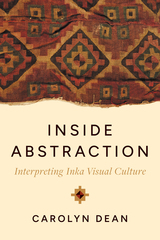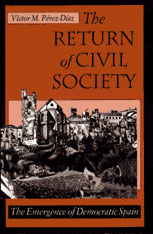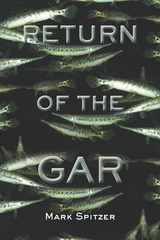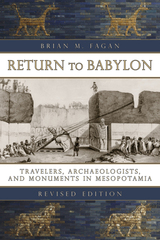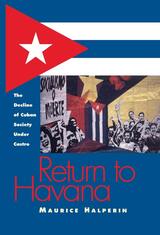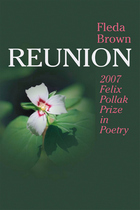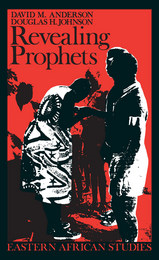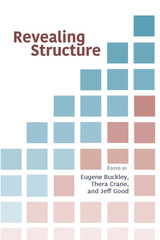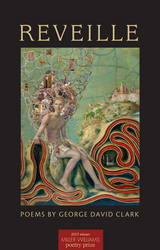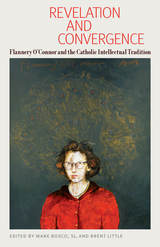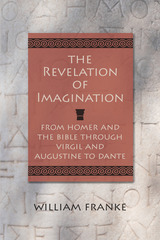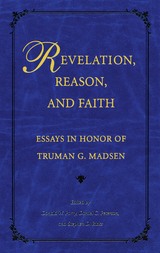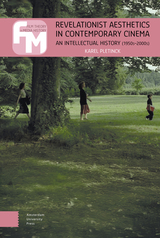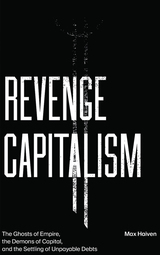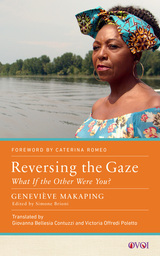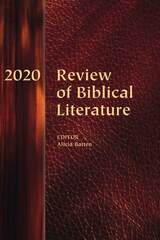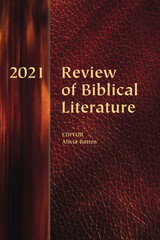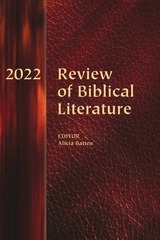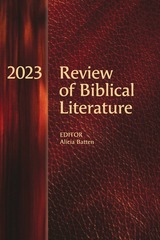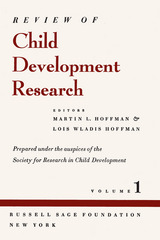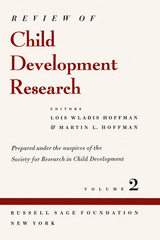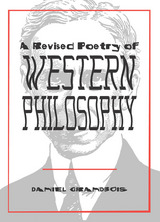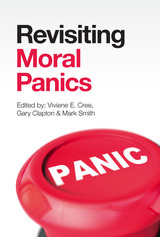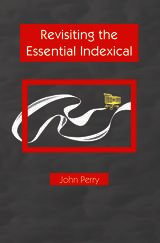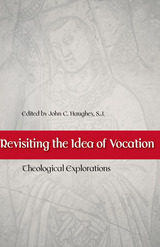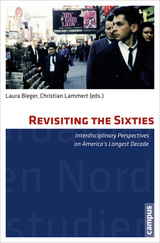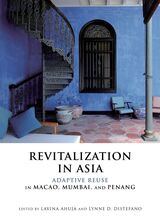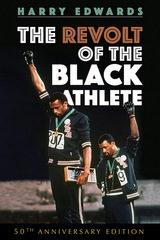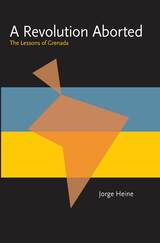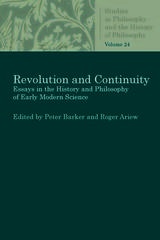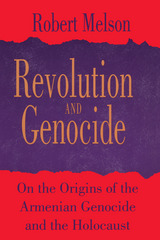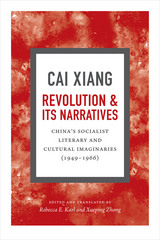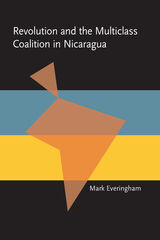 Return from Berlin: The Eye of a Navigator
Robert Grilley
University of Wisconsin Press, 2003 During the summer of 1944, the now-legendary American Eighth Air Force was engaged in a ferocious air battle over Europe to bring the Allies victory over the German Third Reich. This is the story of one B-17 navigator and his crewmates, men who faced extraordinary danger with a maturity beyond their years. This vivid and detailed account of combat flying and its psychological toll also recalls the beginning of Robert Grilley’s development as a painter of international renown, as he spends his off-duty time drawing the peaceful Northamptonshire landscape around Deenethorpe airbase.
Wakened with flashlights on their faces in the predawn hours, he and his crew repeatedly face the Luftwaffe in battles five miles high, flying through flak "so thick you could get out and walk on it." Stretching their stamina to the limits, they succeed time after time in their missions to bomb munitions works, railyards, the Leüna synthetic oil plant at Merseburg in eastern Germany, the V2 rocket research center at Peenemünde on the distant Baltic Coast, and even to strike Hitler’s capital city, Berlin.
But Grilley finds interludes of unexpected grace and restoration on his days off, making serious drawings from nature at the neighboring Yokehill Farm. There he slowly cultivates a friendship with a curious eight-year-old, the lively child Elizabeth, who becomes for the combat flyer a symbol of survival.
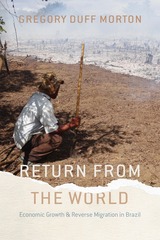 Return from the World: Economic Growth and Reverse Migration in Brazil
Gregory Duff Morton
University of Chicago Press, 2024 An anthropologist’s investigation of why some Brazilians choose to leave behind a booming economy and return to their villages.
In Return from the World, anthropologist Gregory Duff Morton traces the migrations of Brazilian workers who leave a thriving labor market and return to their home villages to become peasant farmers. Morton seeks to understand what it means to turn one’s back deliberately on the promise of economic growth.
Giving up their positions in factories, at construction sites, and as domestic workers, these migrants travel thousands of miles back to villages without running water or dependable power. There, many take up subsistence farming. Some become activists with the MST, Brazil’s militant movement of landless peasants. Bringing their stories vividly to life, Morton dives into the dreams and disputes at play in finding freedom in the shared rejection of growth.
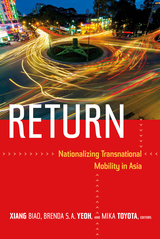 Return: Nationalizing Transnational Mobility in Asia
Xiang Biao, Brenda S. A. Yeoh and Mika Toyota, eds.
Duke University Press, 2013 Since the late 1990s, Asian nations have increasingly encouraged, facilitated, or demanded the return of emigrants. In this interdisciplinary collection, distinguished scholars from countries around the world explore the changing relations between nation-states and transnational mobility. Taking into account illegally trafficked migrants, deportees, temporary laborers on short-term contracts, and highly skilled émigrés, the contributors argue that the figure of the returnee energizes and redefines nationalism in an era of increasingly fluid and indeterminate national sovereignty. They acknowledge the diversity, complexity, and instability of reverse migration, while emphasizing its discursive, policy, and political significance at a moment when the tensions between state power and transnational subjects are particularly visible. Taken together, the essays foreground Asia as a useful site for rethinking the intersections of migration, sovereignty, and nationalism. Contributors. Sylvia Cowan, Johan Lindquist, Melody Chia-wen Lu, Koji Sasaki, Shin Hyunjoon, Mariko Asano Tamanoi, Mika Toyota, Carol Upadhya, Wang Cangbai, Xiang Biao, Brenda S. A. Yeoh
The Return of Civil Society: The Emergence of Democratic Spain
Víctor Pérez-Díaz
Harvard University Press, 1993 Víctor Pérez-Díaz examines the return of civil society in Spain. He covers the transition of Spain from a preindustrial economy, an authoritarian government, and a Roman Catholic-dominated culture to a modern state based on the interaction of economic and class interests, on a market society, on voluntary associations such as trade unions and political parties, and on a culture of moral autonomy and rationality.
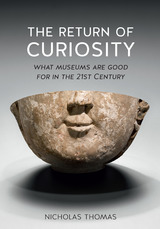 The Return of Curiosity: What Museums are Good For in the 21st Century
Nicholas Thomas
Reaktion Books, 2016 The Spy Museum, the Vacuum Cleaner Museum, the National Mustard Museum—not to mention the Art Institute, the Museum of Modern Art, and the Getty Center: museums have never been more robust, curating just about everything there is and assuming a new prominence in public life. The Return of Curiosity explores museums in the modern age, offering a fresh perspective on some of our most important cultural institutions and the vital function they serve as stewards of human and natural history.
Reflecting on art galleries, science and history institutions, and collections all around the world, Nicholas Thomas argues that, in times marked by incredible insecurity and turbulence, museums help us sustain and enrich society. Moreover, they stimulate us to think in new ways about our world, compelling our curiosity and showing us the importance of understanding one another. Thomas looks at museums not simply as storehouses of old things but as the products of meaningful relationships between curators, the public, history, and culture. These relationships, he shows, don’t always go smoothly, but they do always offer new insights into the many ways we value—and try to preserve—the world we live in.
The result is a refreshing and hopeful look at museums as a cultural force, one that, by gathering together paintings, tropical birds, antiques, or even our own bodies, offers an illuminating reflection of who we are.
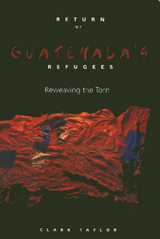 Return Of Guatemala'S Refugees
Clark Taylor
Temple University Press, 1998 On February 13, 1982, the Guatemalan army stormed into the remote northern Guatemalan village of Santa Maria Tzeja. The villagers had already fled in terror, but over the next six days seventeen of them, mostly women and children, were caught and massacred, animals were slaughtered, and the entire village was burned to the ground.
Twelve years later, utilizing terms of refugee agreements reached in 1982, villagers from Santa Maria who had fled to Mexico returned to their homes and lands to re-create their community with those who had stayed in Guatemala. Return of Guatemala's Refugees tells the story of that process. In this moving and provocative book, Clark Taylor describes the experiences of the survivors -- both those who stayed behind in conditions of savage repression and those who fled to Mexico where they learned to organize and defend their rights. Their struggle to rebuild is set in the wider drama of efforts by grassroots groups to pressure the government, economic elites, and army to fulfill peace accords signed in December of 1996.
Focusing on the village of Santa Maria Tzeja, Taylor defines the challenges that faced returning refugees and their community. How did the opposing subcultures of fear (generated among those who stayed in Guatemala) and of education and human rights (experienced by those who took refuge in Mexico) coexist? Would the flood of international money sent to settle the refugees and fulfill the peace accords serve to promote participatory development or new forms of social control? How did survivors expand the space for democracy firmly grounded in human rights? How did they get beyond the grief and trauma that remained from the terror of the early eighties? Finally, the ultimate challenge, how did they work within conditions of extreme poverty to create a grassroots democracy in a militarized society?
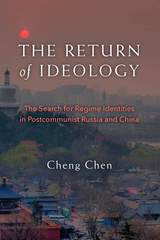 The Return of Ideology: The Search for Regime Identities in Postcommunist Russia and China
Cheng Chen
University of Michigan Press, 2016 As a nation makes the transition from communism to democracy or another form of authoritarianism, its regime must construct not only new political institutions, but also a new political ideology that can guide policy and provide a sense of mission. The new ideology is crucial for legitimacy at home and abroad, as well as the regime’s long-term viability. In The Return of Ideology, Cheng Chen compares post-communist regimes, with a focus on Russia under Putin and post-Deng China, investigating the factors that affect the success of an ideology-building project and identifies the implications for international affairs.
Successful ideology-building requires two necessary—but not sufficient—conditions. The regime must establish a coherent ideological repertoire that takes into account the nation’s ideological heritage and fresh surges of nationalism. Also, the regime must attract and maintain a strong commitment to the emerging ideology among the political elite.
Drawing on rich primary sources, including interviews, surveys, political speeches, writings of political leaders, and a variety of publications, Chen identifies the major obstacles to ideology-building in modern Russia and China and assesses their respective long-term prospects. Whereas creating a new regime ideology has been a protracted and difficult process in China, it has been even more so in Russia. The ability to forge an ideology is not merely a domestic concern for these two nations, but a matter of international import as these two great powers move to assert and extend their influence in the world.
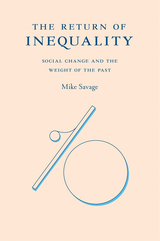 The Return of Inequality: Social Change and the Weight of the Past
Mike Savage
Harvard University Press, 2021 A pioneering book that takes us beyond economic debate to show how inequality is returning us to a past dominated by empires, dynastic elites, and ethnic divisions.
The economic facts of inequality are clear. The rich have been pulling away from the rest of us for years, and the super-rich have been pulling away from the rich. More and more assets are concentrated in fewer and fewer hands. Mainstream economists say we need not worry; what matters is growth, not distribution. In The Return of Inequality, acclaimed sociologist Mike Savage pushes back, explaining inequality’s profound deleterious effects on the shape of societies.
Savage shows how economic inequality aggravates cultural, social, and political conflicts, challenging the coherence of liberal democratic nation-states. Put simply, severe inequality returns us to the past. By fracturing social bonds and harnessing the democratic process to the strategies of a resurgent aristocracy of the wealthy, inequality revives political conditions we thought we had moved beyond: empires and dynastic elites, explosive ethnic division, and metropolitan dominance that consigns all but a few cities to irrelevance. Inequality, in short, threatens to return us to the very history we have been trying to escape since the Age of Revolution.
Westerners have been slow to appreciate that inequality undermines the very foundations of liberal democracy: faith in progress and trust in the political community’s concern for all its members. Savage guides us through the ideas of leading theorists of inequality, including Marx, Bourdieu, and Piketty, revealing how inequality reimposes the burdens of the past. At once analytically rigorous and passionately argued, The Return of Inequality is a vital addition to one of our most important public debates.
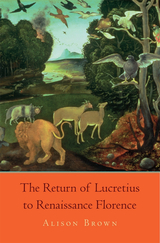 The Return of Lucretius to Renaissance Florence
Alison Brown
Harvard University Press, 2010 In this first comprehensive study of the effect of Lucretius's De rerum natura on Florentine thought in the Renaissance, Alison Brown demonstrates how Lucretius was used by Florentine thinkers—earlier and more widely than has been supposed—to provide a radical critique of prevailing orthodoxies.
To answer the question of why ordinary Florentines were drawn to this recently discovered text, despite its threat to orthodox Christian belief, Brown tracks interest in it through three humanists—the most famous of whom was Machiavelli—all working not as philologists but as practical administrators and teachers in the Florentine chancery and university. Interpreting their direct use of Lucretius within the context of mercantile Florence, Brown highlights three dangerous themes that had particular appeal: Lucretius's attack on superstitious religion and an afterlife; his pre-Darwinian theory of evolution; and his atomism, with its theory of free will and the chance creation of the world.
The humanists' challenge to established beliefs encouraged the growth of a "Lucretian network" of younger, politically disaffected Florentines. Brown thus adds a missing dimension to our understanding of the "revolution" in sixteenth-century political thinking, as she enriches our definition of the Renaissance in a context of newly discovered worlds and new social networks.
 The Return of Martin Guerre
Natalie Zemon Davis
Harvard University Press, 1983 The clever peasant Arnaud du Tilh had almost persuaded the learned judges at the Parlement of Toulouse when, on a summer’s day in 1560, a man swaggered into the court on a wooden leg, denounced Arnaud, and reestablished his claim to the identity, property, and wife of Martin Guerre. The astonishing case captured the imagination of the continent. Told and retold over the centuries, the story of Martin Guerre became a legend, still remembered in the Pyrenean village where the impostor was executed more than 400 years ago.
Now a noted historian, who served as consultant for a new French film on Martin Guerre, has searched archives and lawbooks to add new dimensions to a tale already abundant in mysteries: we are led to ponder how a common man could become an impostor in the sixteenth century, why Bertrande de Rols, an honorable peasant woman, would accept such a man as her husband, and why lawyers, poets, and men of letters like Montaigne became so fascinated with the episode.
Natalie Zemon Davis reconstructs the lives of ordinary people, in a sparkling way that reveals the hidden attachments and sensibilities of nonliterate sixteenth-century villagers. Here we see men and women trying to fashion their identities within a world of traditional ideas about property and family and of changing ideas about religion. We learn what happens when common people get involved in the workings of the criminal courts in the ancien régime, and how judges struggle to decide who a man was in the days before fingerprints and photographs. We sense the secret affinity between the eloquent men of law and the honey-tongued village impostor, a rare identification across class lines.
Deftly written to please both the general public and specialists, The Return of Martin Guerre will interest those who want to know more about ordinary families and especially women of the past, and about the creation of literary legends. It is also a remarkable psychological narrative about where self-fashioning stops and lying begins.
The Return of Philip Latinowicz
Miroslav Krleza
Northwestern University Press, 1995 Philip Latinowicz is a successful but disillusioned painter who returns to his hometown after an absence of twenty-three years. He hopes that revisiting his roots will inspire him to create the perfect work of art and thereby restore his faith in both art and life. Haunted by his troubled childhood, however, he falls in with shady characters and discovers the emotional, intellectual, and imaginative poverty of his own background.
The first and most enduring work by preeminent Croatian writer Miroslav Krleza, The Return of Philip Latinowicz was highly praised by Jean-Paul Sartre.
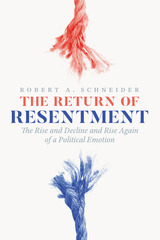 The Return of Resentment: The Rise and Decline and Rise Again of a Political Emotion
Robert A. Schneider
University of Chicago Press, 2023 Charts the long history of resentment, from its emergence to its establishment as the word of the moment.
The term “resentment,” often casually paired with words like “hatred,” “rage,” and “fear,” has dominated US news analysis since November 2016. Despite its increased use, this word seems to defy easy categorization. Does “resentment” describe many interlocking sentiments, or is it just another way of saying “anger”? Does it suggest an irrational grievance, as opposed to a legitimate callout of injustice? Does it imply political leanings, or is it nonpartisan by nature?
In The Return of Resentment, Robert A. Schneider explores these questions and more, moving from eighteenth-century Britain to the aftermath of the French Revolution to social movements throughout the twentieth century. Drawing on a wide range of writers, thinkers, and historical experiences, Schneider illustrates how resentment has morphed across time, coming to express a collective sentiment felt by people and movements across the political spectrum. In this history, we discover resentment’s modernity and its ambiguity—how it can be used to dismiss legitimate critique and explain away violence, but also convey a moral stance that demands recognition. Schneider anatomizes the many ways resentment has been used to label present-day movements, from followers of Trump and supporters of Brexit to radical Islamicists and proponents of identity politics. Addressing our contemporary political situation in a novel way, The Return of Resentment challenges us to think critically about the roles different emotions play in politics.
The Return of the Contemporary: The Latin American Novel in the End Times
Ncolas Campisi
University of Pittsburgh Press, 2024 In The Return of the Contemporary, Nicolás Campisi combines the fields of post-dictatorship studies and environmental humanities to analyze Latin American cultural production in the neoliberal age. Each chapter pairs two authors from different parts of Latin America and the Caribbean who create a common vocabulary in which to frame the various crises of the region’s present and recent past, such as climate change, forced migration, the collapse of state institutions, and the afterlives of slavery. By situating itself at the intersection of ecocritical and environmental humanities, affect studies, and the politics of memory and postmemory, Campisi presents new comparative methods to show how Latin America’s neoliberal crisis prompted significant changes in how the novel as a form imagines a different future.
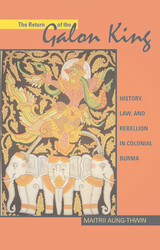 The Return of the Galon King: History, Law, and Rebellion in Colonial Burma
Maitrii Aung-Thwin
Ohio University Press, 2010 In late 1930, on a secluded mountain overlooking the rural paddy fields of British Burma, a peasant leader named Saya San crowned himself King and inaugurated a series of uprisings that would later erupt into one of the largest anti-colonial rebellions in Southeast Asian history. Considered an imposter by the British, a hero by nationalists, and a prophet-king by area-studies specialists, Saya San came to embody traditional Southeast Asia’s encounter with European colonialism in his attempt to resurrect the lost throne of Burma. The Return of the Galon King analyzes the legal origins of the Saya San story and reconsiders the facts upon which the basic narrative and interpretations of the rebellion are based. Aung-Thwin reveals how counter-insurgency law produced and criminalized Burmese culture, contributing to the way peasant resistance was recorded in the archives and understood by Southeast Asian scholars. This interdisciplinary study reveals how colonial anthropologists, lawyers, and scholar-administrators produced interpretations of Burmese culture that influenced contemporary notions of Southeast Asian resistance and protest. It provides a fascinating case study of how history is treated by the law, how history emerges in legal decisions, and how the authority of the past is used to validate legal findings.
 The Return of the Mexican Gray Wolf: Back to the Blue
Bobbie Holaday
University of Arizona Press, 2003 The return of the Mexican gray wolf to Arizona's Blue Range in 1998 marked more than a victory for an endangered species. Long hated by ranchers, the gray wolf had been hunted to the brink of extinction until one woman took on the challenge of restoring it to its natural habitat. Inspired by the plight of the Mexican gray wolf, retiree Bobbie Holaday formed the citizens advocacy group Preserve Arizona's Wolves (P.A.WS.) in 1987 and embarked on a crusade to raise public awareness. She soon found herself in the center of a firestorm of controversy, with environmentalists taking sides against ranchers and neighbors against neighbors. This book tells her story for the first time, documenting her eleven-year effort to bring the gray wolf back to the Blue. As Holaday quickly learned, ranchers exerted considerable control over the state legislature, and politicians in turn controlled decisions made by wildlife agencies. Even though the wolf had been listed as endangered since 1976, opposition to it was so strong that the Arizona Game and Fish Department had been unable to launch a recovery program. In The Return of the Mexican Gray Wolf, Holaday describes first-hand the tactics she and other ordinary citizens on the Mexican Wolf Recovery Team adopted to confront these obstacles. Enhanced with more than 40 photographs—32 in color—her account chronicles both the triumphs of reintroduction and the heartbreaking tragedies the wolves encountered during early phases. Thanks to Holaday's perseverance, eleven wolves were released into the wild in 1998, and the Blue Range once again echoed with their howls. Her tenacity was an inspiration to all those she enlisted in the cause, and her story is a virtual primer for conservation activists on mobilizing at the grassroots level. The Return of the Mexican Gray Wolf shows that one person can make a difference in a seemingly hopeless cause and will engage all readers concerned with the preservation of wildlife. All royalties go to the Mexican Wolf Trust Fund administered by the Arizona Game and Fish Department.
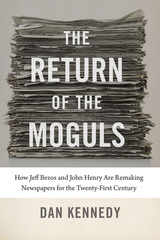 The Return of the Moguls: How Jeff Bezos and John Henry Are Remaking Newspapers for the Twenty-First Century
Dan Kennedy
University Press of New England, 2018 The Return of the Moguls chronicles an important story in the making, one that will affect more than just the newspaper business—it has the power to change democracy as we know it. Over the course of a generation, the story of the daily newspaper has been an unchecked slide from record profitability and readership to plummeting profits, increasing irrelevance, and inevitable obsolescence. The forces killing major dailies, alternative weeklies, and small-town shoppers are well understood—or seem obvious in hindsight, at least—and the catalog of publications that have gone under reads like a who’s who of American journalism. During the past half-century, old-style press barons gave way to a cabal of corporate interests unable or unwilling to invest in the future even as technological change was destroying their core business. The Taylor family sold the Boston Globe to the New York Times Company in 1993 for a cool $1.1 billion. Twenty years later, the Times Company resold it for just $70 million. The unexpected twist to the story, however, is not what they sold it for but who they sold it to: John Henry, the principal owner of the Boston Red Sox. A billionaire who made his money in the world of high finance, Henry inspired optimism in Boston because of his track record as a public-spirited business executive—and because his deep pockets seemed to ensure that the shrunken newspaper would not be subjected to further downsizing. In just a few days, the sale of the Globe was overtaken by much bigger news: Jeff Bezos, the founder of Amazon and one of the world’s richest people, had reached a deal to buy the Washington Post for $250 million. Henry’s ascension at the Globe sparked hope. Bezos’s purchase seemed to inspire nothing short of ecstasy, as numerous observers expressed the belief that his lofty status as one of our leading digital visionaries could help him solve the daunting financial problems facing the newspaper business. Though Bezos and Henry are the two most prominent individuals to enter the newspaper business, a third preceded them. Aaron Kushner, a greeting-card executive, acquired California’s Orange County Register in July 2012 and then pursued an audacious agenda, expanding coverage and hiring journalists in an era when nearly all other newspaper owners were trying to avoid cutting both. The newspaper business is at a perilous crossroads. This essential book explains why, and how today’s new crop of media moguls might help it to survive.
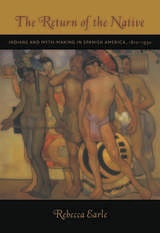 The Return of the Native: Indians and Myth-Making in Spanish America, 1810–1930
Rebecca Earle
Duke University Press, 2007 Why does Argentina’s national anthem describe its citizens as sons of the Inca? Why did patriots in nineteenth-century Chile name a battleship after the Aztec emperor Montezuma? Answers to both questions lie in the tangled knot of ideas that constituted the creole imagination in nineteenth-century Spanish America. Rebecca Earle examines the place of preconquest peoples such as the Aztecs and the Incas within the sense of identity—both personal and national—expressed by Spanish American elites in the first century after independence, a time of intense focus on nation-building. Starting with the anti-Spanish wars of independence in the early nineteenth century, Earle charts the changing importance elite nationalists ascribed to the pre-Columbian past through an analysis of a wide range of sources, including historical writings, poems and novels, postage stamps, constitutions, and public sculpture. This eclectic archive illuminates the nationalist vision of creole elites throughout Spanish America, who in different ways sought to construct meaningful national myths and histories. Traces of these efforts are scattered across nineteenth-century culture; Earle maps the significance of those traces. She also underlines the similarities in the development of nineteenth-century elite nationalism across Spanish America. By offering a comparative study focused on Mexico, Guatemala, Colombia, Peru, Chile, and Ecuador, The Return of the Native illustrates both the common features of elite nation-building and some of the significant variations. The book ends with a consideration of the pro-indigenous indigenista movements that developed in various parts of Spanish America in the early twentieth century.
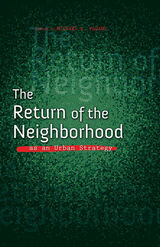 The Return of the Neighborhood as an Urban Strategy
Edited by Michael A. Pagano
University of Illinois Press, 2015 In this new volume, Michael A. Pagano curates essays focusing on the neighborhood's role in urban policy solutions. The papers emerged from dynamic discussions among policy makers, researchers, public intellectuals, and citizens at the 2014 UIC Urban Forum. As the writers show, the greater the city, the more important its neighborhoods and their distinctions. The topics focus on sustainable capital and societal investments in people and firms at the neighborhood level. Proposed solutions cover a range of possibilities for enhancing the quality of life for individuals, households, and neighborhoods. These include everything from microenterprises to factories; from social spaces for collective and social action to private facilities; from affordable housing and safety to gated communities; and from neighborhood public education to cooperative, charter, and private schools. Contributors: Andy Clarno, Teresa Córdova, Nilda Flores-González, Pedro A. Noguera, Alice O'Connor, Mary Pattillo, Janet Smith, Nik Theodore, Elizabeth S. Todd-Breland, Stephanie Truchan, and Rachel Weber.
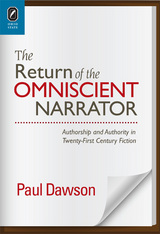 The Return of the Omniscient Narrator: Authorship and Authority in Twenty-First Century Fiction
Paul Dawson
Ohio State University Press, 2013 The Return of the Omniscient Narrator: Authorship and Authority in Twenty-First Century Fiction by Paul Dawson argues that the omniscient narrator, long considered a relic of the eighteenth- and nineteenth-century novel, has reemerged as an important feature of contemporary British and American literary fiction. It further argues that the development of contemporary omniscience can be situated in relation to ongoing anxieties about the novel’s decline of cultural authority in the age of digital media. In this context the book identifies and classifies new modes of omniscient narration that are neither nostalgic revivals nor parodic critiques of classic omniscience, but the result of experimentations with narrative voice in the wake of postmodern fiction.
To address this phenomenon, the book reformulates existing definitions of literary omniscience, shifting attention away from questions of narratorial knowledge and toward omniscient narration as a rhetorical performance of narrative authority that invokes and projects a historically specific figure of authorship. Through a study of fiction by authors such as Zadie Smith, Jonathan Franzen, Richard Powers, Martin Amis, Rick Moody, Edward P. Jones, and Nicola Barker, the book analyzes how the conventional narrative authority of omniscient narrators is parlayed into claims for the cultural authority of authors and of the novel itself.
In the course of its investigation, The Return of the Omniscient Narrator engages with major movements in narrative theory—rhetorical, cognitive, and feminist—to challenge and reconsider many key narratological categories, including Free Indirect Discourse, the relation between voice and focalization, and the narrative communication model. This challenge is framed by an argument for a discursive approach to narrative fiction that addresses the neglect of authorship in narrative theory.
 Return of the Wild: The Future Of Our National Lands
Edited by Ted Kerasote
Island Press, 2001 As individuals and as a nation we believe that if we recycle and buy fuel-efficient cars we have done our part to protect the environment. Yet an important element is missing. If we don't conserve the still-undeveloped places of the earth, human life will be disconnected from its fellow animals and torn from its roots. Humans will still exist, but as Ted Kerasote explains in his insightful introduction, "we'll be like potted trees in the foyers of great skyscrapers -- alone and not part of a wider forest."Our efforts to recycle and conserve energy must be augmented with advocacy for the protection of wild spaces, and Return of the Wild is an important underpinning for that endeavor: a guide through the issues of the day, a history, a forum for debate, a source of information. Sponsored by the Pew Wilderness Center, the book brings together leading thinkers and writers to examine why nature in its most untrammeled state is vitally important to all of us; what currently threatens wild country; and what can be done not merely to conserve more of it, but also to return it to our lives and consciousness.Contributors including Vine Deloria, Jr., Chris Madson, Mike Matz, Richard Nelson, Thomas M. Power, Michael Soule, Jack Turner, and Florence Williams consider a wide range of topics relating to wildlands, and explore the varied economic, spiritual, and ecological justifications for preserving wilderness areas. The book also features a completely new four-color mapping of the remaining roadless areas on federal lands, as well as the National Wilderness Preservation System, now measuring 106 million acres, in which much of this roadless land could one day be included.This first annual edition is both an inspiring and thoughtful introduction to wilderness subjects for the general public and an invaluable reference for legislators, the media, and conservation organizations. It is an essential new contribution to wilderness preservation efforts.
 The Return of Thematic Criticism
Werner Sollors
Harvard University Press, 1993 In the glory days of high modernist formalism it was anathema to speak about the content of a work of art. Those days are gone, and critical practice now is largely thematic practice. A focus on the themes of literature informs feminist, new historicist, ethnic, and even second-generation deconstructionist approaches. However, such practice is not always recognized. The specter of theoretically impoverished positivism still haunts thematic analysis, making it the approach to literature that dare not speak its name. This volume brings together for the first time an international group of writers, critics, and theoreticians who have thought deeply about this issue.
How can we determine the theme of a given text? May the focus on form be the theme of a certain moment? Can the motif be understood as a formal category? What operations permit us to say that three or four texts constitute variants of the same theme? The contributors challenge the conventional dismissal of “merely” thematic approaches and offer the reader different ways of tackling the issue of what a piece of writing is “about.”
The work here comes out of such diverse intellectual traditions as Russian film theory, French phenomenology, Foucault, narratology, the Frankfurt School, intellectual history (Geistesgeschichte), psychoanalytic criticism, linguistics, ideological criticism, Proppian folklore studies, and computerized plot summary models. In addition to a collection of aphorisms from Plato to Robert Coover and a group of general and theoretical essays, this volume contains examples of practical engagement with such topics as literary history, Shakespeare, autumn poetry, anti-Semitism, fading colors, bachelors, Richard Wagner, and the Mexican Revolution. No comparable volume exists.
 The Return of "Twin Peaks": Squaring the Circle
Franck Boulègue
Intellect Books, 2022 In 2017, twenty-five years after its initial release, a new season of Mark Frost and David Lynch’s cultural touchstone Twin Peaks shook the world of television. In this volume, Franck Boulègue explores Twin Peaks: The Return through a philosophical, mythological, and spiritual lens.
Divided into three sections, the book first examines the third season as expanded storytelling through the lens of Gene Youngblood's theory of synesthetic cinema, intertextuality, integrationist, and segregationist approaches in the realm of fiction, and focuses on the role of audio and visual superimpositions in The Return. It goes on to question the nature of the reality depicted in the seasons via scientific approaches, such as electromagnetism, time theory, and multiverses. The third and final section aims to transcend this vision by exploring the role of theosophy, the occult, and other spiritual sources. With a foreword by Matt Zoller Seitz, editor at large at RogerEbert.com and television critic for New York magazine, this book is essential reading for fans of the landmark show and anyone who studies it.
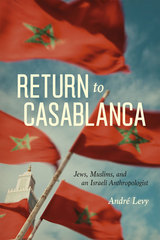 Return to Casablanca: Jews, Muslims, and an Israeli Anthropologist
André Levy
University of Chicago Press, 2015 In this book, Israeli anthropologist André Levy returns to his birthplace in Casablanca to provide a deeply nuanced and compelling study of the relationships between Moroccan Jews and Muslims there. Ranging over a century of history—from the Jewish Enlightenment and the impending colonialism of the late nineteenth century to today’s modern Arab state—Levy paints a rich portrait of two communities pressed together, of the tremendous mobility that has characterized the past century, and of the paradoxes that complicate the cultural identities of the present.
Levy visits a host of sites and historical figures to assemble a compelling history of social change, while seamlessly interweaving his study with personal accounts of his returns to his homeland. Central to this story is the massive migration of Jews out of Morocco. Levy traces the institutional and social changes such migrations cause for those who choose to stay, introducing the concept of “contraction” to depict the way Jews deal with the ramifications of their demographic dwindling. Turning his attention outward from Morocco, he goes on to explore the greater complexities of the Jewish diaspora and the essential paradox at the heart of his adventure—leaving Israel to return home.
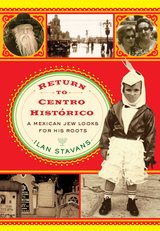 Return to Centro Histórico: A Mexican Jew Looks for His Roots
Stavans, Ilan
Rutgers University Press, 2012 After a stirring e-mail exchange with his father, awardwinning essayist and cultural commentator Ilan Stavans decided to do something bizarre: revisit his hometown, Mexico City, accompanied by a tourist guide. But rather than seeking his roots in the neighborhood where he grew up, he headed to the Centro Histórico, the downtown area at the heart of the world’s largest metropolis. It was there that conversos, the hidden Jews escaping the might of the Holy Office of the Inquisition, were burned at the stake. And, centuries later, it was the same section where Jewish immigrants, both Yiddish-speaking Ashkenazim and Sephardim from the Ottoman Empire, made their homes as peddlers. In a sense, Centro Histórico is to Mexico what the Lower East Side is to the United States: a platform for reinventing one’s self in the New World. With the same linguistic verve and insight that has made him one of the most distinguished voices in American literature today, Ilan Stavans invites readers along for a personal journey that is not only his own, but that of an entire culture. In Return to Centro Histórico he makes it possible to understand the intimate role that Jews have played in the development of Hispanic civilization.
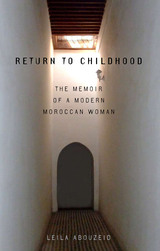 Return to Childhood: The Memoir of a Modern Moroccan Woman
By Leila Abouzeid
University of Texas Press, 1998 Leila Abouzeid, whose novel Year of the Elephant has gone through six reprintings, has now translated her childhood memoir into English. Published in Rabat in 1993 to critical acclaim, the work brings to life the interlocking dramas of family ties and political conflict. Against a background of Morocco's struggle for independence from French colonial rule, Abouzeid charts the development of personal relationships, between generations as well as between husbands and wives. Abouzeid's father is a central figure; as a strong advocate of Moroccan nationalism, he was frequently imprisoned by the French and his family forced to flee the capital. Si Hmed was a public hero, but the young daughter's memories of her famous father and of the family's plight because of his political activities are not so idyllic. The memoir utilizes multiple voices, especially those of women, in a manner reminiscent of the narrative strategies of the oral tradition in Moroccan culture. Return to Childhood may also be classified as an autobiography, a form only now gaining respect as a valid literary genre in the Middle East. Abouzeid's own introduction and Elizabeth Fernea's foreword discuss this new development in Arabic literature.
Return to Havana: The Decline of Cuban Society Under Castro
Maurice Halperin
Vanderbilt University Press, 1994 An insightful personal memoir that contrasts firsthand the dream of the Cuban Revolution as it was in the early 1960s with the deprivations, hardships, and loss of hope that haunt Cuban society today.
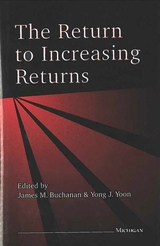 The Return to Increasing Returns
James M. Buchanan and Yong J. Yoon, Editors
University of Michigan Press, 1994 The wealth of a nation depends on the division of labor, and the division of labor depends on the extent of the market. Adam Smith advanced this proposition in 1776, but neoclassical economists, in particular, have had difficulty incorporating it into conversational models. Increasing returns, as related to the size of the market nexus, have never found a secure place in economic theory, despite early efforts by Adam Smith, Alfred Marshall, and Allyn Young.
The neoclassical theory of distribution, developed in the last decades of the nineteenth century, relies on the postulate that in equilibrium there exist constant returns to scale, not only in particular firms and industries, but in the economy as a whole. As general equilibrium theory developed, emphasis was sifted to the properties of equilibrium, to the proofs of its existence, and to the attributes of welfare. The possibility of increasing returns represented an analytical “monkey wrench” thrown in the whole neoclassical structure. Thus, the neglect of increasing returns may have been methodologically understandable – if scientifically scandalous. Only in recent years has the increasing returns postulate returned to the mainstream through analyses of endogenous growth, international trade, unemployment, and the economics of ethics.
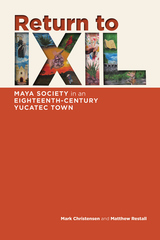 Return to Ixil: Maya Society in an Eighteenth-Century Yucatec Town
Mark Z. Christensen
University Press of Colorado, 2019 Return to Ixil is an examination of over 100 colonial-era Maya wills from the Yucatec town of Ixil, presented together and studied fully for the first time. These testaments make up the most significant corpus of Maya-language documents from the colonial period. Offering an unprecedented picture of material and spiritual life in Ixil from 1738 to 1779, they are rare and rich sources for the study of Maya culture and history.
Supplemented with additional archival research, the wills provide new and detailed descriptions of various aspects of life in eighteenth-century Ixil. In each chapter, authors Mark Christensen and Matthew Restall examine a different dimension of Ixil’s colonial history, including the role of notaries, Maya participation in a coastal militia, economy and modes of production, religious life and records, and the structures and patterns of familial relationships. These details offer insight into the complex network of societies in colonial Yucatan, colonial Mesoamerica, and colonial Latin America.
Including an appendix presenting the original Maya texts as well as translations by Christensen and Restall, Return to Ixil not only analyzes the largest body of substantive wills in any Mayan language known today but also provides a rare closeup view of the inner workings of a colonial Maya town and the communal and familial affairs that made up a large part of the Maya colonial experience. It will be of great interest to Mayanists as well as to students and scholars of history, anthropology, ethnohistory, linguistics, and social history.
The publication of this book is supported in part byBrigham Young University and Penn State University.
 The Return to Keynes
Bradley W. Bateman
Harvard University Press, 2010 Keynesian economics, which proposed that the government could use monetary and fiscal policy to help the economy avoid the extremes of recession and inflation, held sway for thirty years after World War II. However, it was discredited after the stagflation of the 1970s, which not only proved resistant to traditional Keynesian policies but was actually thought to be caused by them. By the 1990s, the anti-Keynesian counter-revolution seemed to reach its pinnacle with the award of several Nobel Prizes in economics to its architects at the University of Chicago.
However, with the collapse of the dot-com boom in 2000 and the attacks of 9/11 a year later, the nature of macroeconomic policy debate took a turn. The collapse prompted a major shift in macroeconomic policy, as the Bush administration and other governments around the world began to resort to Keynesian measures—both monetary and fiscal policies—to stabilize the economy. The Keynesian rebirth has been most dramatically illustrated during the past year when central banks have pumped billions of dollars of liquidity into the world’s financial system to address the crises of confidence, illiquidity, and insolvency that were triggered by the sub-prime lending crisis. The Return to Keynes puts Keynesian economics in a fresh perspective in order to assess this surprising new era in economic policy making.
 Return to Nisa
Marjorie Shostak
Harvard University Press, 2000 The story of two women—one a hunter-gatherer in Botswana, the other an ailing American anthropologist—this powerful book returns the reader to territory that Marjorie Shostak wrote of so poignantly in the now classic Nisa: The Life and Words of a !Kung Woman. Here, however, the ground has perceptibly shifted. First published in 1981, Nisa served as a stirring introduction to anthropology’s most basic question: Can there be true understanding between people of profoundly different cultures?Diagnosed with breast cancer, and troubled by a sense of work yet unfinished, Shostak returned to Botswana in 1989. This book tells simply and directly of her rediscovery of the !Kung people she had come to know years before—the aging, blunt, demanding Nisa, her stalwart husband Bo, understanding Kxoma, fragile Hwantla, and Royal, translator and guide. In Shostak’s words, we clearly see !Kung life, the dry grasslands, the healing dances, the threatening military presence. And we see Shostak herself, passionately curious, reporting the discomforts and confusion of fieldwork along with its fascination. By turns amused and frustrated, she describes the disappointments—and chastening lessons—that inevitably follow when anthropologists (like her younger self) romanticize the !Kung.Throughout, we observe a woman of threatened health but enormous vitality as she pursues the promise she once discovered in the !Kung people and, above all, in Nisa. At the core of the book is the remarkable relationship between these two women from different worlds. They are often caught off guard by the limits of their mutual understanding. Still, their determination to reach out to each other lingers in the reader’s mind long after the story ends—providing an eloquent response to questions that Nisa so memorably posed.
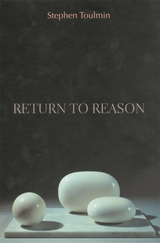 Return to Reason
Stephen Toulmin
Harvard University Press, 2003 The turmoil and brutality of the twentieth century have made it increasingly difficult to maintain faith in the ability of reason to fashion a stable and peaceful world. After the ravages of global conflict and a Cold War that divided the world's loyalties, how are we to master our doubts and face the twenty-first century with hope?
In Return to Reason, Stephen Toulmin argues that the potential for reason to improve our lives has been hampered by a serious imbalance in our pursuit of knowledge. The centuries-old dominance of rationality, a mathematical mode of reasoning modeled on theory and universal certainties, has diminished the value of reasonableness, a system of humane judgments based on personal experience and practice. To this day, academic disciplines such as economics and professions such as law and medicine often value expert knowledge and abstract models above the testimony of diverse cultures and the practical experience of individuals.
Now, at the beginning of a new century, Toulmin sums up a lifetime of distinguished work and issues a powerful call to redress the balance between rationality and reasonableness. His vision does not reject the valuable fruits of science and technology, but requires awareness of the human consequences of our discoveries. Toulmin argues for the need to confront the challenge of an uncertain and unpredictable world, not with inflexible ideologies and abstract theories, but by returning to a more humane and compassionate form of reason, one that accepts the diversity and complexity that is human nature as an essential beginning for all intellectual inquiry.
 A Return to Servitude: Maya Migration and the Tourist Trade in Cancún
M. Bianet Castellanos
University of Minnesota Press, 2010 As a free trade zone and Latin America's most popular destination, Cancún, Mexico, is more than just a tourist town. It is not only actively involved in the production of transnational capital but also forms an integral part of the state's modernization plan for rural, indigenous communities. Indeed, Maya migrants make up over a third of the city's population.
A Return to Servitude is an ethnography of Maya migration within Mexico that analyzes the foundational role indigenous peoples play in the development of the modern nation-state. Focusing on tourism in the Yucatán Peninsula, M. Bianet Castellanos examines how Cancún came to be equated with modernity, how this city has shaped the political economy of the peninsula, and how indigenous communities engage with this vision of contemporary life. More broadly, she demonstrates how indigenous communities experience, resist, and accommodate themselves to transnational capitalism.
Tourism and the social stratification that results from migration have created conflict among the Maya. At the same time, this work asserts, it is through engagement with modernity and its resources that they are able to maintain their sense of indigeneity and community.
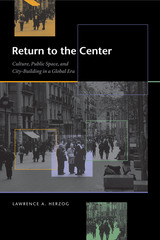 Return to the Center: Culture, Public Space, and City Building in a Global Era
By Lawrence A. Herzog
University of Texas Press, 2006 The redesign and revitalization of traditional urban centers is the cutting edge of contemporary urban planning, as evidenced by the intense public and professional attention to the rebuilding of city cores from Berlin to New York City's "Ground Zero." Spanish and Latin American cities have never received the recognition they deserve in the urban revitalization debate, yet they offer a very relevant model for this "return to the center." These cultures have consistently embraced the notion of a city whose identity is grounded in its organic public spaces: plazas, promenades, commercial streets, and parks that invite pedestrian traffic and support a rich civic life. This groundbreaking book explores Spanish, Mexican, and Mexican-American border cities to learn what these urban areas can teach us about effectively using central public spaces to foster civic interaction, neighborhood identity, and a sense of place. Herzog weaves the book around case studies of Madrid and Barcelona, Spain; Mexico City and Querétaro, Mexico; and the Tijuana-San Diego border metropolis. He examines how each of these urban areas was formed and grew through time, with attention to the design lessons of key public spaces. The book offers original and incisive discussions that challenge current urban thinking about politics and public space, globalization, and the future of privatized communities, from gated suburbs to cyberspace. Herzog argues that well-designed, human-scaled city centers are still vitally necessary for maintaining community and civic life. Applicable to urban renewal projects around the globe, Herzog's book will be important reading for planners, architects, designers, and all citizens interested in creating more livable cities.
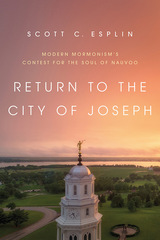 Return to the City of Joseph: Modern Mormonism's Contest for the Soul of Nauvoo
Scott C. Esplin
University of Illinois Press, 2018 In the mid-twentieth century, the Church of Jesus Christ of Latter-day Saints (LDS) returned to Nauvoo, Illinois, home to the thriving religious community led by Joseph Smith before his murder in 1844. The quiet farm town became a major Mormon heritage site visited annually by tens of thousands of people. Yet Nauvoo's dramatic restoration proved fraught with conflicts. Scott C. Esplin's social history looks at how Nauvoo's different groups have sparred over heritage and historical memory. The Latter-day Saint project brought it into conflict with the Community of Christ, the Midwestern branch of Mormonism that had kept a foothold in the town and a claim on its Smith-related sites. Non-Mormon locals, meanwhile, sought to maintain the historic place of ancestors who had settled in Nauvoo after the Latter-day Saints' departure. Examining the recent and present-day struggles to define the town, Esplin probes the values of the local groups while placing Nauvoo at the center of Mormonism's attempt to carve a role for itself within the greater narrative of American history.
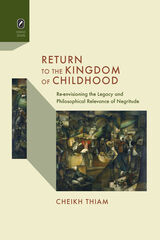 Return to the Kingdom of Childhood: Re-envisioning the Legacy and Philosophical Relevance of Negritude
Cheikh Thiam
Ohio State University Press, 2014 Return to the Kingdom of Childhood: Re-envisioning the Legacy and Philosophical Relevance of Negritude examines the philosophy of Negritude through an innovative analysis of Léopold Sédar Senghor’s oeuvre. In the first book-length study of Senghorian philosophy, Cheikh Thiam argues that Senghor’s work expresses an Afri-centered conception of the human while simultaneously offering a critique of the Western universalization of “man.” Senghor’s corrective, descriptive, and prescriptive theory of humanness is developed through a conception of race as a cultural manifestation of being.
Thiam contends that Senghor’s conception of race entails an innovative Afri-centered epistemology and ontology. For Senghor, races are the effects of particular groups’ relations to the world. The so-called “Negroes,” for example, are determined by their epistemology based on their fluid understanding of the ontological manifestations of being. The examination of this ontology and its ensuing epistemology, which is constitutive of the foundation of Senghor’s entire oeuvre, indicates that Negritude is a postcolonial philosophy that stands on its own.
The hermeneutics of Senghor’s race theory show that the Senegalese thinker’s pioneering postcolonial philosophy remains relevant in the postcolonial era. In fact, it questions and expands the works of major contemporary African-descended scholars such as Paul Gilroy, Edouard Glissant, and Molefi Asante. Thiam’s approach is thoroughly interdisciplinary, combining perspectives from philosophy, literary analysis, anthropology, and postcolonial, African, and cultural studies.
 A return to the village: community ethnographies and the study of Andean culture in retrospective
Edited by Francisco Ferreira and Billie Jean Isbell
University of London Press, 2016 This edited volume brings together several scholars who have produced outstanding ethnographies of Andean communities, mostly in Peru but also in neighbouring countries. These ethnographies were published between the 1970s and 2000s, following different theoretical and thematic approaches, and they often transcended the boundaries of case studies to become important reference works on key aspects of Andean culture: for example, the symbolism and ritual uses of coca in the case of Catherine J. Allen; agricultural rituals and internal social divisions in the case of Peter Gose; social organisation and kinship in the case of Billie Jean Isbell; the use of khipus and concepts of literacy in the case of Frank Salomon; and the management and ritual dimensions of water and irrigation in the case of Ricardo Valderrama and Carmen Escalante. In their chapters the authors revisit their original works in the light of contemporary anthropology, focusing on different academic and personal aspects of their ethnographies. For example, they explain how they chose the communities they worked in; the personal relations they established there during fieldwork; the kind of links they have maintained; and how these communities have changed over time. They also review their original methodological and theoretical approaches and findings, reassessing their validity and explaining how their views have evolved or changed since they originally conducted their fieldwork and published their studies. This book also offers a review of the evolution and role of community ethnographies in the context of Andean anthropology. These ethnographies had a significant influence between the 1940s and 1980s, when they could be roughly divided – following Olivia Harris – between ‘long-termist’ and ‘short-termist’ approaches, depending on predominant focuses on historical continuities or social change respectively. However, by the 1990s these works came to be widely considered as too limited and subjective in the context of wider academic changes, such as the emergence of postmodern trends, and reflective and literary turns in anthropology. Overall, the book aims to reflect on this evolution of community ethnographies in the Andes, and on their contribution to the study of Andean culture.
 Return to Wake Robin: One Cabin in the Heyday of Northwoods Resorts
Marnie O. Mamminga
Wisconsin Historical Society Press, 2012 Five generations of Marnie O. Mamminga’s family have been rejuvenated by times together in Wisconsin’s Northwoods. In a series of evocative remembrances accompanied by a treasure trove of vintage family photos, Mamminga takes us to Wake Robin, the cabin her grandparents built in 1929 on Big Spider Lake near Hayward, on land adjacent to Moody’s Camp. Along the way she preserves the spirit and cultural heritage of a vanishing era, conveying the heart of a place and the community that gathered there. Bookended by the close of the logging era and the 1970s shift to modern lake homes, condos, and Jet Skis, the 1920s to 1960s period covered in these essays represents the golden age of Northwoods camps and cabins—a time when retreats such as Wake Robin were the essence of simplicity. In Return to Wake Robin, Mamminga describes the familiar cadre of fishing guides casting their charm, the camaraderie and friendships among resort workers and vacationers, the call of the weekly square dance, the splash announcing a perfectly executed cannonball, the lodge as gathering place. By tracing the history of one resort and cabin, she recalls a time and experience that will resonate with anyone who spent their summers Up North—or wishes they had.
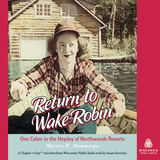 Return to Wake Robin: One Cabin in the Heyday of Northwoods Resorts
Marnie O. Mamminga
Wisconsin Historical Society Press, 2013 Five generations of Marnie O. Mamminga’s family have been rejuvenated by times together in Wisconsin’s Northwoods. In a series of evocative remembrances accompanied by a treasure trove of vintage family photos, Mamminga takes us to Wake Robin, the cabin her grandparents built in 1929 on Big Spider Lake near Hayward, on land adjacent to Moody’s Camp. Along the way she preserves the spirit and cultural heritage of a vanishing era, conveying the heart of a place and the community that gathered there. Bookended by the close of the logging era and the 1970s shift to modern lake homes, condos, and Jet Skis, the 1920s to 1960s period covered in these essays represents the golden age of Northwoods camps and cabins—a time when retreats such as Wake Robin were the essence of simplicity. In Return to Wake Robin, Mamminga describes the familiar cadre of fishing guides casting their charm, the camaraderie and friendships among resort workers and vacationers, the call of the weekly square dance, the splash announcing a perfectly executed cannonball, the lodge as gathering place. By tracing the history of one resort and cabin, she recalls a time and experience that will resonate with anyone who spent their summers Up North—or wishes they had.
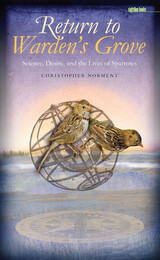 Return to Warden's Grove: Science, Desire, and the Lives of Sparrows
Christopher Norment
University of Iowa Press, 2008 Based on three seasons of field research in the Canadian Arctic, Christopher Norment's exquisitely crafted meditation on science and nature, wildness and civilization, is marked by bottomless prose, reflection on timeless questions, and keen observations of the world and our place in it. In an era increasingly marked by cutting-edge research at the cellular and molecular level, what is the role for scientists of sympathetic observation? What can patient waiting tell us about ourselves and our place in the world? His family at home in the American Midwest, Norment spends months on end living in isolation in the Northwest Territories, studying the ecology of the Harris's Sparrow. Although the fourteenth-century German mystic Meister Eckhardt wrote, "God is at home, we are in the far country," Norment argues that an intellectual, emotional, and spiritual "far country" can be found in the lives of animals and arctic wilderness. For Norment, "doing science" can lead to an enriched aesthetic and emotional connection to something beyond the self and a way to develop a sacred sense of place in a world that feels increasingly less welcoming, certain, and familiar.
 The Returned: Former U.S. Migrants’ Lives in Mexico City
Claudia Masferrer
Russell Sage Foundation, 2025 In the first two decades of the 21st century, more than two million Mexican migrants returned to Mexico from the United States. Between 2010 and 2020, the number of people who returned to Mexico was so large that, for the first time in at least fifty years, more people entered Mexico from the United States than entered the United States from Mexico. Many of these migrants were destined for urban areas, and we know little about how they fare after they return to cities. In The Returned, sociologists Claudia Masferrer, Erin R. Hamilton, and Nicole Denier examine the experiences of returned migrants in Mexico City, one of the largest metropolitan areas in the world.
Masferrer, Hamilton, and Denier draw on interviews with former U.S. migrants living in Mexico City to better understand the experience of return migration to urban areas. Each of the migrants they spoke with lived in the United States for long periods with noncitizen status during the last four decades. During this time, U.S. immigration policy became increasingly focused on restriction and enforcement, which made it difficult for migrants to safely move back and forth across the border for work or to visit family without documentation. The authors find that upon their return, migrants in Mexico City felt disoriented and lost and had difficulty adapting to a massive urban environment where there is little support for returnees. They struggled to translate their work experience from their time in the U.S. to find quality jobs. Additionally, many found their family lives upended as they reunited with or formed families in the U.S.. Some found themselves separated from family members still in the U.S. with no ability to legally visit them. Others brought their families back to Mexico, some of whom were U.S. citizens and had never been to Mexico before. They, too, struggled to adapt and integrate to life in Mexico City.
The authors use the experiences of return migrants to discuss policies and practices that would improve their lives and ease their reintegration. To help with the disorientation they experience, returnees proposed ongoing psychological support with mental health professionals who have knowledge and training in the social and legal issues that return migrants face. Return migrants also advocated for policies to enhance skill matching, job creation, and entrepreneurship, as many felt the occupational skills they developed in the U.S. were undervalued in Mexico. To address family separation, returnees argued for legal and policy reform to accommodate family reunification.
The Returned is an illuminating account of the difficulties faced by return migrants and their families in Mexico City.
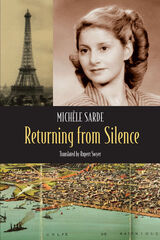 Returning from Silence: Jenny’s Story
Michèle Sarde
Swan Isle Press, 2022 A novel that tells the story of a Jewish family in World War II and reaches deep into Jewish history.
Born in Brittany on the threshold of World War II, novelist Michèle Sarde had long been silent about her origins. After her mother, Jenny, finally shared their family history, Sarde decided to reconstruct Jenny’s journey, including her exile from Salonica, move to Paris in 1921, and assimilation in France. The Nazi occupation then forced her and her family to hide and conceal their Jewish identity, and in this retelling, Sarde shows how Jenny fights with everything she has to survive the Holocaust and protect her daughter.
Returning from Silence is a powerful saga that reaches deep into Jewish history, opening with the Expulsion of the Jews from Spain in 1492 and their settlement in a more tolerant Ottoman Empire. Sephardi culture and language flourished in Salonica for four centuries, but with the fall of the Ottoman Empire in the 1920s, and the sense of troubling times to come, Jenny’s family felt impelled to leave their much-loved city and rebuild their lives in France. Their years in France led to change that none could have fully expected, and then, the Holocaust. The trauma lasts well into the post-war period, silencing both mother and daughter in unanticipated ways.
Through this family history, Sarde sensitively raises questions about identity, migration, and assimilation while weaving fiction together with history, research, and testimony to bring the characters’ stories to life.
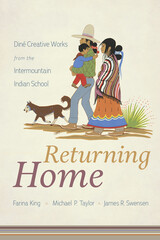 Returning Home: Diné Creative Works from the Intermountain Indian School
Farina King, Michael P. Taylor, and James R. Swensen With Contributions by Robert Dodson, Rena Dunn, Terence Wride, and Students of the Intermountain Indian School
University of Arizona Press, 2021 Returning Home features and contextualizes the creative works of Diné (Navajo) boarding school students at the Intermountain Indian School, which was the largest federal Indian boarding school between 1950 and 1984. Diné student art and poetry reveal ways that boarding school students sustained and contributed to Indigenous cultures and communities despite assimilationist agendas and pressures.
This book works to recover the lived experiences of Native American boarding school students through creative works, student interviews, and scholarly collaboration. It shows the complex agency and ability of Indigenous youth to maintain their Diné culture within the colonial spaces that were designed to alienate them from their communities and customs. Returning Home provides a view into the students’ experiences and their connections to Diné community and land. Despite the initial Intermountain Indian School agenda to send Diné students away and permanently relocate them elsewhere, Diné student artists and writers returned home through their creative works by evoking senses of Diné Bikéyah and the kinship that defined home for them.
Returning Home uses archival materials housed at Utah State University, as well as material donated by surviving Intermountain Indian School students and teachers throughout Utah, Arizona, and New Mexico. Artwork, poems, and other creative materials show a longing for cultural connection and demonstrate cultural resilience. This work was shared with surviving Intermountain Indian School students and their communities in and around the Navajo Nation in the form of a traveling museum exhibit, and now it is available in this thoughtfully crafted volume. By bringing together the archived student arts and writings with the voices of living communities, Returning Home traces, recontextualizes, reconnects, and returns the embodiment and perpetuation of Intermountain Indian School students’ everyday acts of resurgence.
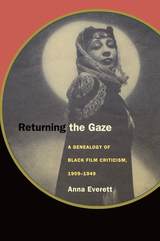 Returning the Gaze: A Genealogy of Black Film Criticism, 1909–1949
Anna Everett
Duke University Press, 2001 In Returning the Gaze Anna Everett revises American film history by recuperating the extensive and all-but-forgotten participation of black film critics during the early twentieth century. While much of the existing scholarship on blacks and the cinema focuses on image studies and stereotypical representations, this work excavates a wealth of early critical writing on the cinema by black cultural critics, academics, journalists, poets, writers, and film fans.
Culling black newspapers, magazines, scholarly and political journals, and monographs, Everett has produced an unparalleled investigation of black critical writing on the early cinema during the era of racial segregation in America. Correcting the notion that black critical interest in the cinema began and ended with the well-documented press campaign against D. W. Griffith’s Birth of a Nation, she discovers that as early as 1909 black newspapers produced celebratory discourses about the cinema as a much-needed corrective to the predominance of theatrical blackface minstrelsy. She shows how, even before the Birth of a Nation controversy, the black press succeeded in drawing attention to both the callous commercial exploitation of lynching footage and the varied work of black film entrepreneurs. The book also reveals a feast of film commentaries that were produced during the “roaring twenties” and the jazz age by such writers as W.E.B. DuBois, Langston Hughes, and Zora Neale Hurston, as well as additional pieces that were written throughout the Depression and the pre– and post–war periods. Situating this wide-ranging and ideologically complex material in its myriad social, political, economic, and cultural contexts, Everett aims to resuscitate a historical tradition for contemporary black film literature and criticism.
Returning the Gaze will appeal to scholars and students of film, black and ethnic studies, American studies, cultural studies, literature, and journalism.
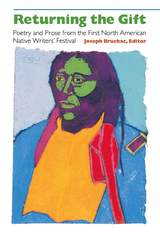 Returning the Gift: Poetry and Prose from the First North American Native Writers' Festival
Edited by Joseph Bruchac
University of Arizona Press, 1994 An unprecedented gathering of more than 300 Native writers was held in Norman, Oklahoma, in 1992. The Returning the Gift Festival brought more Native writers together in one place than at any other time in history. "Returning the Gift," observes co-organizer Joseph Bruchac, "both demonstrated and validated our literature and our devotion to it, not just to the public, but to ourselves." In compiling this volume, Bruchac invited every writer who attended the festival to submit new, unpublished work; he then selected the best of the more than 200 submissions to create a collection that includes established writers like Duane Niatum, Simon Ortiz, Lance Henson, Elizabeth Woody, Linda Hogan, and Jeanette Armstrong, and also introduces such lesser-known or new voices as Tracy Bonneau, Jeanetta Calhoun, Kim Blaeser, and Chris Fleet.
The anthology includes works from every corner of the continent, representing a wide range of tribal affiliations, languages, and cultures. By taking their peoples' literature back to them in the form of stories and songs, these writers see themselves as returning the gift of storytelling, culture, and continuance to the source from which it came. In addition to contributions by 92 writers are two introductory chapters: Joseph Bruchac comments on the current state of Native literature and the significance of the festival, and Geary Hobson traces the evolution of the event itself.
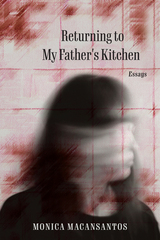 Returning to My Father's Kitchen: Essays
Monica Macansantos
Northwestern University Press, 2025 A young Filipino writer’s odyssey toward home, in the wake of the loss of her poet father
Feeling untethered after her beloved poet father passes away while she is living abroad, Monica Macansantos decides to return to the Philippines to regain her bearings. But with her father gone and her adult life rooted in the United States and New Zealand, can the land of her birth still serve as a place of healing?
In fifteen richly felt essays, Macansantos considers her family’s history in the Philippines, her own experiences as an exile, and the parent who was the heart of her family’s kitchen, whether standing at the stove to prepare dinner or sitting at the table to scribble in his notebook. Macansantos finds herself remaking her father’s chicken adobo, but also closely rereading his poems. As she reckons with his identity as an artist, she also comes into her own as a writer, and she invites us to consider whether it is possible to carry our homes with us wherever we go.
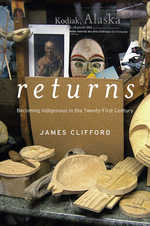 Returns: Becoming Indigenous in the Twenty-First Century
James Clifford
Harvard University Press, 2013 Returns explores homecomings—the ways people recover and renew their roots. Engaging with indigenous histories of survival and transformation, James Clifford opens fundamental questions about where we are going, separately and together, in a globalizing, but not homogenizing, world.
It was once widely assumed that native, or tribal, societies were destined to disappear. Sooner or later, irresistible economic and political forces would complete the work of destruction set in motion by culture contact and colonialism. But many aboriginal groups persist, a reality that complicates familiar narratives of modernization and progress. History, Clifford invites us to observe, is a multidirectional process, and the word “indigenous,” long associated with primitivism and localism, is taking on new, unexpected meanings.
In these probing and evocative essays, native people in California, Alaska, and Oceania are understood to be participants in a still-unfolding process of transformation. This involves ambivalent struggle, acting within and against dominant forms of cultural identity and economic power. Returns to ancestral land, performances of heritage, and maintenance of diasporic ties are strategies for moving forward, ways to articulate what can paradoxically be called “traditional futures.” With inventiveness and pragmatism, often against the odds, indigenous people today are forging original pathways in a tangled, open-ended modernity. The third in a series that includes The Predicament of Culture (1988) and Routes (1997), this volume continues Clifford’s signature exploration of late-twentieth-century intercultural representations, travels, and now returns.
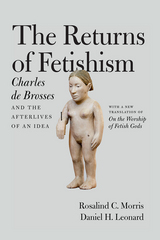 The Returns of Fetishism: Charles de Brosses and the Afterlives of an Idea
Charles de Brosses, Rosalind C. Morris, and Daniel H. Leonard
University of Chicago Press, 2017 For more than 250 years, Charles de Brosses’s term “fetishism” has exerted great influence over our most ambitious thinkers. Used as an alternative to “magic,” but nonetheless expressing the material force of magical thought, de Brosses’s term has proved indispensable to thinkers as diverse as Kant, Hegel, Marx, Freud, Lacan, Baudrillard, and Derrida. With this book, Daniel H. Leonard offers the first fully annotated English translation of the text that started it all, On the Worship of Fetish Gods, and Rosalind C. Morris offers incisive commentary that helps modern readers better understand it and its legacy.
The product of de Brosses’s autodidactic curiosity and idiosyncratic theories of language, On the Worship of Fetish Gods is an enigmatic text that is often difficult for contemporary audiences to assess. In a thorough introduction to the text, Leonard situates de Brosses’s work within the cultural and intellectual milieu of its time. Then, Morris traces the concept of fetishism through its extraordinary permutations as it was picked up and transformed by the fields of philosophy, comparative religion, political economy, psychoanalysis, and anthropology. Ultimately, she breaks new ground, moving into and beyond recent studies by thinkers such as William Pietz, Hartmut Böhme, and Alfonso Iacono through illuminating new discussions on topics ranging from translation issues to Africanity and the new materialisms.
 Reuben, Reuben: A Novel
Peter De Vries
University of Chicago Press, 1964 Harking from the golden age of fiction set in American suburbia—the school of John Updike and Cheever—this work from the great American humorist Peter De Vries looks with laughter upon its lawns, its cocktails, and its slightly unreal feeling of comfort. A manic epic, Reuben, Reuben is really three books in one, tied together by a 1950s suburban Connecticut setting and hyper-literate cast of characters. A corruptible chicken farmer fearful for the fate of his beloved town, a womanizing poet from Wales (Dylan Thomas in disguise), and a hapless British poet-cum-actor-and-agent all take turns as narrator, revealing different, even conflicting views. But alcoholism, sexism, small-mindedness, and calamity challenge the high spirits of De Vries’s well-read suburbanites. Noted as much for his verbal fluidity and wordplay as for his ability to see humor through pain, De Vries will delight both new readers and old in this uproarious modern masterpiece.
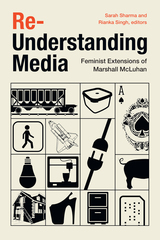 Re-Understanding Media: Feminist Extensions of Marshall McLuhan
Sarah Sharma and Rianka Singha, editors
Duke University Press, 2022 The contributors to Re-Understanding Media advance a feminist version of Marshall McLuhan’s key text, Understanding Media: The Extensions of Man, repurposing his insight that “the medium is the message” for feminist ends. They argue that while McLuhan’s theory provides a falsely universalizing conception of the technological as a structuring form of power, feminist critics can take it up to show how technologies alter and determine the social experiences of race, gender, class, and sexuality. This volume showcases essays, experimental writings, and interviews from media studies scholars, artists, activists, and those who work with and create technology. Among other topics, the contributors extend McLuhan’s discussion of transportation technology to the attics and cargo boxes that moved Black women through the Underground Railroad, apply McLuhan’s concept of media as extensions of humans to analyze Tupperware as media of containment, and take up 3D printing as a feminist and decolonial practice. The volume demonstrates how power dynamics are built into technological media and how media can be harnessed for radical purposes.
Contributors. Nasma Ahmed, Morehshin Allahyari, Sarah Banet-Weiser, Wendy Hui Kyong Chun, Brooke Erin Duffy, Ganaele Langlois, Sara Martel, Shannon Mattern, Cait McKinney, Jeremy Packer, Craig Robertson, Sarah Sharma, Ladan Siad, Rianka Singh, Nicholas Taylor, Armond R. Towns, and Jennifer Wemigwans
Reunion
Fleda Brown
University of Wisconsin Press, 2007 The poems in Reunion insistently turn back toward sources: toward home and the idea of home, toward the body, and toward objects that return us to ourselves. They always surprise, moving from quantum mechanics, wildflowers, and a Bobcat driver to a woman killed by a flying deer, magma becoming rock, and an invasion of flying ants. Fleda Brown deftly unites daily frustrations and suffering with profound psychological, physical, and cosmic questions.
 A Reunion of Trees: The Discovery of Exotic Plants and Their Introduction into North American and European Landscapes
Stephen A. Spongberg
Harvard University Press, 1990 This is a travel story of trees and shrubs—as rousing as the adventures of Marco Polo. Stephen Spongberg’s vividly written and lavishly illustrated account tells of intrepid and extraordinary explorers who journeyed to the far corners of the globe and brought back to Europe and North America a wealth of exotic plant species. It constitutes a veritable history of ornamental trees and shrubs.
In the seventeenth century, gardening in England and Europe was in the throes of revolution. Plants—no longer cultivated solely for their practical value as a source of food or medicinal herbs—were woven into the landscape for architectural effects. Flowers were grown and arranged to beautify banquet tables, and the gardens surrounding palaces and country estates became pleasure grounds, their design vying with the genius of the houses themselves. Where did these hundreds of trees and shrubs originate? Virginia creepers, American sycamores, Washington thorns, black walnuts, umbrella trees. Franklin trees, and even poison ivy are just a few of the many species that were brought to European gardens by adventurous plantsmen exploring colonial America.
Following the Revolutionary War, scientific and agricultural societies were formed in Boston and Philadelphia, botanical gardens were established in New York and Cambridge, and scientific expeditions were organized for the purpose of fostering the discovery of new plants throughout the world that could be grown in the North American climate.
Without doubt, the most fertile plant explorations by Americans and Europeans were conducted in the mysterious Orient. With the opening of Japanese and Chinese ports to foreign trade in the middle of the nineteenth century, European plantsmen were able to indulge their insatiable appetite for some of the most astounding ornamental plants the Western world had ever seen: ginkgo trees, lacebark pines, Japanese yew, honeysuckles, lilacs, crabapples, magnolias, cherry trees, to name only a few.
A Reunion of Trees focuses on the particular contribution of the Arnold Arboretum, which was established in Boston in 1872 for the purpose of displaying and studying exotic plants from around the globe. Scores of trees and shrubs on the Arboretum grounds are described and illustrated in this handsomely produced volume. The landscape designer interested in recreating period gardens will find this book a treasure trove of information about the eighteenth and nineteenth centuries, while amateur and professional gardeners alike will discover a unique resource book for many unusual plants.
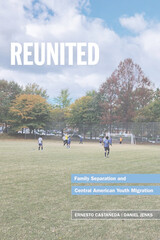 Reunited: Family Separation and Central American Youth Migration
Ernesto Castañeda
Russell Sage Foundation, 2024 In the second decade of the twenty-first century, an increasing number of children from El Salvador, Honduras, and Guatemala began arriving without parents at the U.S.-Mexico border. In many cases, the parents had left for the United States years earlier to earn money that they could send back home. In Reunited sociologists Ernesto Castañeda and Daniel Jenks explain the reasons for Central American youths’ migration, describe the journey, and document how the young migrants experience separation from and subsequent reunification with their families.
In interviews with Central American youth, their sponsors, and social services practitioners in and around Washington, D.C., Castañeda and Jenks find that Central American minors migrate on their own mainly for three reasons: gang violence, lack of educational and economic opportunity, and a longing for family reunification. The authors note that youth who feel comfortable leaving and have feelings of belonging upon arrival integrate quickly and easily while those who experience trauma in their home countries and on their way to the United States face more challenges.
Castañeda and Jenks recount these young migrants’ journey from Central America to the U.S. border, detailing the youths’ difficulties passing through Mexico, proving to U.S. Customs and Border Protection officials that they have a legitimate fear of returning or are victims of trafficking, and staying in shelters while their sponsorship, placement, and departure are arranged. The authors also describe the tensions the youth face when they reunite with family members they may view as strangers. Despite their biological, emotional, and financial bonds to these relatives, the youth must learn how to relate to new authority figures and decide whether or how to follow their rules.
The experience of migrating can have a lasting effect on the mental health of young migrants, Castañeda and Jenks note. Although the authors find that Central American youths’ mental health improves after migrating to the United States, the young migrants remain at risk of further problems. They are likely to have lived through traumatizing experiences that inhibit their integration. Difficulty integrating, in turn, creates new stressors that exacerbate PTSD, depression, and anxiety. Consequently, schools and social service organizations are critical, the authors argue, for enhancing youth migrants’ sense of belonging and their integration into their new communities. Bilingual programs, Spanish-speaking PTA groups, message boards, mentoring of immigrant children, and after-school programs for members of reunited families are all integral in supporting immigrant youth as they learn English, finish high school, apply to college, and find jobs.
Offering a complex exploration of youth migration and family reunification, Reunited provides a moving account of how young Central American migrants make the journey north and ultimately reintegrate with their families in the United States.
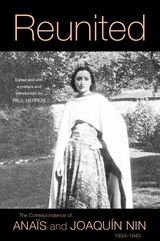 Reunited: The Correspondence of Anaïs and Joaquín Nin, 1933–1940
Anaïs Nin; Joaquín Nin
Ohio University Press, 2020 The incestuous affair between the writer Anaïs Nin and her father, the pianist-composer Joaquín Nin, is well documented in the volume of her unexpurgated diary published under the title Incest. What has been missing from that account is Joaquín’s point of view. Reunited: The Correspondence of Anaïs and Joaquín Nin, 1933–1940 presents more than one hundred intimate communications between these two artistic geniuses, revealing not only the dynamics of their complex relationship but also why Anaïs spent her life in a never-ending battle to feel loved, appreciated, and understood. Reunited collects the correspondence between Anaïs and Joaquín just before, during, and after the affair, which commenced in 1933, twenty years after he had abandoned his ten-year-old daughter and the rest of his family. These letters were long believed to have been destroyed and lost to history. In 2006, however, a folder containing Joaquín’s original letters to his daughter was discovered in Anaïs’s Los Angeles home, along with a second folder of her letters to him. Together, these letters tell the story of an absent father’s attempt to reconnect with his adult daughter and how that rapprochement quickly turned into an illicit sexual relationship.
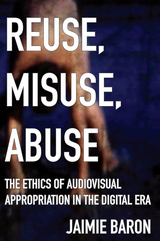 Reuse, Misuse, Abuse: The Ethics of Audiovisual Appropriation in the Digital Era
Jaimie Baron
Rutgers University Press, 2021 In contemporary culture, existing audiovisual recordings are constantly reused and repurposed for various ends, raising questions regarding the ethics of such appropriations, particularly when the recording depicts actual people and events. Every reuse of a preexisting recording is, on some level, a misuse in that it was not intended or at least anticipated by the original maker, but not all misuses are necessarily unethical. In fact, there are many instances of productive misuse that seem justified. At the same time, there are other instances in which the misuse shades into abuse. Documentary scholars have long engaged with the question of the ethical responsibility of documentary makers in relation to their subjects. But what happens when this responsibility is set at a remove, when the recording already exists for the taking and repurposing? Reuse, Misuse and Abuse surveys a range of contemporary films and videos that appropriate preexisting footage and attempts to theorize their ethical implications.
The Revealing Moment and Other Plays
Oscar W. Firkins
University of Minnesota Press, 1932
The Revealing Moment and Other Plays was first published in 1932. Minnesota Archive Editions uses digital technology to make long-unavailable books once again accessible, and are published unaltered from the original University of Minnesota Press editions.
"Sparkling wit, brilliancy of phrase, vivid character portrayal, erudition, taste, a delicate sense of proportion, and a genuinely felicitous style"—these are only a few of the critics' judgments on Mr. Ferkins' previously published plays.
Revealing Prophets: Prophecy In Eastern African History
David M. Anderson
Ohio University Press, 1994 This book examines the richly textured histories of prophets and prophecies within East Africa. It gives an analytical account of the significantly different forms prophecy has taken over the past century across the country. Each of the chapters takes a new look at the active dialogue between prophets and the communities whom they addressed. This dialogue continues today as the politicians and activists throughout the region still look to prophetic traditions, garnering interpretations of the past in order to provide the validation of prophetic wisdom and heroes for the present.
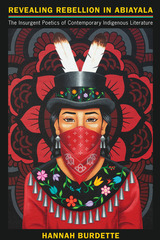 Revealing Rebellion in Abiayala: The Insurgent Poetics of Contemporary Indigenous Literature
Hannah Burdette
University of Arizona Press, 2019 From the rise of the Pan-Maya Movement in Guatemala and the Zapatista uprising in Mexico to the Water and Gas Wars in Bolivia and the Idle No More movement in Canada, the turn of the twenty-first century has witnessed a notable surge in Indigenous political action as well as an outpouring of texts produced by Native authors and poets. Throughout the Americas—Abiayala, or the “Land of Plenitude and Maturity” in the Guna language of Panama—Indigenous people are raising their voices and reclaiming the right to represent themselves in politics as well as in creative writing.
Revealing Rebellion in Abiayala explores the intersections between Indigenous literature and social movements over the past thirty years through the lens of insurgent poetics. Author Hannah Burdette is interested in how Indigenous literature and social movements are intertwined and why these phenomena arise almost simultaneously in disparate contexts across the Americas.
Literature constitutes a key weapon in political struggles as it provides a means to render subjugated knowledge visible and to envision alternatives to modernity and coloniality. The surge in Indigenous literature and social movements is arguably one of the most significant occurrences of the twenty-first century, and yet it remains understudied. Revealing Rebellion in Abiayala bridges that gap by using the concept of Abiayala as a powerful starting point for rethinking inter-American studies through the lens of Indigenous sovereignty.
Revealing Structure
Edited by Eugene Buckley, Thera Crane, and Jeff Good
CSLI, 2018 Drawing from a wide range of perspectives in the analysis of grammatical structures, the papers collected in this book are unified not by linguistic subfield, but by the investigative method they employ in revealing grammatical patterns. Revealing Structure explores this style of investigation across phonology, morphology, and syntax. Dedicated to celebrated linguist Larry Hyman, author of such books as A Theory of Phonological Weight, this volume also features data from diverse languages—with a special emphasis on the languages of Africa—making it unique among existing linguistics collections.
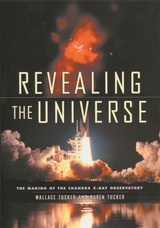 Revealing the Universe: The Making of the Chandra X-ray Observatory
Wallace Tucker and Karen Tucker
Harvard University Press, 2001 When the first X-ray detectors revealed many places in the universe that are too hot to be seen by optical and radio telescopes, pioneering X-ray astronomers realized they were onto something big. They knew that a large X-ray observatory must be created if they were ever to understand such astonishing phenomena as neutron stars, supernovas, black holes, and dark matter. What they could not know was how monumental in time, money, and effort this undertaking would be. Revealing the Universe tells the story of the Chandra X-ray Observatory.
From the first proposal for a large X-ray telescope in 1970 to the deployment of Chandra by the Space Shuttle Columbia in 1999, this book chronicles the technical feats, political struggles, and personal dramas that transformed an inspired vision into the world's supreme X-ray observatory. With an insider's knowledge and a storyteller's instincts, Wallace and Karen Tucker describe the immense challenges that this project posed for such high-tech industry giants as TRW, Eastman Kodak, and Hughes Danbury Optical Systems (now Raytheon Optical Systems). Their portrayal of the role of NASA is itself an extraordinary case study of multibillion-dollar government decisionmaking, and a cautionary tale for future large space astronomy missions.Revealing the Universe is primarily the story of the men and women whose discoveries, skills, failures, and successes made the Chandra X-ray Observatory possible.
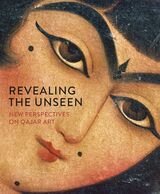 Revealing the Unseen: New Perspectives on Qajar Art
Edited by Melanie Gibson and Gwenaëlle Fellinger
Gingko, 2022 Collected articles on Iranian art from the Qajar dynasty.
The thirteen articles in this volume were originally given as presentations at the symposium of the same name organized in June 2018 by the Musée du Louvre and the Musée du Louvre-Lens in conjunction with the exhibition The Empire of Roses: Masterpieces of 19th Century Persian Art. The exhibition explored the art of Iran in the nineteenth and early twentieth centuries, while the nation was under the rule of the Qajar dynasty. The symposium set out to present research on previously unknown and unpublished objects from this rich period of art history.
This volume, published with the Louvre Museum in France, is divided into four sections. The first, “Transitions and Transmissions,” is dedicated to the arts of painting, illumination, and lithography. The focus of the second section, entitled “The Image Revealed,” also considers works on paper, looking at new themes and techniques. “The Material World” examines the use of materials such as textiles, carpets, and armor. The articles in the final section discuss the history of two groups of artifacts acquired by their respective museums.
Reveille: Poems
George David Clark
University of Arkansas Press, 2015 In Reveille a man suffers fits of supernatural coughing, flytraps attack a child, a moray haunts a waterbed, and the prodigal son stalks his local brothel in a pair of lionhide pajamas. These poems survey their host of holy objects and exotic creatures the way one might the emblems in a dream: curious of their meanings but reluctant to interpret them and simplify their mystery. Theologically playful, rhetorically sophisticated, and formally ambitious, Reveille is rooted in awe and driven by the impulse to praise. At heart, these are love poems, though their loves are varied and complicated by terrible threats: that we will cry out and not be answered, fall asleep and never wake. Against such jeopardy Reveille fixes our attention on a lightening horizon.
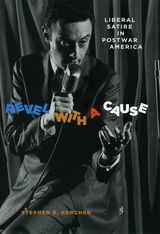 Revel with a Cause: Liberal Satire in Postwar America
Stephen E. Kercher
University of Chicago Press, 2006 We live in a time much like the postwar era. A time of arch political conservatism and vast social conformity. A time in which our nation’s leaders question and challenge the patriotism of those who oppose their policies. But before there was Jon Stewart, Al Franken, or Bill Maher, there were Mort Sahl, Stan Freberg, and Lenny Bruce—liberal satirists who, through their wry and scabrous comedic routines, waged war against the political ironies, contradictions, and hypocrisies of their times.
Revel with a Cause is their story. Stephen Kercher here provides the first comprehensive look at the satiric humor that flourished in the United States during the 1950s and early 1960s. Focusing on an impressive range of comedy—not just standup comedians of the day but also satirical publications like MAD magazine, improvisational theater groups such asSecond City, the motion picture Dr. Strangelove, and TV shows like That Was the Week That Was—Kercher reminds us that the postwar era saw varieties of comic expression that were more challenging and nonconformist than we commonly remember. His history of these comedic luminaries shows that for a sizeable audience of educated, middle-class Americans who shared such liberal views, the period’s satire was a crucial mode of cultural dissent. For such individuals, satire was a vehicle through which concerns over the suppression of civil liberties, Cold War foreign policies, blind social conformity, and our heated racial crisis could be productively addressed.
A vibrant and probing look at some of the most influential comedy of mid-twentieth-century America, Revel with a Cause belongs on the short list of essential books for anyone interested in the relationship between American politics and popular culture.
Revelation and Convergence
Mark Bosco
Catholic University of America Press, 2017 Revelation & Convergence brings together professors of literature, theology, and history to help both critics and readers better understand Flannery O’Connor’s religious imagination.
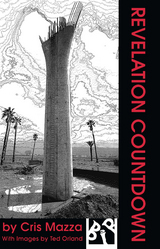 Revelation Countdown
Cris Mazza
University of Alabama Press, 1993 A collection of stories by award-winning California writer Cris Mazza that reveal the open road to be not romanticized freedom but an unsettling loss of control
While in many ways reaffirming the mythic dimension of being on the road romanticized in American pop and fold culture, Revelation Countdown also subtly undermines that view. These stories project onto the open road not the nirvana of personal freedom, but rather a type of freedom more closely resembling loss of control. Being in constant motion and passing through new environments destabilizes life, casts it out of phase, heightens perception, and skews reactions. Every little problem is magnified to overwhelming dimension. Events segue from slow motion to fast forward. Background noises intrude, causing perpetual wee hour insomnia. Imagination flourishes, often as an enemy. People suddenly discover that they never really understood their travel companions. The formerly stable line of their lives veers off course. In such an atmosphere, the title Revelation Countdown, borrowed from a roadside sign in Tennessee, proves prophetic. It may not arrive at 7:30, but revelation will inevitably find the traveler.
The Revelation of Imagination: From Homer and the Bible through Virgil and Augustine to Dante
William Franke
Northwestern University Press, 2015 In The Revelation of Imagination, William Franke attempts to focus on what is enduring and perennial rather than on what is accommodated to the agenda of the moment. Franke’s book offers re-actualized readings of representative texts from the Bible, Homer, and Virgil to Augustine and Dante. The selections are linked together in such a way as to propose a general interpretation of knowledge. They emphasize, moreover, a way of articulating the connection of humanities knowledge with what may, in various senses, be called divine revelation. This includes the sort of inspiration to which poets since Homer have typically laid claim, as well as that proper to the biblical tradition of revealed religion. The Revelation of Imagination invigorates the ongoing discussion about the value of humanities as a source of enduring knowledge.
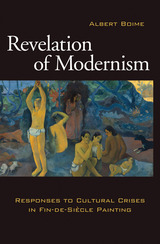 Revelation of Modernism: Response to Cultural Crises in Fin-de-Siécle Painting
Albert Boime
University of Missouri Press, 2008
Among postimpressionist painters, Van Gogh, Seurat, Cézanne, and Gauguin produced a remarkable body of work that responded to a cultural and spiritual crisis in the avant-garde world—influences that pushed them toward an increasing reliance on science, literature, and occultism. In Revelation of Modernism, renowned art historian Albert Boime reappraises specific works by these masters from a perspective more appreciative of the individuals’ inner conflicts, offering the art world a new understanding of a period fraught with apocalyptic fears and existential anxieties.
Building on the seminal observations of Sven Lövgren from a half-century ago, Boime rejects popular notions of “art for art’s sake” and rethinks an entire movement to suggest that history, rather than expressive urge, is the driving force that shapes art. He reconsiders familiar masterpieces from a fresh perspective, situating the art in the contexts of history both real and speculative, of contemporary philosophy, and of science to depict modernism as a development that ultimately failed.
Boime expands on what we think we know about these figures and produces startling new revelations about their work. From the political history of Seurat’s Parade de cirque to the astronomical foundations of Van Gogh’s Starry Night, he draws analogies between literary sources and social, personal, and political strategies that have eluded most art historians. He offers a richer and more complex vision of Cézanne, considering the artist as an Old Testament figure in search of the Promised Landscape. And he provides a particularly detailed look at Gauguin—on whom Boime has never previously published—that takes a closer look at the artist’s The Vision after the Sermon and its allusions to Eliphas Lévi’s writings, sheds light on the sources for From whence do we come? and offers new thoughts about Gauguin’s various self-portraits.
Boime’s latest contribution further testifies to his status as one of our most important living art historians. As entertaining as it is eloquent, Revelation of Modernism is a bold and groundbreaking work that should be required reading for all who wish to understand the contradictory origins and development of modernism and its role in history.
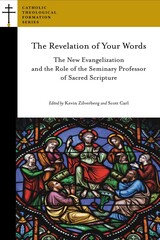 The Revelation of Your Words: The New Evangelization and the Role of the Seminary Professor of Sacred Scripture
Kevin Zilverberg
Saint Paul Seminary Press , 2021 The Revelation of Your Words, a collection of essays, treats the role of the seminary professor of sacred Scripture within the context of the New Evangelization. Some of the essays concern principally the imparting of knowledge and best practices to accomplish this; others concern the fostering of delight in the sacred page and spiritual encounter with God. Although these essays are Catholic, written within a Catholic theological framework and with Catholic seminaries in mind, many of their conclusions can be applied to non-Catholic environments. This book provides insights that, even beyond the seminary, will benefit teachers of the Bible, regardless of their denomination and level of instruction.
Readers will encounter the following authors and topics. Peter S. Williamson writes on the implications of the New Evangelization for priestly ministry and for teaching Scripture. Steven C. Smith makes a contribution concerning the role of the seminary professor of sacred Scripture in forming priests. Michael Magee treats the relevance of Johannine irony to the New Evangelization. Stephen Ryan’s chapter takes up the topic of Old Testament Wisdom literature and formation for a New Evangelization. Juana L. Manzo seeks a path to integrate modern and ancient interpretations into the seminary classroom. Kelly Anderson takes up the father of Proverbs 1–9 as a model of spiritual fatherhood for seminary professors. Scott Carl proposes a spiritual reading of sacred Scripture in the twenty-first century. Michael Magee, in his second contribution, writes on the joy of discovery in the Fourth Gospel. James Keating reflects upon the exegete as seminary formator. Finally, André Villeneuve advocates for the teaching of Biblical Hebrew in Catholic seminaries and academic institutions.
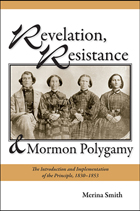 Revelation, Resistance, and Mormon Polygamy: The Introduction and Implementation of the Principle, 1830–1853
Merina Smith
Utah State University Press, 2013 In Revelation, Resistance, and Mormon Polygamy historian Merina Smith explores the introduction of polygamy in Nauvoo, a development that unfolded amid scandal and resistance. Smith considers the ideological, historical, and even psychological elements of the process and captures the emotional and cultural detail of this exciting and volatile period in Mormon history. She illuminates the mystery of early adherents' acceptance of such a radical form of marriage in light of their dedication to the accepted monogamous marriage patterns of their day.
When Joseph Smith began to reveal and teach the doctrine of plural marriage in 1841, even stalwart members like Brigham Young were shocked and confused. In this thoughtful study, Smith argues that the secret introduction of plural marriage among the leadership coincided with an evolving public theology that provided a contextualizing religious narrative that persuaded believers to accept the principle.
This fresh interpretation draws from diaries, letters, newspapers, and other primary sources and is especially effective in its use of family narratives. It will be of great interest not only to scholars and the general public interested in Mormon history but in American history, religion, gender and sexuality, and the history of marriage and families.
Revelationist Aesthetics in Contemporary Cinema: An Intellectual History (1950s–2000s)
Karel Pletinck
Amsterdam University Press, 2025 On the cusp of the twenty-first century, the notion of art as revelation of reality held sway in film aesthetics and criticism. Where did this seemingly naive belief in the vocation of art originate, what sustained it, and how did it shape the work of filmmakers, as diverse as Jean-Luc Godard, Jean-Marie Straub and Danièle Huillet, and Abbas Kiarostami? These questions launch this book’s exploration of the revelationist tradition from the 1950s to the early 2000s, revisiting a formative period in film history – from Italian Neorealism and the Nouvelle Vague to political modernism – and assessing its lasting impact on contemporary cinema. With the passing of its last major figures, Godard and Straub, in 2022, a critical reassessment of this tradition is timely.
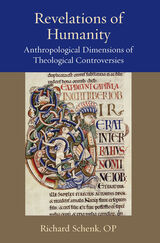 Revelations of Humanity: Anthropological Dimensions of Theological Controversies
Richard Schenk, OP
Catholic University of America Press, 2022 Revelations of Humanity brings together essays into the history and actuality of how our searches for God and for our own humanity are interwoven. They argue that the revelation of God is possible only when accompanied by a revelation of what it means to be a human being. Revelation implies that the truth is not fully evident in either case.
This quest is aided in many of the essays by a recollection of the thought of Thomas Aquinas. As opposed to simple memory, recollection implies that memory has been lost or become clouded, here by the misrepresentation of Thomas’ view of humanity’s relation to God as harmonistic, at best semi-Pelagian, often even naturalistic. This difficult recovery is made possible by historical research that alone can escape the easy systematic alienation that supporters and critics of Thomas have often brought to their interpretation of his works. Thomas’s sense of a real but finite capacity of human beings for God, his grace and revelation, anticipates in more ways than is commonly known much of contemporary suspicion about human capacities, but in ways that are open to God. That programmatic insight into the historical Thomas, keenly aware of human entanglements, limits and hopes, offers on many contemporary issues a ressourcement of systematic thought.
Revelations of Humanity revolves around three clusters of issues. The first asks about the reality and limits of the human capacity for truth: in metaphysical, moral and political matters and in relation to the disputed issues of analogous reason and faith. The second cluster is structured around the four involvements that the Second Vatican Council identified as the human face of genuine Christian existence: participation in the legitimate joys, hopes, sorrows and fears of the contemporary world. These are refracted in the broken light of the human proprium of risibility, the abiding uncertainty addressed by hope, the disputed question of a suffering God and the recollection of Christ’s anxiety in the face of death. The final cluster brings together anthropological dimensions of current ecumenical and interreligious disputes: the need to complement affirmation with admonition in ecumenical conversation, exemplified by the ambivalence towards sacrifice in a genuinely Catholic theology and the need to avoid the excesses of univocity, equivocity or an all too facile analogy in the determination of interreligious relationalities.
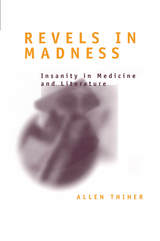 Revels in Madness: Insanity in Medicine and Literature
Allen Thiher
University of Michigan Press, 2004 "Fascinating and important . . . a work of prodigious scholarship, covering the entire history of Western thought and treating both literary and medical discourses with subtlety and verve."
---Louis Sass, author of Madness and Modernism
"The scope of this book is daunting, ranging from madness in the ancient Greco-Roman world, to Christianized concepts of medieval folly, through the writings of early modern authors such as Shakespeare, Cervantes, and Descartes, and on to German Romantic philosophy, fin de siècle French poetry, and Freud . . . Artaud, Duras, and Plath."
---Isis
"This provocative and closely argued work will reward many readers."
---Choice
In Revels in Madness, Allen Thiher surveys a remarkable range of writers as he shows how conceptions of madness in literature have reflected the cultural assumptions of their era. Thiher underscores the transition from classical to modern theories of madness-a transition that began at the end of the Enlightenment and culminates in recent women's writing that challenges the postmodern understanding of madness as a fall from language or as a dysfunction of culture.
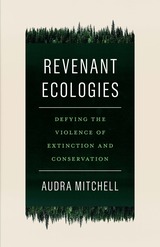 Revenant Ecologies: Defying the Violence of Extinction and Conservation
Audra Mitchell
University of Minnesota Press, 2024 Engaging a broad spectrum of ecological thought to articulate the ethical scale of global extinction As global rates of plant and animal extinctions mount, anxieties about the future of the earth’s ecosystems are fueling ever more ambitious efforts at conservation, which draw on Western scientific principles to manage species and biodiversity. In Revenant Ecologies, Audra Mitchell argues that these responses not only ignore but also magnify powerful forms of structural violence like colonialism, racism, genocide, extractivism, ableism, and heteronormativity, ultimately contributing to the destruction of unique life forms and ecosystems. Critiquing the Western discourse of global extinction and biodiversity through the lens of diverse Indigenous philosophies and other marginalized knowledge systems, Revenant Ecologies promotes new ways of articulating the ethical enormity of global extinction. Mitchell offers an ambitious framework—(bio)plurality—that focuses on nurturing unique, irreplaceable worlds, relations, and ecosystems, aiming to transform global ecological–political relations, including through processes of land return and critically confronting discourses on “human extinction.” Highlighting the deep violence that underpins ideas of “extinction,” “conservation,” and “biodiversity,” Revenant Ecologies fuses political ecology, global ethics, and violence studies to offer concrete, practical alternatives. It also foregrounds the ways that multi-life-form worlds are actively defying the forms of violence that drive extinction—and that shape global efforts to manage it. Retail e-book files for this title are screen-reader friendly with images accompanied by short alt text and/or extended descriptions.
Revenge Capitalism: The Ghosts of Empire, the Demons of Capital, and the Settling of Unpayable Debts
Max Haiven
Pluto Press, 2020 Capitalism is in a profound state of crisis. Beyond the mere dispassionate cruelty of 'ordinary' structural violence, it appears today as a global system bent on reckless economic revenge; its expression found in mass incarceration, climate chaos, unpayable debt, pharmaceutical violence and the relentless degradation of common life.
In Revenge Capitalism, Max Haiven argues that this economic vengeance helps us explain the culture and politics of revenge we see in society more broadly. Moving from the history of colonialism and its continuing effects today, he examines the opioid crisis in the US, the growth of 'surplus populations' worldwide and unpacks the central paradigm of unpayable debts - both as reparations owed, and as a methodology of oppression.
Revenge Capitalism offers no easy answers, but is a powerful call to the radical imagination.
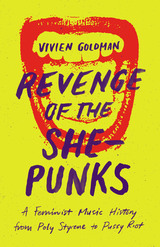 Revenge of the She-Punks: A Feminist Music History from Poly Styrene to Pussy Riot
By Vivien Goldman
University of Texas Press, 2019 As an industry insider and pioneering post-punk musician, Vivien Goldman’s perspective on music journalism is unusually well-rounded. In Revenge of the She-Punks, she probes four themes—identity, money, love, and protest—to explore what makes punk such a liberating art form for women. With her visceral style, Goldman blends interviews, history, and her personal experience as one of Britain’s first female music writers in a book that reads like a vivid documentary of a genre defined by dismantling boundaries. A discussion of the Patti Smith song “Free Money,” for example, opens with Goldman on a shopping spree with Smith. Tamar-Kali, whose name pays homage to a Hindu goddess, describes the influence of her Gullah ancestors on her music, while the late Poly Styrene's daughter reflects on why her Somali-Scots-Irish mother wrote the 1978 punk anthem “Identity,” with the refrain “Identity is the crisis you can't see.” Other strands feature artists from farther afield (including in Colombia and Indonesia) and genre-busting revolutionaries such as Grace Jones, who wasn't exclusively punk but clearly influenced the movement while absorbing its liberating audacity. From punk's Euro origins to its international reach, this is an exhilarating world tour.
Reverberations across Small-Scale British Theatre: Politics, Aesthetics and Forms
Edited by Patrick Duggan and Victor Ukaegbu
Intellect Books, 2013 Between 1960 and 2010, a new generation of British avant-garde theater companies, directors, designers, and performers emerged. Some of these companies and individuals have endured to become part of theater history while others have disappeared from the scene, mutated into new forms, or become part of the establishment. Reverberations across Small-Scale British Theatre at long last puts these small-scale British theater companies and personalities in the scholarly spotlight. By questioning what “Britishness” meant in relation to the small-scale work of these practitioners, contributors articulate how it is reflected in the goals, manifestos, and aesthetics of these companies.
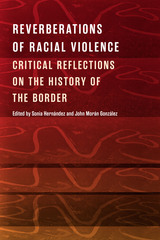 Reverberations of Racial Violence: Critical Reflections on the History of the Border
Edited by Sonia Hernández and John Morán González
University of Texas Press, 2021 Between 1910 and 1920, thousands of Mexican Americans and Mexican nationals were killed along the Texas border. The killers included strangers and neighbors, vigilantes and law enforcement officers—in particular, Texas Rangers. Despite a 1919 investigation of the state-sanctioned violence, no one in authority was ever held responsible. Reverberations of Racial Violence gathers fourteen essays on this dark chapter in American history. Contributors explore the impact of civil rights advocates, such as José Tomás Canales, the sole Mexican-American representative in the Texas State Legislature between 1905 and 1921. The investigation he spearheaded emerges as a historical touchstone, one in which witnesses testified in detail to the extrajudicial killings carried out by state agents. Other chapters situate anti-Mexican racism in the context of the era's rampant and more fully documented violence against African Americans. Contributors also address the roles of women in responding to the violence, as well as the many ways in which the killings have continued to weigh on communities of color in Texas. Taken together, the essays provide an opportunity to move beyond the more standard Black-white paradigm in reflecting on the broad history of American nation-making, the nation’s rampant racial violence, and civil rights activism.
 Revered Commander, Maligned General: The Life of Clarence Ransom Edwards, 1859-1931
Michael E. Shay
University of Missouri Press, 2011 Major General Clarence Ransom Edwards is a vital figure in American military history, yet his contribution to the U.S. efforts in World War I has often been ignored or presented in unflattering terms. Most accounts focus on the disagreements he had with General John J. Pershing, who dismissed Edwards from the command of the 26th (“Yankee”) Division just weeks before the war's end. The notoriety of the Pershing incident has caused some to view Edwards as simply a “political general” with a controversial career. But Clarence Edwards, though often a divisive figure, was a greater man than that. A revered and admired officer whose men called him “Daddy,” Edwards attained an impressive forty-year career, one matched by few wartime leaders. Michael E. Shay presents a complete portrait of this notable American and his many merits in Revered Commander, Maligned General. This long-overdue first full-length biography of General Clarence Edwards opens with his early years in Cleveland, Ohio and his turbulent times at West Point. The book details the crucial roles Edwards filled in staff and field commands for the Army before the outbreak of World War I in 1917: Adjutant-General with General Henry Ware Lawton in the Philippine-American War, first chief of the Bureau of Insular Affairs, and commander of U.S. forces in the Panama Canal Zone. Revered Commander, Maligned General follows Edwards as he forms the famous Yankee Division and leads his men into France. The conflict between Edwards and Pershing is placed in context, illuminating the disputes that led to Edwards being relieved of command. This well-researched biography quotes a wealth of primary sources in recounting the life of an important American, a man of loyalty and service who is largely misunderstood. Photographs of Edwards, his troops, and his kin—many from Edwards’ own collection—complement the narrative. In addition, several maps aid readers in following General Edwards as his career moves from the U.S. to Central America to Europe and back stateside. Shay’s portrayalof General Edwards finally provides a balanced account of this unique U.S. military leader.
 A Reverence for Rivers: Imagining an Ethic for Running Waters
Kurt D. Fausch
Oregon State University Press, 2025 In A Reverence for Rivers, Kurt Fausch draws on his experience as a stream ecologist, his interest in Indigenous cultures, and a thoughtful consideration of environmental ethics to explore human values surrounding freshwater ecosystems. Focusing on seven rivers across the globe—from the Salmon River in Oregon to the Sarufutsu River in Japan—he examines the growing ethical dilemmas threatening our rivers, including increasing demands for water, habitat fragmentation, overfishing, and deepening climate change. How do we decide which rivers deserve legal protection? What is our right to water as humans? And how do we foster resilient rivers? Through a combination of scientific expertise and thoughtful observations of the natural world, Fausch translates the science of rivers into accessible language for readers and begins to address these questions. He weaves deep Indigenous histories throughout the book and includes personal visits to tribal lands to explore the traditional values held by several Indigenous groups. Fausch reminds us that our connection to rivers is personal and grounded in specific places, flowing from the stories we carry about our relationships with and responsibilities to these rivers. In a final essay Fausch ponders Aldo Leopold’s statement that “nothing so important as an ethic is ever written,” but instead evolves in the minds of a thinking community. A Reverence for Rivers speaks to both the mind and the heart, offering perspectives so that we might begin to imagine and create an ethic for living with and caring for the running waters on which we rely for so much.
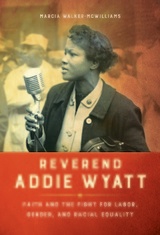 Reverend Addie Wyatt: Faith and the Fight for Labor, Gender, and Racial Equality
Marcia Walker-McWilliams
University of Illinois Press, 2016 Labor leader, civil rights activist, outspoken feminist, African American clergywoman--Reverend Addie Wyatt stood at the confluence of many rivers of change in twentieth century America. The first female president of a local chapter of the United Packinghouse Workers of America, Wyatt worked alongside Martin Luther King Jr. and Eleanor Roosevelt and appeared as one of Time magazine's Women of the Year in 1975. Marcia Walker-McWilliams tells the incredible story of Addie Wyatt and her times. What began for Wyatt as a journey to overcome poverty became a lifetime commitment to social justice and the collective struggle against economic, racial, and gender inequalities. Walker-McWilliams illuminates how Wyatt's own experiences with hardship and many forms of discrimination drove her work as an activist and leader. A parallel journey led her to develop an abiding spiritual faith, one that denied defeatism by refusing to accept such circumstances as immutable social forces.
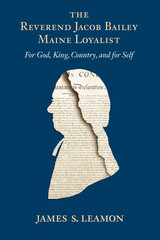 The Reverend Jacob Bailey, Maine Loyalist: For God, King, Country, and for Self
James S. Leamon
University of Massachusetts Press, 2012 This book tells the story of the Reverend Jacob Bailey, a missionary preacher for the Church of England in the frontier town of Pownalborough (now Dresden), Maine, who refused to renounce allegiance to King George III during the American War of Independence. Relying largely on Bailey's unpublished journals and voluminous correspondence, James S. Leamon traces Bailey's evolution from his rustic background through his Harvard education and subsequent career as a teacher, Congregational minister, and missionary preacher for the Church of England. Along the way, Bailey absorbed many of the intellectual currents of the Enlightenment, but also the more traditional conviction that family, society, religion, and politics, like creation itself, should be orderly and hierarchal. Such beliefs led Bailey to oppose the Revolution as unnatural, immoral, and doomed to fail.
Reverend Bailey's persistence in praying for the king and his refusal to publicize the Declaration of Independence from his Pownalborough pulpit aroused hostilities that drove him and his family to the safety of Nova Scotia. There, in exile, Bailey devoted himself to assisting fellow refugees while defending himself from others. During this time, he wrote almost obsessively: poems, dramas, novels, histories. Though few were ever completed, and even fewer published, in one way or another most of his writings depicted the trauma he underwent as a loyalist.
Leamon's study of the Reverend Jacob Bailey depicts the complex nature and burdens of one person's loyalism while revealing much about eighteenth-century American life and culture.
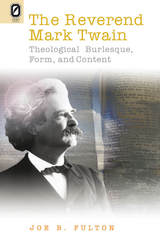 The REVEREND MARK TWAIN: THEOLOGICAL BURLESQUE, FORM, AND CONTENT
Joe B. Fulton
Ohio State University Press, 2006 “I was made in His image,” Mark Twain once said, “but have never been mistaken for Him.” God may have made Mark Twain in His image, but Twain frequently remade himself by adopting divine personae as part of his literary burlesque. Readers were delighted, rather than fooled, when Twain adopted the image of religious vocation throughout his writing career: Theologian, Missionary, Priest, Preacher, Prophet, Saint, Brother Twain, Holy Samuel, the Bishop of New Jersey, and of course, the Reverend Mark Twain. Joe B. Fulton has not written a study of Samuel Langhorne Clemens’s religious beliefs, but rather one about Twain’s use of theological form and content in a number of his works—some well-known, others not so widely read.
Twain adopted such religious personae to burlesque the religious literary genres associated with those vocations. He wrote catechisms, prophecies, psalms, and creeds, all in the theological tradition, but with a comic twist. Twain even wrote a burlesque life of Christ that has the son of God sporting blue jeans and cowboy boots. With his distinctive comic genius, Twain entered the religious dialogue of his time, employing the genres of belief as his vehicle for criticizing church and society.
Twain’s burlesques of religious form and content reveal a writer fully engaged with the religious ferment of his day. Works like The Innocents Abroad, Adventures of Huckleberry Finn, Personal Recollections of Joan of Arc, Roughing It, and What Is Man? are the productions of a writer skilled at adopting and adapting established literary and religious forms for his own purposes. Twain is sometimes viewed as a haphazard writer, but in The Reverend Mark Twain, Fulton demonstrates how carefully Twain studied established literary and theological genres to entertain—and criticize—his society.
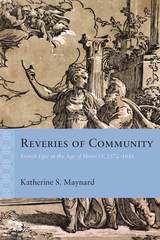 Reveries of Community: French Epic in the Age of Henri IV, 1572–1616
Katherine S. Maynard
Northwestern University Press, 2018 Reveries of Community reconsiders the role of epic poetry during the French Wars of Religion, the series of wars between Catholics and Protestants that dominated France between 1562 and 1598. Critics have often viewed French epic poetry as a casualty of these wars, arguing that the few epics France produced during this conflict failed in power and influence compared to those of France’s neighbors, such as Italy’s Orlando Furioso, England’s Faerie Queene, and Portugal’s Os Lusíadas. Katherine S. Maynard argues instead that the wars did not hinder epic poetry, but rather French poets responded to the crisis by using epic poetry to reimagine France’s present and future.
Traditionally united by une foi, une loi, un roi (one faith, one law, one king), France under Henri IV was cleaved into warring factions of Catholics and Huguenots. The country suffered episodes of bloodshed such as the St. Bartholomew’s Day Massacre, even as attempts were made to attenuate the violence through frequent edicts, including those of St. Germain (1570) and Nantes (1598). Maynard examines the rich and often dismissed body work written during these bloody decades: Pierre de Ronsard’s Franciade, Guillaume Salluste Du Bartas’s La Judit and La Sepmaine, Sébastian Garnier’s La Henriade, Agrippa d’Aubigné’s Les Tragiques, and others. She traces how French poets, taking classics such as Virgil’s Aeneid and Homer’s Iliad as their models, reimagined possibilities for French reconciliation and unity.
 The Reveries of the Solitary Walker, Botanical Writings, and Letter to Franquières
Jean-Jacques Rousseau
Dartmouth College Press, 2000 “I am now alone on earth, no longer having any brother, neighbor, friend, or society other than myself” proclaimed Rousseau in Reveries of the Solitary Walker. Reveries, along with Botanical Writings and Letter to Franquières, were all written at the end of his life, a period when Rousseau renounced his occupation as author and ceased publishing his works. Presenting himself as an unwilling societal outcast, he nonetheless crafted each with a sharp eye on his readership. Whether addressing himself, a mother hoping to interest her child in botany, or a confused young nobleman, his dialogue reflects the needs of his interlocutor and of future readers. Although very different in style, these three works concern overlapping subjects. Their unity comes from the relation of the other writings to the Reveries, which consists of ten meditative “walks” during which Rousseau considers his life and thought. The third and fourth walks discuss truth, morality, and religious belief, which are the themes of the Letter to Franquières; while the seventh is a lengthy discussion of botany as a model for contemplative activity. The overarching themes of the volume—the relations among philosophic or scientific contemplation, religion, and morality—provide Rousseau’s most intimate and final reflections on the difficulties involved in understanding nature.
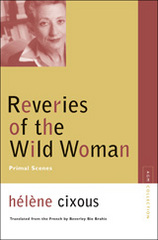 Reveries of the Wild Woman: Primal Scenes
Helene Cixous
Northwestern University Press, 2006 All the time when I lived in Algeria, my native country,
I dreamt of one day arriving in Algeria.
Born in Oran, Algeria, Hélène Cixous spent her childhood in France's former colony. Reveries of the Wild Woman is her visceral memoir of a preadolescence that shaped her with intense feelings of alienation, yet also contributed, in a paradoxically essential way, to her development as a writer and philosopher.
Born to a French father and an Austro-German mother, both Jews, Cixous experienced a childhood fraught with racial and gender crisis. In her moving story she recounts how small events--a new dog, the gift of a bicycle--reverberate decades later as symbols filled with social and psychological meaning. She and her family endure a double alienation, by Algerians for being French and by the French for being Jewish, and Cixous builds her story on the themes of isolation and exclusion she felt in particular under the Vichy government and during the Algerian Civil War. Yet she also concedes that memories of Algeria awaken in her a longing for her home country, and ponders how that stormy relationship has influenced her life and thought.
A meditation on postcolonial identity and gender, Reveries of the Wild Woman is also a poignant recollection of how a girl's childhood is, indeed, author to the woman.
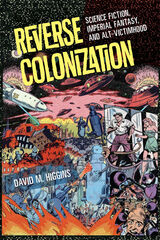 Reverse Colonization: Science Fiction, Imperial Fantasy, and Alt-victimhood
David M. Higgins
University of Iowa Press, 2021 Reverse colonization narratives are stories like H. G. Wells’s War of the Worlds, in which technologically superior Martians invade and colonize England. They ask Western audiences to imagine what it’s like to be the colonized rather than the colonizers. David Higgins argues that although some reverse colonization stories are thoughtful and provocative, reverse colonization fantasy has also led to the prevalence of a very dangerous kind of science fictional thinking in our current political culture. It has become popular among groups such as anti-feminists, white supremacists, and far-right reactionaries to appropriate a sense of righteous, anti-imperial victimhood—the sense that white men, in particular, are somehow colonized victims fighting an insurgent resistance against an oppressive establishment. Nothing could be timelier, as an armed far-right mob stormed the U.S. Capitol on January 6, 2021, in an effort to stop the presidential election from being “stolen from them.”
Higgins shows that this reverse colonization stance depends upon a science fictional logic that achieved dominance within imperial fantasy during the 1960s and has continued to gain momentum ever since. By identifying with fantastic forms of victimhood, subjects who already enjoy social hegemony are able to justify economic inequality, expansions of police and military power, climatological devastation, new articulations of racism, and countless other forms of violence—all purportedly in the name of security, self-defense, and self-protection.
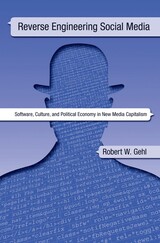 Reverse Engineering Social Media: Software, Culture, and Political Economy in New Media Capitalism
Robert W Gehl
Temple University Press, 2014 Robert Gehl's timely critique, Reverse Engineering Social Media, rigorously analyzes the ideas of social media and software engineers, using these ideas to find contradictions and fissures beneath the surfaces of glossy sites such as Facebook, Google, and Twitter. Gehl adeptly uses a mix of software studies, science and technology studies, and political economy to reveal the histories and contexts of these social media sites. Looking backward at divisions of labor and the process of user labor, he provides case studies that illustrate how binary "Like" consumer choices hide surveillance systems that rely on users to build content for site owners who make money selling user data, and that promote a culture of anxiety and immediacy over depth. Reverse Engineering Social Media also presents ways out of this paradox, illustrating how activists, academics, and users change social media for the better by building alternatives to the dominant social media sites.
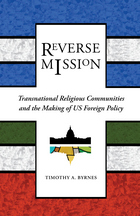 Reverse Mission: Transnational Religious Communities and the Making of US Foreign Policy
Timothy A. Byrnes
Georgetown University Press, 2011 Many Catholic priests, nuns, and brothers in the United States take a strong interest in US policies that affect their "brothers and sisters" abroad. In fact, when the policies of their native government pose significant dangers to their people internationally, these US citizens engage actively in a variety of political processes in order to protect and advance the interests of the transnational religious communities to which they belong. In this provocative examination of the place of religion in world politics, Timothy A. Byrnes focuses on three Catholic communities—Jesuit, Maryknoll, and Benedictine—and how they seek to shape US policy in El Salvador, Nicaragua, and Mexico. Based on years of fieldwork and on-the-ground interviews, Reverse Mission details the transnational bonds that drive the political activities of these Catholic orders. This fascinating book reveals how the men and women of these orders became politically active in complex and sometimes controversial causes and how, ultimately, they exert a unique influence on foreign policy that is derived from their communal loyalties rather than any ethnic or national origin.
 Reverse Tradition: Postmodern Fictions and the Nineteenth Century Novel
Robert Kiely
Harvard University Press, 1993 Reverse Tradition invites the reader of postmodern fiction to travel back to the nineteenth-century novel without pretending to let go of contemporary anxieties and expectations. What happens to the reader of Beckett when he or she returns to Melville? Or to the enthusiast of Toni Morrison who rereads Charlotte Bronte? While Robert Kiely does not claim that all fictions begin to look alike, he finds unexpected and illuminating pleasures in examining a variety of ways in which new texts reflect on old.
In this engaging book, Kiely not only juxtaposes familiar authors in unfamiliar ways; he proposes a countertradition of intertextuality and a way to release the genie of postmodernism from the bottleneck of the late twentieth century. Placing the reader’s response at the crux, he offers arresting new readings by pairing, among others, Jorge Luis Borges with Mark Twain, and Maxine Hong Kingston with George Eliot. In the process, he tests and challenges common assumptions about transparency in nineteenth-century realism and a historical opacity in early and late postmodernism.
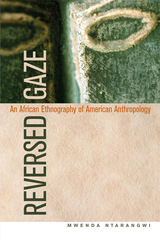 Reversed Gaze: An African Ethnography of American Anthropology
Mwenda Ntarangwi
University of Illinois Press, 2010 Deftly illustrating how life circumstances can influence ethnographic fieldwork, Mwenda Ntarangwi focuses on his experiences as a Kenyan anthropology student and professional anthropologist practicing in the United States and Africa. Whereas Western anthropologists often study non-Western cultures, Mwenda Ntarangwi reverses these common roles and studies the Western culture of anthropology from an outsider's viewpoint while considering larger debates about race, class, power, and the representation of the "other." Tracing his own immersion into American anthropology, Ntarangwi identifies textbooks, ethnographies, coursework, professional meetings, and feedback from colleagues and mentors that were key to his development. Reversed Gaze enters into a growing anthropological conversation on representation and self-reflexivity that ethnographers have come to regard as standard anthropological practice, opening up new dialogues in the field by allowing anthropologists to see the role played by subjective positions in shaping knowledge production and consumption. Recognizing the cultural and racial biases that shape anthropological study, this book reveals the potential for diverse participation and more democratic decision making in the identity and process of the profession.
 Reversing Course: Carter's Foreign Policy, Domestic Politics, and the Failure of Reform
David Skidmore
Vanderbilt University Press, 1996 An examination of the several reasons for the failure of foreign policy reform during the controversial administration of President Jimmy Carter. In Reversing Course, David Skidmore argues that President Carter's initial foreign policy agenda required a scaling back of U.S. commitments abroad, reflecting a decline in resources, as well as influence, in a world developing in ways necessarily reducing U.S. hegemony. By probing beneath the obvious and carefully sifting the abundant but poorly understood evidence, Skidmore finds at the root of Carter's failed effort an irresistible pressure to reverse a liberal foreign-policy agenda in order to address the effect at home of well-organized conservative criticism. For Skidmore, Carter's course "reversed" toward a traditional containment strategy vis-a-vis the Soviet Union not because of Soviet intransigence or faulty idealism but because Cold War politics sold better in the polls. While offering significant theoretical arguments, Skidmore carefully anchors his thesis in the day-to-day political give and take among those personalities and events that provoked headlines and commentaries long before they were the stuff of history. Among the telling factors and events analyzed in this book are the Vance/Brzezinski conflict, the support and opposition of Howard Baker, the SALT II Treaty, the Panama Canal Treaties, and the Soviet occupation of Afghanistan, to mention only a few. Although Skidmore draws conclusions that apply to the Reagan, Bush, and Clinton administrations as well, his focus is not on personality but on theory and underlying structures. He provides a demonstration that this structural approach can "be helpful not only in unraveling the mysteries of policy change under Carter but also in specifying the underlying sources of policy vacillation over much of the past two decades." .
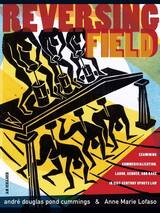 REVERSING FIELD: EXAMINING COMMERCIALIZATION, LABOR, GENDER, AND RACE IN 21ST CENTURY SPORTS LAW
edited by andré douglas pond cummings and Anne Marie Lofaso
West Virginia University Press, 2010 Reversing Field invites students, professionals, and enthusiasts of sport—whether law, management and marketing, or the game itself—to explore the legal issues and regulations surrounding collegiate and professional athletics in the United States. This theoretical and methodological interrogation of sports law openly addresses race, labor, gender, and the commercialization of sports, while offering solutions to the disruptions that threaten its very foundation during an era of increased media scrutiny and consumerism. In over thirty chapters, academics, practitioners, and critics vigorously confront and debate matters such as the Arms Race, gender bias, racism, the Rooney Rule, and steroid use, offering new thought and resolution to the vexing legal issues that confront sports in the 21st century.
Reversing the Gaze: What If the Other Were You?
Geneviève Makaping
Rutgers University Press, 2023 Tired of being scrutinized, criticized, and fetishized for her black skin, Cameroon-born scholar Geneviève Makaping turns the tables on Italy’s white majority, regarding them through the same unsparing gaze to which minorities have traditionally been subjected. As she candidly recounts her experiences—first across Africa and then as a migrant Black woman in Italy—Makaping describes acts of racist aggression that are wearying and degrading to encounter on a daily basis. She also offers her perspective on how various forms of inequality based on race, color, gender, and class feed off each other. Reversing the Gaze invites readers to confront the question of racism through the retelling of everyday occurrences that we might have experienced as victims, perpetrators, or witnesses.
Reversing the Lens: Ethnicity, Race, Gender, and Sexuality through Film
Jun Xing
University Press of Colorado, 2003 Reversing the Lens brings together noted scholars in history, anthropology, sociology, ethnic studies and film studies to promote film as a powerful classroom tool that can be used to foster cross-cultural communication with respect to race and ethnicity. Through such films as Skin Deep, Slaying the Dragon, and Mississippi Masala, contributors demonstrate why and how visual media help delineate various forms of "critical visual thinking" and examine how racialization is either sedimented or contested in the popular imagination. Not limited to classroom use, Reversing the Lens is relevant to anyone who is curious about how video and film can be utilized to expose race as a social construction in dialogue with other potential forms of difference and subject to political contestation.
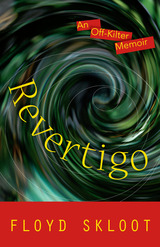 Revertigo: An Off-Kilter Memoir
Floyd Skloot
University of Wisconsin Press, 2014 One March morning, writer Floyd Skloot was inexplicably struck by an attack of unrelenting vertigo that ended 138 days later as suddenly as it had begun. With body and world askew, everything familiar had transformed. Nothing was ever still. Revertigo is Skloot’s account of that unceasingly vertiginous period, told in an inspired and appropriately off-kilter form.
This intimate memoir—tenuous, shifting, sometimes humorous—demonstrates Skloot’s considerable literary skill honed as an award-winning essayist, memoirist, novelist, and poet. His recollections of a strange, spinning world prompt further musings on the forces of uncertainty, change, and displacement that have shaped him from childhood to late middle age, repeatedly knocking him awry, realigning his hopes and plans, even his perceptions. From the volatile forces of his mercurial, shape-shifting early years to his obsession with reading, acting, and writing, from the attack of vertigo to a trio of postvertigo (but nevertheless dizzying) journeys to Spain and England, and even to a place known only in his mother’s unhinged fantasies, Skloot makes sense of a life’s phantasmagoric unpredictability.
Finalist, Sarah Winnemucca Award for Creative Nonfiction, Oregon Book Awards
Review of Biblical Literature, 2020
Alicia J. Batten
SBL Press, 2021 The annual Review of Biblical Literature presents a selection of reviews of the most recent books in biblical studies and related fields, including topical monographs, multi-author volumes, reference works, commentaries, and dictionaries. RBL reviews German, French, Italian, and English books and offers reviews in those languages.
Features:
- Reviews of new books written by top scholars
- Topical divisions make research easy
- Indexes of authors and editors, reviewers, and publishers
Review of Biblical Literature, 2021
Alicia J. Batten
SBL Press, 2022 The annual Review of Biblical Literature presents a selection of reviews of the most recent books in biblical studies and related fields, including topical monographs, multi-author volumes, reference works, commentaries, and dictionaries. RBL reviews German, French, Italian, and English books and offers reviews in those languages.
Review of Biblical Literature, 2022
Alicia J. Batten
SBL Press, 2022 The annual Review of Biblical Literature presents a selection of reviews of the most recent books in biblical studies and related fields, including topical monographs, multi-author volumes, reference works, commentaries, and dictionaries. RBL reviews German, French, Italian, and English books and offers reviews in those languages.
Review of Biblical Literature, 2023
Alicia J. Batten
SBL Press, 2023 The annual Review of Biblical Literature presents a selection of reviews of the most recent books in biblical studies and related fields, including topical monographs, multi-author volumes, reference works, commentaries, and dictionaries. RBL reviews German, French, Italian, and English books and offers reviews in those languages.
Review of Biblical Literature, 2024
Alicia J. Batten
SBL Press, 2024 The annual Review of Biblical Literature presents a selection of reviews of the most recent books in biblical studies and related fields, including topical monographs, multi-author volumes, reference works, commentaries, and dictionaries. RBL reviews German, French, Italian, and English books and offers reviews in those languages.
Review of Child Development Research: Volume 1
Lois Wladis Hoffman
Russell Sage Foundation, 1964 Makes a major contribution to current research on children by providing a broad view of up-to-date, authoritative material in many different areas. Contributors have selected and interpreted the relevant material in reference to the practitioner's interests and needs. The chapters, written by prominent specialists, cover various topics in child development from early periods of socialization to the development of higher mental processes, and include two chapters dealing with genetic and neurophysiological bases of behavior.
Review of Child Development Research: Volume 2
Lois Wladis Hoffman
Russell Sage Foundation, 1967 Makes a major contribution to current research on children by providing a broad view of up-to-date, authoritative material in many different areas. Contributors have selected and interpreted the relevant material in reference to the practitioner's interests and needs. The chapters, written by prominent specialists, cover various topics in child development from early periods of socialization to the development of higher mental processes, and include two chapters dealing with genetic and neurophysiological bases of behavior.
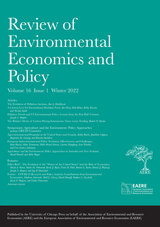 Review of Environmental Economics and Policy, volume 16 number 1 (Winter 2022)
The University of Chicago Press
University of Chicago Press Journals, 2022 This is volume 16 issue 1 of Review of Environmental Economics and Policy. The Review of Environmental Economics and Policy (REEP) is an official journal of the Association of Environmental and Resource Economists and the European Association of Environmental and Resource Economists. REEP publishes symposia, articles, and regular features that contribute to one or more of the following goals: to identify and synthesize lessons learned from recent and ongoing environmental economics research; to provide economic analysis of environmental policy issues; to promote the sharing of ideas and perspectives among the various sub-fields of environmental economics; to strengthen the linkages between environmental economics research and environmental policy; to encourage communication and connections between academics and the wider policy community; to offer suggestions for future research; to provide insights and readings for use in the classroom; to address issues of interest to the environmental economics profession.
 Review of Environmental Economics and Policy, volume 16 number 2 (Summer 2022)
The University of Chicago Press
University of Chicago Press Journals, 2022 This is volume 16 issue 2 of Review of Environmental Economics and Policy. The Review of Environmental Economics and Policy (REEP) is an official journal of the Association of Environmental and Resource Economists and the European Association of Environmental and Resource Economists. REEP publishes symposia, articles, and regular features that contribute to one or more of the following goals: to identify and synthesize lessons learned from recent and ongoing environmental economics research; to provide economic analysis of environmental policy issues; to promote the sharing of ideas and perspectives among the various sub-fields of environmental economics; to strengthen the linkages between environmental economics research and environmental policy; to encourage communication and connections between academics and the wider policy community; to offer suggestions for future research; to provide insights and readings for use in the classroom; to address issues of interest to the environmental economics profession.
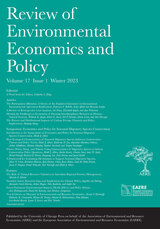 Review of Environmental Economics and Policy, volume 17 number 1 (Winter 2023)
The University of Chicago Press
University of Chicago Press Journals, 2023 This is volume 17 issue 1 of Review of Environmental Economics and Policy. The Review of Environmental Economics and Policy (REEP) is an official journal of the Association of Environmental and Resource Economists and the European Association of Environmental and Resource Economists. REEP publishes symposia, articles, and regular features that contribute to one or more of the following goals: to identify and synthesize lessons learned from recent and ongoing environmental economics research; to provide economic analysis of environmental policy issues; to promote the sharing of ideas and perspectives among the various sub-fields of environmental economics; to strengthen the linkages between environmental economics research and environmental policy; to encourage communication and connections between academics and the wider policy community; to offer suggestions for future research; to provide insights and readings for use in the classroom; to address issues of interest to the environmental economics profession.
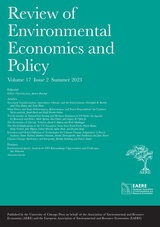 Review of Environmental Economics and Policy, volume 17 number 2 (Summer 2023)
The University of Chicago Press
University of Chicago Press Journals, 2023 This is volume 17 issue 2 of Review of Environmental Economics and Policy. The Review of Environmental Economics and Policy (REEP) is an official journal of the Association of Environmental and Resource Economists and the European Association of Environmental and Resource Economists. REEP publishes symposia, articles, and regular features that contribute to one or more of the following goals: to identify and synthesize lessons learned from recent and ongoing environmental economics research; to provide economic analysis of environmental policy issues; to promote the sharing of ideas and perspectives among the various sub-fields of environmental economics; to strengthen the linkages between environmental economics research and environmental policy; to encourage communication and connections between academics and the wider policy community; to offer suggestions for future research; to provide insights and readings for use in the classroom; to address issues of interest to the environmental economics profession.
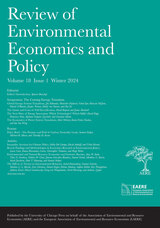 Review of Environmental Economics and Policy, volume 18 number 1 (Winter 2024)
The University of Chicago Press
University of Chicago Press Journals, 2024 This is volume 18 issue 1 of Review of Environmental Economics and Policy. The Review of Environmental Economics and Policy (REEP) is an official journal of the Association of Environmental and Resource Economists and the European Association of Environmental and Resource Economists. REEP publishes symposia, articles, and regular features that contribute to one or more of the following goals: to identify and synthesize lessons learned from recent and ongoing environmental economics research; to provide economic analysis of environmental policy issues; to promote the sharing of ideas and perspectives among the various sub-fields of environmental economics; to strengthen the linkages between environmental economics research and environmental policy; to encourage communication and connections between academics and the wider policy community; to offer suggestions for future research; to provide insights and readings for use in the classroom; to address issues of interest to the environmental economics profession.
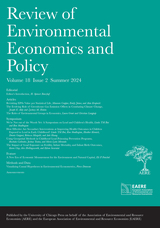 Review of Environmental Economics and Policy, volume 18 number 2 (Summer 2024)
The University of Chicago Press
University of Chicago Press Journals, 2024 This is volume 18 issue 2 of Review of Environmental Economics and Policy. The Review of Environmental Economics and Policy (REEP) is an official journal of the Association of Environmental and Resource Economists and the European Association of Environmental and Resource Economists. REEP publishes symposia, articles, and regular features that contribute to one or more of the following goals: to identify and synthesize lessons learned from recent and ongoing environmental economics research; to provide economic analysis of environmental policy issues; to promote the sharing of ideas and perspectives among the various sub-fields of environmental economics; to strengthen the linkages between environmental economics research and environmental policy; to encourage communication and connections between academics and the wider policy community; to offer suggestions for future research; to provide insights and readings for use in the classroom; to address issues of interest to the environmental economics profession.
 Review of Environmental Economics and Policy, volume 19 number 1 (Winter 2025)
The University of Chicago Press
University of Chicago Press Journals, 2025 This is volume 19 issue 1 of Review of Environmental Economics and Policy. The Review of Environmental Economics and Policy (REEP) is an official journal of the Association of Environmental and Resource Economists and the European Association of Environmental and Resource Economists. REEP publishes symposia, articles, and regular features that contribute to one or more of the following goals: to identify and synthesize lessons learned from recent and ongoing environmental economics research; to provide economic analysis of environmental policy issues; to promote the sharing of ideas and perspectives among the various sub-fields of environmental economics; to strengthen the linkages between environmental economics research and environmental policy; to encourage communication and connections between academics and the wider policy community; to offer suggestions for future research; to provide insights and readings for use in the classroom; to address issues of interest to the environmental economics profession.
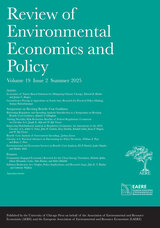 Review of Environmental Economics and Policy, volume 19 number 2 (Summer 2025)
The University of Chicago Press
University of Chicago Press Journals, 2025 This is volume 19 issue 2 of Review of Environmental Economics and Policy. The Review of Environmental Economics and Policy (REEP) is an official journal of the Association of Environmental and Resource Economists and the European Association of Environmental and Resource Economists. REEP publishes symposia, articles, and regular features that contribute to one or more of the following goals: to identify and synthesize lessons learned from recent and ongoing environmental economics research; to provide economic analysis of environmental policy issues; to promote the sharing of ideas and perspectives among the various sub-fields of environmental economics; to strengthen the linkages between environmental economics research and environmental policy; to encourage communication and connections between academics and the wider policy community; to offer suggestions for future research; to provide insights and readings for use in the classroom; to address issues of interest to the environmental economics profession.
(Re)viewing Creative, Critical and Commercial Practices in Contemporary Spanish Cinema
Edited by Duncan Wheeler and Fernando Canet
Intellect Books, 2014 Formulated around a number of key thematic concerns—new creative trends; the politics and practices of memory; auteurship, genre, and stardom in a transnational age—this reassessment of contemporary Spanish cinema from 1992 to 2012 brings leading academics from a broad range of disciplinary and geographical backgrounds into dialogue with critically and commercially successful practitioners to suggest the need to redefine the parameters of one of the world’s most creative national cinemas. This volume will appeal not only to students and scholars of Spanish film, but also to anyone with an interest in contemporary world cinema.
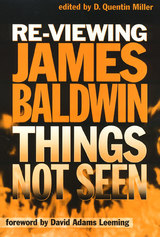 Re-Viewing James Baldwin
Quentin Miller
Temple University Press, 2000 This new collection of essays presents a critical reappraisal of James Baldwin's work, looking beyond the commercial success of some of Baldwin's early writings such as Go Tell It on the Mountain and Notes of a Native Son. Focusing on Baldwin's critically undervalued early works and the virtually neglected later ones the contributors illuminate little-known aspects of this daring author's work and highlight his accomplishments as an experimental writer. Attentive to his innovations in style and form, Re-Viewing James Baldwin reveals an author who continually challenged the notion of unity as he tackled matters of social justice, sexuality, and racial identity. As volume editor D. Quentin Miller notes, "what has been lost is a complete portrait of [Baldwin's] tremendously rich intellectual journey that illustrates the direction of African American thought and culture in the late twentieth century."
This is an important book for anyone interested in Baldwin's work. It will engage readers interested in literature and African American Studies.
A Revised Poetry of Western Philosophy
Daniel Grandbois
University of Pittsburgh Press, 2016 Bertrand Russell finds himself in purgatory, tumbling through literal representations of the worlds of ideas he examined in his classic text, A History of Western Philosophy, gulping much-needed air, for example, from Empedocles’ bucket. Mistaking his erection for a planted flag, he declares the place Platonopolis, attempts to calculate his Pythagorean number, kills God (though he later sees evidence of His resurrection), and, Rousseau-like, turns away from reason and civilization, favoring the noble savage, only to march back into the concrete jungle as one of Nietzsche’s savage nobles. In the end, however, he is all jumbled up and clucking like Einstein’s cuckoo clock, until he perceives philosophy as music, hears its arguments as a symphonic procession of the electrochemical pulses produced within three-pound lumps—lumps self-amalgamated from the vomitus of stars—and revises his History.
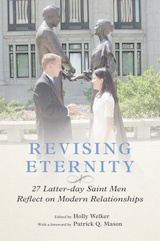 Revising Eternity: 27 Latter-day Saint Men Reflect on Modern Relationships
Edited by Holly Welker
University of Illinois Press, 2022 Marriage’s central role in The Church of Jesus Christ of Latter-day Saints distinguishes the faith while simultaneously reflecting widespread American beliefs. But what does Latter-day Saint marriage mean for men? Holly Welker presents a collection of essays exploring this question. The essayists provide insight into challenges involving sexuality, physical and emotional illness, addiction, loss of faith, infidelity, sexual orientation, and other topics. Conversational and heartfelt, the writings reveal the varied experiences of Latter-day Saint marriage against the backdrop of a society transformed by everything from economic issues affecting marriage to evolving ideas about gender. An insightful exploration of the gap between human realities and engrained ideals, Revising Eternity sheds light on how Latter-day Saint men view and experience marriage today.
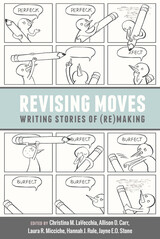 Revising Moves: Writing Stories of (Re)Making
Christina LaVecchia
Utah State University Press, 2024 Revision sometimes seems more metaphor than real, having been variously described as a stage, an act of goal setting, a method of correction, a process of discovery, a form of resistance. Revising Moves makes a significant contribution to writing theory by collecting stories of revision that honor revision’s vitality and immerse readers in rooms, life circumstances, and scenes where revision comes to life.
In these narrative-driven essays written by a wide range of writing professionals, Revising Moves describes revision as a messy, generative, and often collaborative act. These meditations reveal how revision is both a micro practice tracked by textual change and a macro phenomenon rooted in family life, institutional culture, identity commitments, and political and social upheaval. Contributors depict revision as a holistic undertaking and a radically contextualized, distributed practice that showcases its relationality to everything else. Authors share their revision processes when creating scholarly works, institutional and self-promoting documents, and creative projects. Through narrative the volume opens a window to what is often unseen in a finished text: months or years of work, life events that disrupt or alter writing plans, multiple draft changes, questions about writerly identity and positionality, layers of (sometimes contradictory) feedback, and much more.
 Revising Shakespeare
Grace Ioppolo
Harvard University Press, 1991 Every line of Shakespeare has been commented upon, revised, or deleted and reinstated many times over. His greatest contemporary, Ben Jonson, remarked that Shakespeare should have “blotted a thousand” lines himself; his greatest editor, Samuel Johnson, surveying the inability of previous editors to refrain from improving what they could not understand, attempted to restore Shakespeare's works “to their integrity.”
In Revising Shakespeare Grace Ioppolo addresses the question of Shakespeare's “integrity.” Through patient analysis of variant texts spanning the history of the plays, she arrives at a fresh interpretation of Shakespeare as author and reviser. Ioppolo starts where all of us—critics, teachers, textual scholars, and general readers—must start, with the physical text. As recent textual studies of King Lear have shown, the text of Shakespeare is not a given. The “text” is nearly always a revision of another text. Critics can no longer evaluate plots, structure, and themes, nor can scholars debate what constitutes (or how to establish) a copy-text that stands as the “most authoritative” version of a Shakespeare play, without reconsidering the implications of revision for traditional and modern interpretations.
Ioppolo examines the evidence provided by dramatic manuscripts and early printed texts of Shakespeare and his contemporaries. Gradually we see how a recognition of the diverse facts regarding authorial revision leads to basic changes in how we study, edit, and teach Shakespeare. Ioppolo places the textual revolution in a broad historical, theatrical, textual, and literary context, presenting textual studies that show Shakespeare and other Elizabethan and Jacobean dramatists at work revising themselves, their plays, and their audiences. She concludes that both textual and literary critics must now reevaluate and redefine the idea of the “text” as well as that of the “author”; the “text” is no longer editorially or theoretically composite or finite, but multiple and ever-revising. Perhaps most important, Ioppolo produces a new conception of Shakespeare as a creator and recreator, viewer and reviewer, writer and rewriter of his dramatic world.
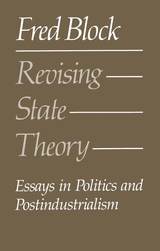 Revising State Theory: Essays in Politics and Postindustrialism
Fred Block
Temple University Press, 1987 Socialist Review Book Award, Socialist Review, 1987
This volume makes available in one place a complete statement of Fred Block's perspective for students and participants in the ongoing debate on state theory. His substantial Introduction serves as an intellectual autobiography in which he assesses the field-including the theories of Domhoff, Poulantzas, and Skocpoland situates his own work within it. Block also discusses his relationship to different strands of Marxism.
In his analysis of the relationship between business and the state, Block argues that while business interests have far more influence over state policy than other constituencies, state actors still have substantial autonomy in formulating policies. In particular, the business community's internal divisions and difficulties in assessing its own interests limit its capacity to control events. Block insists that when business influence is greatest, as during the Reagan years, state policies will be least successful in solving the society's problems.
"What is at work here is a relatively simple sociological dynamic--that institutionalized relations of power tend to become visible only when they weaken. When these institutionalized relations are most effective, they tend to be invisible, precisely because the justifying ideologies so dominate people's commonsense understandings. The classic recent example is the existence of women's subordination. In the fifties, people would have responded to the claim that women were systematically discriminated against in American society with incredulity because they had so totally accepted an ideology that justified differential treatment of men and women as normal and natural. The full-blown analysis and critique of male domination emerges only in the seventies, when patriarchal arrangements are already weakening....
"In state theory, the development is analogous. In the fifties, pluralist arguments dominate because the exercise of power has been rendered invisible. The relation between business and the state works so well that it leaves few traces. Moreover, there is little real debate about how the society should be structured, so the extent to which everyone's basic assumptions fit with the interests of corporate capitalism is not at all obvious. Since nobody was even asking the big questions of who should make investment decisions and how should income and wealth be distributed, it was not apparent that the narrow limits of debate fit exactly with the interests of business.... However, the cumulative impact of Vietnam and racial conflict in the late sixties, the drama of Watergate, and the growing economic difficulties of advanced capitalist societies in the early seventies served to make the exercise of power in American society widely visible. The previous functional relation between the state and business had been disrupted and the efforts by each side to advocate its own interests became more apparent."
--From the Introduction
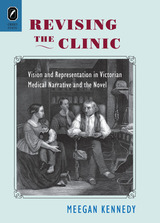 Revising the Clinic: Vision and Representation in Victorian Medical Narrative and the Novel
Meegan Kennedy
Ohio State University Press, 2010 Revising the Clinic: Vision and Representation in Victorian Medical Narrative and the Novel, by Meegan Kennedy, surveys hundreds of primary sources in a provocative new argument about visual knowledge. Kennedy argues that Victorian novelists and physicians jointly fret over “seeing and stating”: how to observe the world and how to record it. She shows how the clinical gaze and voice, never uncontested, function in medical texts and novels within a range of possible modes of vision and narration.
Critics have examined how novelists borrow from other genres—newspapers, legal cases, autobiographies. Medical writing likewise enriches the novel’s uniquely flexible and wide-ranging presentation of Victorian culture. In turn, the novel shapes medical narrative even as clinical science idealizes methodological rigor. Revising the Clinic shows how the wealth of scientific material in mainstream Victorian periodicals creates a productive literary “commons” where novelists and physicians can encounter each others’ strategies for seeing and stating. Novelists adapt physicians’ techniques to nonmedical scenes, and physicians echo the sentimental or sensational novel to gain sympathy or rhetorical force when medical knowledge falters.
Kennedy traces the development of the Victorian novel and the case history from eighteenth-century curious observation and curious sights through nineteenth-century clinical observation, mechanical observation, and speculation, to Freud’s labyrinthine mapping and speculative insight. These make new sense, read within the literary tradition of the case history. The lens of Kennedy’s argument clarifies and illuminates the preoccupation with genre and visuality that is common to Victorian medicine and the novel.
 Revising the Word and the World: Essays in Feminist Literary Criticism
Edited by Vèvè A. Clark, Ruth-Ellen Boetcher Joeres, and Madelon Sprengnether
University of Chicago Press, 1993 That literature is a form of social action has been an implicit assumption of feminist literary criticism since its emergence in academia some twenty-five years ago. This assumption has served not only to heighten the awareness of gender construction and response in literature, but also to redefine the process and goals of literary criticism itself.
Three powerful interviews with writers of different nationalities (Audre Lorde, Simone de Beauvoir, and Carmen Naranjo) introduce topics echoed in the essays that follow: the interplay between women's writing and feminist theory, the politics of writing, and the roles of race, class, and sexual orientation in artistic production. These issues are engaged on a theoretical level by three essays that represent today's most prominent areas of concern for feminist literary criticism. The theoretical perspectives advanced in this anthology provide models for reading the traditional expressions of women worldwide including oratory and performance as well as literature in the more conventional sense.
Contributors include Jane Flax on "Postmodernism and Gender Relations in Feminist Theory," Evelyn Brooks Higginbotham on "African-American Women's History and the Metalanguage of Race," Paula Bennett on "Female Sexual Imagery and Feminist Psychoanalytic Theory," Leslie Rabine on "Social Gender and Symbolic Gender in the Writings of Maxine Hong Kingston," Joyce Zonana on "Feminist Orientalism and the Structure of Jane Eyre," Jane Desmond on "Cultural Imperialism and Ruth St. Denis's 'Radha' of 1906," Terri Brint Joseph on "Poetry as a Strategy of Power: The Case of Riffian Berber Women," Chikwenye Ogunyemi on "The Contemporary Black Female Novel in English," and Sandra Zagarell on "Narrative of Community."
This collection is especially appropriate for scholars and students of feminist literary criticism, women's studies, English, and ethnic studies.
Essays were originally published in Signs: Journal of Women in Culture and Society.
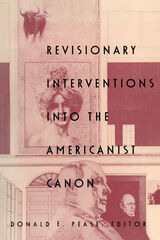 Revisionary Interventions into the Americanist Canon
Donald E. Pease
Duke University Press, 1994 Throughout the era of the Cold War a consensus reigned as to what constituted the great works of American literature. Yet as scholars have increasingly shown, and as this volume unmistakably demonstrates, that consensus was built upon the repression of the voices and historical contexts of subordinated social groups as well as literary works themselves, works both outside and within the traditional canon. This book is an effort to recover those lost voices. Engaging New Historicist, neo-Marxist, poststructuralist, and other literary practices, this volume marks important shifts in the organizing principles and self-understanding of the field of American Studies. Originally published as a special issue of boundary 2, the essays gathered here discuss writers as diverse as Kate Chopin, Frederick Douglass, Emerson, Melville, W. D. Howells, Henry James, W. E. B. DuBois, and Mark Twain, plus the historical figure John Brown. Two major sections devoted to the theory of romance and to cultural-historical analyses emphasize the political perspective of "New Americanist" literary and cultural study. Contributors. William E. Cain, Wai-chee Dimock, Howard Horwitz, Gregory S. Jay, Steven Mailloux, John McWilliams, Susan Mizruchi, Donald E. Pease, Ivy Schweitzer, Priscilla Wald, Michael Warner, Robert Weimann
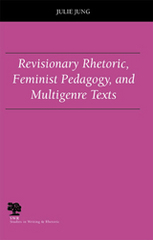 Revisionary Rhetoric, Feminist Pedagogy, and Multigenre Texts
Julie Jung
Southern Illinois University Press, 2005 In this precise and provocative treatise, Julie Jung augments the understanding and teaching of revision by arguing that the process should entail changing attitudes rather than simply changing texts. Revisionary Rhetoric, Feminist Pedagogy, and Multigenre Texts proposes and demonstrates alternative ways of reading, writing, and teaching that hear silences in such a way as to generate personal, pedagogical, and professional revisions. As both a challenge to prevailing revision pedagogies and an elaboration of contemporary feminist rhetorics, the volume encourages students and instructors to examine their identities as scholars of rhetoric and composition and to question how and why revision is taught.
Jung analyzes feminist texts to identify a revisionary rhetoric that is, at its core, most concerned with creating a space in which to engage productively with issues of difference. This synthesis of feminist theory and revision studies yields a pedagogically useful definition of feminist rhetoric, through which Jung examines the insights afforded by multigenre texts in various related contexts: the academic essay, the discipline of rhetoric and composition studies, feminist composition, and the subfields of English studies including rhetoric and composition, literature, and creative writing. Jung illustrates how multigenre texts demand innovative methods of inquiry because they do not fit the conventions of any single genre. Because genre is inextricably tied to the construction of social identity, she explains, multigenre texts also offer a means for understanding and revising disciplinary identity.
Boldly making a case for the revisionary power of multigenre texts, Jung retheorizes revision as a process of disrupting textual clarity so that differences can be identified, contended with, and perhaps understood. Revisionary Rhetoric, Feminist Pedagogy, and Multigenre Texts makes great strides towards defining feminist rhetoric and ascertaining how revision can be theorized, not just practiced. Jung also provides a multigenre epilogue that explores the usefulness of reconceiving revision as a progression towards wholeness rather than perfection.
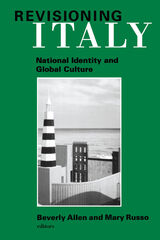 Revisioning Italy: National Identity and Global Culture
Beverly Allen
University of Minnesota Press, 1997 Explores Italian national identity. More than any other nation, Italy—from its imperial past to its subordinate present, from its colonial forays to its splendid isolation—embodies the myriad and contradictory historical forms of nationhood. This volume covers a range of subjects drawn from Italy and abroad to study the historical and contemporary formations of Italian national identity. In doing so, the work illuminates Italy past and present as well as the local and global dimensions of national identity in general. Whether considering opera or Ninja Turtles, these essays reveal how cultural identity is constructed and manipulated-an issue made urgent by the influx of African, Indochinese, and Eastern European immigrants into Italy today. Exile, nationalism, and imagined communities are the topics of several essays, including Antonio Negri’s reflection on his own experience of political militancy and exile. Others focus on Italy’s colonial “unconscious,” Mussolini’s adventures in North Africa, and racism from the late nineteenth century to the present. By analyzing Italy’s European and Mediterranean identities, its highly regional character, its north-south economic imbalance, and its ethnic complexity, this truly interdisciplinary volume resists the hierarchizing and monumentalizing of traditional Italian studies in the United States. It will inform and redirect our understanding of what constitutes “Italy.”Contributors: Mohamed Aden; John Agnew, Syracuse U; Ayele Bekerie, Cornell U; Elaine K. Chang, Rutgers U; Antonio Marazzi, U of Padua, Italy; Francesca Miller, U of California, Davis; Antonio Negri, U of Paris VIII, France; Graziella Parati, Dartmouth College; Karen Pinkus, Northwestern U; Paul Robinson, Stanford U; Pasquale Verdicchio, U of California, San Diego; Marguerite R. Waller, U of California, Riverside; and David Ward, Wellesley College.
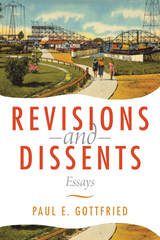 Revisions and Dissents: Essays
Paul E. Gottfried
Northern Illinois University Press, 2017 Paul Gottfried’s critical engagement with political correctness is well known. The essays in Revisions and Dissents focus on a range of topics in European intellectual and political history, social theory, and the history of modern political movements. With subjects as varied as Robert Nisbet, Whig history, the European Union election of 2014, and Donald Trump, the essays are tied together by their strenuous confrontation with historians and journalists whose claims about the past no longer receive critical scrutiny.
According to Gottfried, successful writers on historical topics take advantage of political orthodoxy and/or widespread ignorance to present questionable platitudes as self-evident historical judgments. New research ceases to be of importance in determining accepted interpretations. What remains decisive, Gottfried maintains, is whether the favored view fits the political and emotional needs of what he calls “verbalizing elites.” In this highly politicized age, Gottfried argues, it is necessary to re-examine these prevalent interpretations of the past. He does so in this engaging volume, which will appeal to general readers interested in political and intellectual history.
 Revisiting Childhood Resilience Through Marginalised and Displaced Voices: Perspectives from the Past and Present
Wendy Sims-Schouten
University College London, 2025 Resilience is more than survival—Wendy Sims-Schouten amplifies the resistant and transformative voices of marginalized and displaced children across history.
Revisiting Childhood Resilience Through Marginalised and Displaced Voices resists the way we think about resilience, shifting the focus from personal perseverance to the lived realities of children and young people pushed to society’s margins. Wendy Sims-Schouten moves beyond the familiar idea of resilience as individual grit, instead exploring how defiance and even compliance emerge as survival strategies for care leavers, bullied youth, ethnic minorities, and those with histories of migration and displacement.
Spanning one hundred and fifty years of personal and collective histories, this book brings together interdisciplinary research co-produced with those too often left out of resilience studies. By centering their voices, it unveils how resilience is shaped not just by inner strength, but by systemic barriers and the availability of support. Revisiting Childhood Resilience calls on policymakers and practitioners to rethink resilience as something far more complex than an individual trait; a process deeply rooted in context and agency.
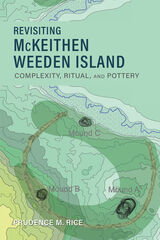 Revisiting McKeithen Weeden Island: Complexity, Ritual, and Pottery
Prudence M. Rice
University of Alabama Press, 2024 Reassesses the ancient Indigenous McKeithen site in northern Florida in light of new data, analyses, and theories Revisiting McKeithen Weeden Island further illuminates an Indigenous Late Woodland (ca. AD 200–900) mound-and-village community in northern Florida that was first excavated in the late 1970s. Since then, some artifacts received additional analyses, and the topic of prechiefdom societies has been broadly reconsidered in anthropology and archaeology. These developments allow new perspectives on McKeithen’s history and significance.
Prudence M. Rice, a Mayanist who began her career at the University of Florida, revisits what is known about McKeithen and recontextualizes the 1970s excavations. Weeden Island and McKeithen are best known through mortuary mounds and mortuary ritual, mainly involving unusual pottery bird effigies. Rice discusses current theoretical trends in studies of ritual and belief systems and their relation to mound-building at McKeithen in early stages of developing societal complexity. Revisiting McKeithen Weeden Island serves as a masterful example of an esteemed archaeologist advancing the field through rethought and updated interpretations of the site and its significance, primarily through its pottery. Rice’s case study ultimately also fosters understanding of later Mississippian society and other civilizations around the world at this time period. Archaeologists, anthropologists, and social historians as well as students and avocational readers will welcome Rice’s insight.
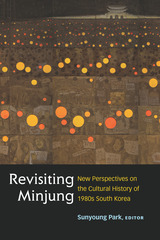 Revisiting Minjung: New Perspectives on the Cultural History of 1980s South Korea
Sunyoung Park, Editor
University of Michigan Press, 2019 An epoch-marking alliance of laborers, students, dissident intellectuals, and ordinary citizens was at the heart of South Korea’s transformation from a dictatorship into a vibrant democracy during the 1980s. Collectively known as the minjung (“the people”), these agents of Korean democratization historically carved out an expanded role for civil society in the country’s politics. In Revisiting Minjung, some of the foremost experts in 1980s Korean history, literature, film, art, and music provide new insights into one of the most crucial decades in South Korean history. Drawing from the theoretical perspectives of transnationalism, post-Marxist studies, intersectional feminism, popular culture studies, and more, the volume demonstrates how an era that is often associated with radical politics was, in effect, the catalyst for the subsequent flourishing of democratic and liberal values in South Korea.
Revisiting Minjung brings new themes, new subjectivities, and new theoretical perspectives to the study of the rich ecosystem of 1980s Korean culture. Treated here is a wide array of topics, including the origins of minjung ideology, its critique by the right wing, minjung art and music, workers’ literary culture, women writers and the resurgence of feminism, erotic cinema, science fiction, transnational political travels, and the representations of race and queerness in 1980s popular culture. The book thus details the origins and development of some of the movements that shape cultural life in South Korea today, and it does so through analyses that engage some of the most pressing debates in current scholarship in Korea and abroad.
Revisiting Moral Panics
Edited by Viviene E. Cree, Gary Clapton, and Mark Smith
Bristol University Press, 2015 We live in a world that is increasingly characterized as risky, dangerous, and threatening. Every day, a new social issue emerges seemingly designed to provoke a shared sense of panic. Drawing on the popular UK Economic Social and Research Council seminar series, this book uses the concept of moral panic to examine these social issues and anxieties and the solutions to them. With an introduction by Charles Critcher—coeditor of Moral Panics in the Contemporary World—and contributions from both well-known and up-and-coming researchers and practitioners, this book offers a stimulating and innovative overview of moral panic ideas for students and practitioners and an accessible introduction to the concept for a wider general public.
Revisiting Race in a Genomic Age
Koenig, Barbara
Rutgers University Press, 2008 With the completion of the sequencing of the human genome in 2001, the debate over the existence of a biological basis for race has been revived. In Revisiting Race in a Genomic Age, interdisciplinary scholars join forces to examine the new social, political, and ethical concerns that are attached to how we think about emerging technologies and their impact on current conceptions of race and identity. Essays explore a range of topics that include drug development and the production of race-based therapeutics, the ways in which genetics could contribute to future health disparities, the social implications of ancestry mapping, and the impact of emerging race and genetics research on public policy and the media. As genetic research expands its reach, this volume takes an important step toward creating a useful interdisciplinary dialogue about its implications.
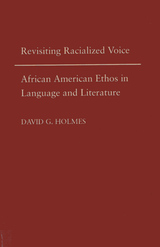 Revisiting Racialized Voice: African American Ethos in Language and Literature
David G. Holmes
Southern Illinois University Press, 2004 Revisiting Racialized Voice:African American Ethos in Language and Literature argues that past misconceptions about black identity and voice, codified from the 1870s through the 1920s, inform contemporary assumptions about African American authorship and ethos. Tracing elements of racial consciousness in the works of Frederick Douglass, Charles Chesnutt, W. E. B. DuBois, Zora Neale Hurston, and others, David G. Holmes urges a revisiting of narratives from this period to strengthen and advance notions about racialized writing and to shape contemporary composition pedagogies. Pointing to the intersection of African American identity, literature, and rhetoric, Revisiting Racialized Voice begins to construct rhetorically workable yet ideologically flexible definitions of black voice. Holmes maintains that political pressure to embrace“color blindness” endangers scholars’ ability to uncover links between racialized discourses of the past and those of the present, and he calls instead for a reassessment of the material realities and theoretical assumptions race represents and with which it has been associated.
 Revisiting Richardson
Rebecca Anne Barr
Bucknell University Press, 2025 The preoccupations of eighteenth-century novelist Samuel Richardson—the inequities of gender and sexuality; race and white femininity; masculinity, sadism, and control; religion and selfhood; authorship and artistic form—continue to resonate with contemporary readers. This fresh collection reconsiders his oeuvre, expanding and significantly updating critical debate on its meaning and importance. In these lively and engaging essays, contributors examine historically overlooked works, provide new readings of his best-known novels Pamela and Clarissa, and stake a serious claim for the importance of his final novel, Sir Charles Grandison. Diverse, inventive, and provocative, these essays demonstrate the complexity, relevance, and surprising legacies of Richardson’s novels and characters—finding traces in post-conceptual poetry, detective fiction, and in the fantasies of historical romance. Revisiting Richardson reflects on a decade of scholarship while delivering innovative perspectives on an author whose work continues to be indispensable for understanding the history of the novel.
Published by Bucknell University Press. Distributed by Rutgers University Press.
Revisiting the Essential Indexical
John Perry
CSLI, 2020 In this book, renowned philosopher John Perry responds to criticisms of his influential writing on “the essential indexical.” He begins by explaining the conclusions of his past articles. He then argues that many criticisms are based on confusions about the relation between the issues of opacity and cognitive significance, and other basic misunderstandings of his views. While dealing with criticisms, Perry makes a number of points about self-knowledge, the issue that motivated his original papers.
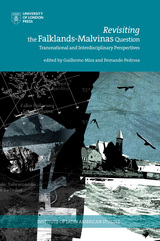 Revisiting the Falklands-Malvinas Question: Transnational and Interdisciplinary Perspectives
Edited by Guillermo Mira and Fernando Pedrosa
University of London Press, 2020 Almost forty years after the Falklands War, the causes and consequences of the military conflict between Argentina and the United Kingdom in 1982 still reverberate. The archipelago that makes up the Falkland-Malvinas Islands is surrounded by complexities and antagonisms—including controversy around its very name. This book interrogates the conflict with approaches from history, political science, sociology, film, and cultural studies. Additionally, this collection brings together English, Spanish, and Argentine specialists and researchers. It includes testimony from war veterans and exiles, essays on the films of Julio Cardoso, and Argentine patriotism as witnessed in contemporary literature and pedagogy. By taking up these different perspectives, Revisiting the Falklands-Malvinas Question moves beyond traditional approaches to the conflict based on nationalism, geopolitics, or military achievements, leading to a more expansive discussion.
Revisiting the Idea of Vocation: Theological Explorations
John C. Haughey, S.J.
Catholic University of America Press, 2004 Until recently theologians have been in a deep slumber about the subject of vocations. This volume represents one of the first awakenings in the theological community to this subject. The ten contributors, all theologians at Loyola University Chicago, present original essays that explore vocations, or callings.
Revisiting the Sixties: Interdisciplinary Perspectives on America's Longest Decade
Edited by Laura Bieger and Christian Lammert
Campus Verlag, 2013 The Vietnam War, the Cuban Missile Crisis, the Civil Rights Movement, and the Summer of Love—the 1960s were one of the most turbulent decades in US history. These years launched an unprecedented public debate over the meaning of “America,” dividing US society in deep and troubling ways. Yet despite the passage of time, the contemporary crises in the “American way of life” and the political system that sustain it might well make one wonder: to what degree are we still living on the outskirts of the '60s? By examining crucial events, trends, and individuals from the civic, social, political, intellectual, cultural, and economic spheres across a range of disciplines, this volume offers a nuanced and pluralist account of the longest decade in America.
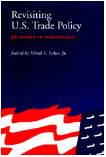 Revisiting U.S. Trade Policy: Decisions in Perspective
Alfred E. Eckes Jr.
Ohio University Press, 2000 In trade policy, as in many other areas of public policy, decision makers often confront present and future problems with little understanding of how similar disputes were resolved in the past. Too often, busy public officials had no time to write or record negotiating histories. Revisiting U.S. Trade Policy, which is certain to become a classic in the literature of trade negotiations, is just such a record. Built on the oral histories of thirty-five former U.S. trade policymakers—including Michael Blumenthal, Alonzo McDonald, William Roth, and Robert S. Strauss—this unique record, prepared for publication by Alfred E. Eckes, revisits some of the most important moments of America’s trade liberalization program in the years after World War II. From GATT to the World Trade Organization, these major players look back in candid hindsight at their decisions concerning trade policy and the effects that those decisions had on shaping the new international economic order.
 Revisiting Waldo's Administrative State: Constancy and Change in Public Administration
David H. Rosenbloom and Howard E. McCurdy, Editors
Georgetown University Press, 2006 The prevailing notion that the best government is achieved through principles of management and business practices is hardly new—it echoes the early twentieth-century "gospel of efficiency" challenged by Dwight Waldo in 1948 in his pathbreaking book, The Administrative State. Asking, "Efficiency for what?", Waldo warned that public administrative efficiency must be backed by a framework of consciously held democratic values. Revisiting Waldo's Administrative State brings together a group of distinguished authors who critically explore public administration's big ideas and issues and question whether contemporary efforts to "reinvent government," promote privatization, and develop new public management approaches constitute a coherent political theory capable of meeting the complex challenges of governing in a democracy. Taking Waldo's book as a starting point, the authors revisit and update his key concepts and consider their applicability for today. The book follows Waldo's conceptual structure, first probing the material and ideological background of modern public administration, problems of political philosophy, and finally particular challenges inherent in contemporary administrative reform. It concludes with a look ahead to "wicked" policy problems—such as terrorism, global warming, and ecological threats—whose scope is so global and complex that they will defy any existing administrative structures and values. Calling for a return to conscious consideration of democratic accountability, fairness, justice, and transparency in government, the book's conclusion assesses the future direction of public administrative thought. This book can stand alone as a commentary on reconciling democratic values and governance today or as a companion when reading Waldo's classic volume.
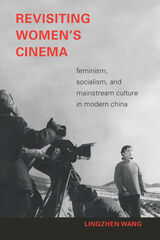 Revisiting Women's Cinema: Feminism, Socialism, and Mainstream Culture in Modern China
Lingzhen Wang
Duke University Press, 2021 In Revisiting Women’s Cinema, Lingzhen Wang ponders the roots of contemporary feminist stagnation and the limits of both commercial mainstream and elite minor cultures by turning to socialist women filmmakers in modern China. She foregrounds their sociopolitical engagements, critical interventions, and popular artistic experiments, offering a new conception of socialist and postsocialist feminisms, mainstream culture, and women’s cinema. Wang highlights the films of Wang Ping and Dong Kena in the 1950s and 1960s and Zhang Nuanxin and Huang Shuqin in the 1980s and 1990s to unveil how they have been profoundly misread through extant research paradigms entrenched in Western Cold War ideology, post-second-wave cultural feminism, and post-Mao intellectual discourses. Challenging received interpretations, she elucidates how socialist feminism and culture were conceptualized and practiced in relation to China’s search not only for national independence and economic development but also for social emancipation, proletarian culture, and socialist internationalism. Wang calls for a critical reevaluation of historical materialism, socialist feminism, and popular culture to forge an integrated emancipatory vision for future transnational feminist and cultural practices.
 Revista de Estudios de Género y Sexualidades 44, no. 1
Dianna C. Niebylski
Michigan State University Press Journals, 2018 In This Issue
Dianna C. Niebylski, "Editor’s Note"
Yamile Silva, "Presentación al Premio Victoria Urbano de Reconocimiento Académico"
Nina M. Scott, "Victoria Urbano Prize Acceptance Speech"
Artículos / Articles
Nadia Celis, "Entre el 'crimen atroz' y el 'amor terrible': Poder y violencia en Crónica de una muerte anunciada"
Etna Ávalos, "Discapacidad, feminismo y sexualidad en Sangre en el ojo de Lina Meruane"
Natalia Pérez, "The Sibila’s Gaze and Acoustic Space in Farsa del juego de cañas"
Anthony Pasero-O’Malley, "Disciplinary Practices and Synchronized Swimming in Mar Gómez Glez’s Bajo el agua"
Ana Almar Liante, "Cruising 'Campos de Castilla': prácticas queer del postporno transfeminista"
Entrevista / Interview
Ana Gallego Cuiñas y María Teresa Medeiros-Lichem, "Luisa Valenzuela: la escritura de la memoria"
Cerstin Bauer-Funke, "Entrevista a Carmen Resino, Juana Escabias y Diana de Paco: Contra la violencia de género y otras violencias"
Creación / Poetry and fiction
Juan Pablo Rivera, "En invierno la batalla"
Alexander Selimov, "Desafío y otros poemas"
Óscar Daniel Campo, "La vida ausente"
Reseñas / Reviews
Libros de crítica / Critical Works
Baranda, Nieves and Anne J. Cruz, Eds. The Routledge Research Companion to Early Modern Spanish Women Writers.
Reviewed by Ana Díaz Burgos
Cowan, Benjamin A. Securing Sex: Morality and Repression in the Making of Cold War Brazil.
Reviewed by Fernanda Righi
Dann Luna, Ilana. Adapting Gender. Mexican Feminisms from Literature to Film.
Reviewed by Etna Ávalos
Pritchett, Kay. Dark Assemblages: Pilar Pedraza and the Gothic Story of Development.
Reviewed by Nina L. Molinaro
Versteeg, Margot and Susan Walter. Approaches to Teaching the Writings of Emilia Pardo Bazán.
Reviewed by Marina Cuzovic-Severn
Libros de Creación / Creative Works
Escaja, Tina. Manual Destructivista/Destructivist manual.
Reviewed by Salvador Oropesa
Anuncios / Announcements
Colaboradores en este número / Contributors in this Issue
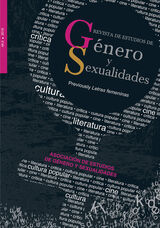 Revista de Estudios de Género y Sexualidades 44, no. 2
Dianna C. Niebylski
Michigan State University Press Journals, 2018 In This Issue
Dianna C. Niebylski, "Editor’s Note"
Artículo premiado / Award Winning Essay
Paola Uparela, "Guaman Poma y la güergüenza colonial"
Artículos / Articles
Xabier Granja Ibarreche, "La visión exculpatoria de la feminidad en Lágrimas de la nobleza de Luisa de Padilla"
Nagore Sedano, "Los muñecos de guiñol en las memorias de guerra de Aurora Arnáiz: una reformulación de la persona legal"
Katherine O. Stafford, "The Myth of Marisol in Twenty-First-Century Spanish Cultural Production"
Pedro A. Aguilera-Mellado, "¿Feminismo sin sujeto? Culpa, empoderamiento y nuevos feminismos"
Nina Longinovic, "Acting-Out Maternal Trauma Lola Arias’s Melancolía y manifestaciones (2012)"
Entrevista / Interview
Esther Fernández y Juan Hernando Vázquez, "Guerreras en escena: Paula Iwasaki y la 'nueva' voz de las heroínas clásicas"
Creación / Fiction and Poetry
Erika Almenara, "Gonal-F"
Reseñas / Book Reviews
Libros de Crítica / Critical Works
Báez, Jillian M. In Search of Belonging: Latinas, Media and Citizenship
Reviewed by Nancy Quintanilla
Camacho, Jorge. Mirtos de antaño y otros textos inéditos
Reviewed by Mercedes Fernández-Asenjo
Carrillo, Héctor. Pathways of Desire. The Sexual Migration of Mexican Gay Men
Reviewed by Iker González-Allende
LaGreca, Nancy. Erotic Mysticism: Subversion and Transcendence in Latin American Modernista Prose
Reviewed by Elisabeth L. Austin
Libros de Creación / Creative Works
Buzo Salas, Teresa. Adict@
Reiewed by Margarita Peraza-Rugeley
Evento / Event
XXIX Congreso de la Asociación de Estudios de Género y Sexualidades
Anuncios / Announcements
XXX Congreso de la Asociación de Estudios de Género y Sexualidades (AEGS)
Convocatoria de ensayos REGS 45.2 (2019)
Ganadores Premios Victoria Urbano 2019
Convocatoria de ensayos / Call for Papers
Colaboradores / Contributors
 Revista de Estudios de Género y Sexualidades 45, no. 1
Rocío Quispe-Agnoli
Michigan State University Press Journals, 2020 In This Issue
Número especial / Special Issue
Re-imagining Female Disabilities in Luso-Hispanic Women’s Cultural Production
Esther Fernández and Victoria L. Ketz, "Introduction: Reframing Female (Dis)abilities"
Montserrat Fuente-Camacho, "Eliminando invisibilidades: La sexualidad de las mujeres crip en Yes, We Fuck!"
Lilia Adriana Pérez Limón, "The Trouble with Fat: Excess and Desire in Mariana Villegas’s Este cuerpo mío"
Magdalena Maiz-Peña, "Geografías interiores, cuerpos-hablantes y texturas visuales de la depresión: El manifiesto corpóreo nepantlista de Laura Aguilar (1959-2018)"
Kathleen Honora Connolly, "Deaf Culture and the Performing Arts in Spain: Rozalén and La Niña de los Cupones"
Lennie Amores, "Disabled Housewives: Impairment in Emilia Pardo Bazán’s 'Las medias rojas' and 'El revólver'"
María de Alva, "Miradas y ojos reconstruidos a partir de accidentes, viajes y retornos en dos geografías: El cuerpo en que nací y Sangre en el ojo"
Yuliana M. Ramos Orta, "Trashed Beauty: Abjection and Burned Females in The Things We Lost in the Fire"
Ana Ugarte, "Hibris literaria, eco-autismo y empatía en La mujer que buceó dentro del corazón del mundo de Sabina Berman"
Maryanne L. Leone, "Reframing Disability through an Ecocritical Perspective in Sara Mesa’s Cara de pan"
Astrid Lorena Ochoa Campo, "Locura y discapacidad en Delirio de Laura Restrepo"
Luisa Marcela Ossa, "Inextricably Tied: Gender, Race, Chronic Illness, and Disability in the Works of Edelma Zapata Pérez"
Entrevista / Interview
Cristina Martínez-Carazo y Jessica Rodrigues Poletti, "Almudena Carracedo frente a su obra: Una reflexión sobre El silencio de otros"
Creación / Creative Works
Carol Arcos, Pechos dobles (Los míos)
 Revista de Estudios de Género y Sexualidades 45, no. 2
Rocío Quispe-Agnoli
Michigan State University Press Journals, 2020 In This Issue
Artículos / Articles
Silvia Encinas, "Rojo y negro: Feminismo con disimulo en las filas de Falange Española"
Esther Teixeira, "De la repetición naturalista en la literatura latinoamericana: Narrativa prostibularia y condición periférica en La novia oscura de Laura Restrepo"
Alexandra Rodríguez Sabogal, "Vírgenes y santas: Las devociones católicas en Nuestra Señora de la noche"
Claudia Berríos-Brown, "The sasachakuy tiempo: The Representation of Intersectional Violence in Literature of the Peruvian Armed Conflict (1980-2000)"
Ivelisse Santiago-Stommes, "Insilio, exilio y falsos idilios: Escritura, amor y nación en Domingo de revolución (2016) de Wendy Guerra"
Entrevista / Interview
María Antonia Anderson de la Torre, "La presencia de la voz femenina en la narrativa de Héctor Abad Faciolince"
Premios Victoria Urbano / Victoria Urbano Awards
Rocío Quispe-Agnoli, "Premios Victoria Urbano 2019"
Nieves Baranda Leturio, "Premio Victoria Urbano de Reconocimiento Académico 2019: Palabras de aceptación"
Yosie Crespo, "Premio Victoria Urbano de Creación 2019: 'Estrella de ocho puntas' y otros poemas"
Reseñas / Reviews
Smith, Stephanie J. The Power and Politics of Art in Postrevolutionary Mexico, reviewed by Paola Calahorrano
Miseres, Vanesa, Mujeres en tránsito: Viaje, identidad y escritura en Sudamérica (1830-1910), reviewed by Inés Corujo Martín
Arce, B. Christine. México’s nobodies: The Cultural Legacy of the Soldadera and Afro-Mexican Women, reviewed by Alice Edwards
Selimovic, Inela. Affective Moments in the Films of Martel, Carri, and Puenzo, reviewed by Traci Roberts-Camps xxx
Quispe-Agnoli, Rocío. Nobles de papel. Identidades oscilantes y genealogías borrosas en los descendientes de la realeza inca, reviewed by Yamile Silva
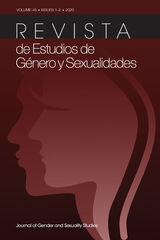 Revista de Estudios de Género y Sexualidades 46, nos. 1-2
Rocío Quispe-Agnoli
Michigan State University Press Journals, 2020 In This Issue
Prefacio de los editores / Editors’ Preface
Rocío Quispe-Agnoli, Ana Corbalán, and Vinodh Venkatesh, "'Estrella de ocho puntas': 45 años de Letras femeninas y la Revista de Estudios de Género y Sexualidades"
Artículos / Articles
Yamile Silva, "'I, humble servant of your grace': Isabel de Salazar’s and Ana de Nabarrete’s Petitions"
Emily Colbert Cairns, "Mother’s Breast is Best in Early Modern Spain"
Dale Shuger, "Resistance from the Right: Sor María de Ágreda and the Intersections of Early Modern Feminism"
Katherine Karr-Cornejo, "La esperanza en carne propia: El cuerpo sensorial en Tala y Lagar de Gabriela Mistral"
Ana Cruz García, "Imaginar ciudades: A Concrete Individual, an Imagined Community"
María Carpio-Manickam, "Reconstrucción del sujeto femenino mediante la desmitificación del narcotraficante en Perra brava de Orfa Alarcón"
Ruth Nelly Solarte González, "Testimonios sobre violencia sexual y delación: Víctimas/verdugos en la zona gris de la era Pinochet"
Osvaldo Sandoval-León, "La tortura silenciada: La violencia sexual en el teatro posdictadura del Cono Sur"
María Cami-Vela, "Summoning the Ghosts: Catalan Anti-Fascist Women’s Memory in El gran vuelo (The Great Flight, 2004)"
Verónica Dávila Ellis, "'¿Dónde están las yales?' Reggaetón and Womanhood in the Welfare Island"
Erin K. Hogan, "Specular Comedies of Manslaughter by Inés París and Marta Díaz de Lope Díaz"
Entrevistas / Interviews
Estrella Cibreiro, "La rebeldía, el empoderamiento y el compromiso ecofeminista en la escritura de Teresa Moure"
Eugenia Toledo-Keyser, "Marjorie Agosín: 'Tu luminoso anhelo de la vida'"
Creación / Creative Works
Marjorie Agosín, "Memorias trenzadas"
María de Alva, "Tunas verdes y rojas"
Premios Victoria Urbano / Victoria Urbano Awards
Rocío Quispe-Agnoli, "Premios Victoria Urbano 2020"
Reseñas / Reviews
Nieva-de la Paz, Pilar. Escritoras españolas contemporánes: identidad y vanguardia, reviewed by Suzette Acevedo-Loubriel
Estrada, Oswaldo. Troubled Memories: Iconic Mexican Women and the Traps of Representation, reviewed by Christina Baker
Ortega, Marie-Linda y Sylvie Turc-Zinopoulos. De la violence et des femmes: Espagne, 1808–1918. De la violencia y de las mujeres: España, 1808–1918, reviewed by Alfonso Bartolomé
Riera, Carme. Vengaré tu muerte, reviewed by Joan L. Brown
Bazant, Mílada. Laura Méndez de Cuenca. Mexican Feminist, 1853–1928, reviewed by Mercedes Fernández-Asenjo
Herrera, Cristina, and Paula Sanmartín. Reading-Speaking-Writing The Mother Text: Essays on Caribbean Women’s Writing, reviewed by Amarilis Hidalgo de Jesús
Alemán, Lídice. Construcción racial y de género en la poesía de la Revolución cubana, 1959–1980: Georgina Herrera, Excilia Saldaña y Soleida Ríos, reviewed by Carmen J. Jiménez
Misemer, Sarah M. Theatrical Topographies: Spatial Crises in Uruguayan Theater Post–2001, reviewed by Michelle Warren
 Revista de Estudios de Género y Sexualidades 47, no. 1
Rocío Quispe-Agnoli
Michigan State University Press Journals, 2021 In This Issue
Artículos | Articles
Vania Barraza, "El género ilimitado: Márgenes, rupturas y transgresiones en el cine luso-hispánico"
Stephany Slaughter, "Monstrous Femininity and Heroic Masculinity: 'El Santo' versus 'Las mujeres vampiro'”
Emanuelle K. F. Oliveira-Monte, "Queering Brazilian Horror: Race, Class, and Sexual Orientation in As boas maneiras (2017)"
Juli A. Kroll, "Contesting Waters: Queer Signifying in La ciénaga and La niña santa by Lucrecia Martel"
Maria Birgitta Clark, "Encrucijadas melodramáticas para una intervención feminista en Géminis de Albertina Carri"
Martín Ponti, "Miss Tacuarembó: The Transformation of Gender and Genre in Argentinian Musicals"
Álvaro Baquero-Pecino, "Entre la comedia migratoria y el cine de casting: Géneros y simulaciones en Latiner de Inés Gowland"
Kathryn A. Everly, "Destabilizing Gender and Genre: Queering the Body in Libertarias and Land and Freedom"
Yanire Márquez Etxabe, "La política del silencio y el exceso háptico-aural como representación del trauma en Elisa K"
Entrevista | Interview
Alejandra Márquez Guajardo, "Ya es hora: La mirada femenina en la producción cinematográfica de Alejandra Márquez Abella"
Creación | Creative Work
Yuliana M. Ramos Orta, "Transida"
Reseñas | Reviews
Aramburu, Diana. Resisting Invisibility: Detecting the Female Body in Spanish Crime Fiction, reviewed by Ana Belén Álvarez
Valenzuela, Luisa. “El Chiste de dios” y otros cuentos, reviewed by Diane E. Marting
Stavans, Ilan. Sor Juana: Or, the Persistence of Pop, reviewed by A. Margarita Peraza-Rugeley
Fetta, Stephanie. Shaming into Brown: Somatic Transactions of Race in Latina/o Literature, reviewed by Juan Pablo Rivera
Bautista Botello, Ester. Carmen Martín Gaite: Poetics, Visual Elements and Space, reviewed by Benjamín Romero Salado
Ugalde, Sharon Keefe. Ophelia: Shakespeare and Gender in Contemporary Spain, reviewed by Lynn C. Purkey
2020 Reviewers
 Revista de Estudios de Género y Sexualidades 47, no. 2
Rocío Quispe-Agnoli
Michigan State University Press Journals, 2021 Contenido / Contents
Artículos | Articles
Racialized Female Domesticity and Racial Passing in Eva Canel’s La mulata (1891)
Eva María Copeland
María Teresa León: Recuperating the Past, Refashioning the Present
Lynn C. Purkey
Orfismo, rosas y locura en “A imitação da rosa” de Clarice Lispector
Dinorah Cortés-Vélez
Antifémina: A New Femininity for the Democratic Transition
Caitlin Quintenz
Mujeres y canon literario en “El otro libro” de Luisa Valenzuela
Thérèse Courau
En el nombre de la matria: Salomé Ureña, Camila Henríquez Ureña y Julia Álvarez rescatan la nación
Beatriz M. Marqués
(Dis)Embodiment and Subject Formation in María Lourdes Pallais’s Prisionera de mi tío (2006)
Greg C. Severyn
The Fiction of Javier Payeras and the Neoliberal State: Framing Queerness in Postwar Guatemala
Andrew Bentley
Entrevistas | Interviews
Las miradas de Alicia Luna: sororidad y feminismo en el Gynocine
Yanire Márquez Etxabe
Los signos se trastocan: Los mundos pandémicos, colectivos y feministas de Carmen Boullosa
Amanda L. Petersen
Reseñas | Reviews
Agosín, Marjorie. Braided Memories / Memorias trenzadas
Reviewed by Eugenia Toledo-Keyser
Martín-Valdepeñas, Elisa and Catherine M. Jaffe. María Lorenza de los Ríos, Marquesa de Fuerte-Híjar. Vida y obra de una escritora del siglo de las luces
Reviewed by Xabier Granja Ibarreche
González Espitia, Juan Carlos. Sifilografía: A History of the Writerly Pox in the Eighteenth-Century Hispanic World
Reviewed by Giovanni Salazar-Calvo
Ferreira, César y Jorge Avilés Diz, eds. Narrar lo invisible: Aproximaciones al mundo literario de Sara Mesa
Reviewed by Francisca López
Polit Dueñas, Gabriela. Unwanted Witnesses. Journalists & Conflict in Contemporary Latin America
Reviewed by Giovanna Urdangarain
Di Francesco, Maria and Debra J. Ochoa, eds. Gender in Spanish Urban Spaces: Literary and Visual Narratives of the New Millenium
Reviewed by Montserrat Linares Farras
Hellín García, María José y Ana Corbalán Vélez, eds. Todos a movilizarse. Protesta y activismo social en la España del siglo XXI
Reviewed by Alba Fernández Fernández
 Revista de Estudios de Género y Sexualidades 48, no. 1
Rocío Quispe-Agnoli
Michigan State University Press Journals, 2022 Contenido / Contents
Tema especial | Special Topic
Yo llana estoy: Jerarquías, transgresiones y despliegues de género en América hispana colonial (1492–1898)
Yamile Silva y Ana María Díaz Burgos
Uses of the Will: Textual Agency of Andean and Mapuche Women in Colonial Santiago
Javiera Jaque Hidalgo
Prácticas heterodoxas y santidad queer: “El proceso de fe” (s. XVII) de las monjas clarisas de Trujillo
Margarita Paz Torres y Silvia Ruiz Tresgallo
“Yo llana estoy” o el despliegue de una virginidad queer
Paola Uparela
Bailadoras: Las mujeres y el fandango en España y la Nueva España del siglo XVIII
Elena Deanda-Camacho
Defensa y protección de la honra femenina a finales del virreinato novohispano: dos instituciones de caridad
Yolopattli Hernández-Torres
Artículos | Articles
Anarquismo y naturalismo en la obra temprana de Salvadora Medina Onrubia
Alejandra Karina Carballo
Teatro y sororidad: Maria Angélica Ribeiro en el campo cultural brasileño de mediados del siglo XIX
María Alejandra Aguilar Dornelles
Sobre un desfamiliarizado juego cubano: cine deportivo e infelicidad queer en La partida (2013)
Antonio Isea
Entrevistas | Interviews
La escritura de Tatiana Lobo Wiehoff: entre el archivo y la ficción
Ana María Díaz Burgos y Yamile Silva
Ylonka Nacidit-Perdomo: Poesía, recuperación y divulgación de escritoras y artistas dominicanas
Ana María Díaz Burgos y Yamile Silva
Creación | Creative Work
Premio Victoria Urbano de Creación 2021: “Mujer de nubes exiliada” y otros poemas
Susana Villanueva Eguía Lis
Reseñas | Reviews
Ângela de Azevedo. El muerto disimulado/Presumed Dead
Teresa Fernández-Ulloa
Bianco, Paola, María J. Fraser-Molina y María A. Salgado, eds. Mujeres con voz propia. Antología guiada
Karen Wooley Martin
Lewandowska, Julia. Escritoras monjas. Autoridad y autoría en la escritura conventual femenina de los Siglos de Oro
Gabriela Martínez Pérez
Lipsett-Rivera, Sonya. The Origins of Macho: Men and Masculinity in Colonial Mexico
Paola Calahorrano
Tompkins, Cynthia. Affectual Erasures: Representations of Indigenous Peoples in Argentine Cinema
Traci Roberts-Camps
Vera-Rojas, María Teresa. “Se conoce que usted es ‘Moderna’”: Lecturas de la mujer en la colonia hispana de Nueva York (1920–1940)
Amarilis Hidalgo de Jesús
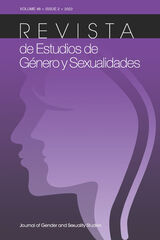 Revista de Estudios de Género y Sexualidades 48, no. 2
Rocío Quispe-Agnoli
Michigan State University Press Journals, 2022 In This Issue
Contenido | Contents
Artículos | Articles
Las mujeres y sus capitales
Elena Deanda-Camacho y Yolopattli Hernández-Torres
Mujeres sexualizadas, mujeres empoderadas: Capital erótico, poder y sexualidad en Los Borbones en pelota
Sara Muñoz-Muriana
El cuerpo enfermo nacional en Los Pazos de Ulloa (1886) y La madre naturaleza (1887)
Rafael Núñez Rodríguez
La desarticulación feminista del mito del progreso capitalista en Tea Rooms de Luisa Carnés
Priscila Calatayud-Fernández
Domesticity Amidst Devastation: Representations of Women’s Economic Roles in the Magazines of Early Francoism (1939–1948)
C.J. Enloe
Salir de casa: Trabajo sexual y subjetividades femeninas en novelas de Argentina y Brasil
Fernanda Righi
La mujer frente al capitalismo neoliberal en Feria de Ana Iris Simón (2020)
Olga Bezhanova
La descolonización del cuidado: Miriam Miranda y el activismo garífuna en Honduras
Irune del Rio Gabiola
Resistencias ambientalistas de mujeres indígenas: El feminismo decolonial latinoamericano y la ecología política feminista
Jozelin María Soto-Alarcón
Entrevista | Interview
Productoras feministas del Estado español: Miriam Porté
María Camí-Vela
Reseñas | Reviews
Hurtado, Aída and Mrinal Sinha. Beyond Machismo. Intersectional Latino Masculinities.
Meloddye Carpio Rios
Godón, Nuria. La pasión esclava: alianzas masoquistas en La Regenta.
Jennifer Smith
Rodríguez Gutiérrez, Milena. Casa en que nunca he sido extraña: Las poetas hispanoamericanas: identidades, feminismos, poéticas (Siglos XIX-XXI).
Yvette Fuentes
Ana Forcinito. Óyeme con los ojos: cine, mujeres, visiones y voces.
Inela Selimovic
García-Gorena, Velma, ed. and trans. Gabriela Mistral’s Letters to Doris Dana.
Lau Romero-Quintana
Triplette, Stacey. Chivalry, Reading, and Women’s Culture in Early Modern Spain: From Amadís de Gaula to Don Quixote.
Amarilis Hidalgo de Jesús
Shumway, Jeffrey M. A Woman, A Man, A Nation: Mariquita Sánchez, Juan Manuel de Rosas, and the beginnings of Argentina.
Graciela Michelotti
Reviewers
2021–2022 Reviewers
Revitalization in Asia: Adaptive Reuse in Macao, Mumbai, and Penang
Edited by Lavina Ahuja and Lynne D. DiStefano
Hong Kong University Press, 2025 Useful case studies on sustainability and revitalization in Asia.
Revitalization in Asia offers a clear understanding of the value of sustainable adaptive reuse within an Asian context. Three highly urbanized places—Macao, Mumbai, and Penang —are considered in detail through essays and timelines that examine both conservation and planning perspectives. Six essays look at the connection between adaptive reuse and the three dimensions of sustainability regarding the United Nations' Sustainable Development Goals. Additionally, for each location, five case studies offer a comparative framework for understanding similarities and differences between adaptive reuse projects.
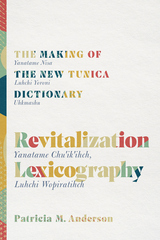 Revitalization Lexicography: The Making of the New Tunica Dictionary
Patricia M. Anderson
University of Arizona Press, 2020 In a linguistic climate that is hyperaware of so-called language death, dictionaries have been touted as stalwarts for language preservation. When wielded by communities undertaking language revitalization, dictionaries can be designed to facilitate reversing language shift and fostering linguistic innovation. Indeed, dictionaries’ reputation as multifunctional reference materials make them adaptable to a wide variety of community needs.
Revitalization Lexicography provides a detailed account of creating a dictionary meant to move a once-sleeping language into a language of active daily use. This unique look under the hood of lexicography in a small community highlights the ways in which the dictionary was intentionally leveraged to shape the Tunica language as it inevitably changes throughout revitalization. Tunica, one of the heritage languages of the Tunica-Biloxi Tribe of Marksville, Louisiana, has been undergoing active revitalization since 2010. The current generation of speakers began learning Tunica, a once-sleeping language, through written documentation. Now enough Tunica speakers to confer amongst themselves when questionable language use arises.
Marrying both the theoretical and the practical aspects that contributed to the Tunica dictionary, this book discusses complex lexicographic tasks in a manner accessible to both academic and community readers. This work is firmly backdropped in a fieldwork approach that centers the community as owners of all aspects of their revitalization project. This book provides concrete and practical considerations for anyone attempting to create a dictionary. Contrasting examples from Tunica and English dictionaries, this book challenges readers to rethink their relationship to dictionaries in general. A must-read for anyone who has ever touched a dictionary.
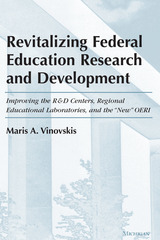 Revitalizing Federal Education Research and Development: Improving the R&D Centers, Regional Educational Laboratories, and the "New" OERI
Maris A. Vinovskis
University of Michigan Press, 2001 Over the past thirty years, the government has spent approximately $1.5 billion on the Regional Educational Laboratories and $1.1 billion on the Research and Development Centers. After this large investment, these two research facilities still have been unable to find the best way to effectively help at-risk children thrive in school. Many people are slowly realizing that, unfortunately, our sizable investment in educational research and development has not been sufficient to produce the kind of information that policymakers and educators must have if they hope to meet the needs of these at-risk children.
Maris A. Vinovskis uses the research he has done over the past decade, along with the findings of other policymakers, to argue that the American public school system needs to gain functional reform if research institutions are to conduct more effective studies for policymakers. He examines here both recent reform policies as well as the history behind educational reform.
Vinovskis's vigorous investigation of the process of educational research and development in the United States will be of particular interest to individuals whose careers depend on continued federal funding. This book will also appeal to educators, policymakers, and public policy analysts and will be of unequaled value in understanding the formulation of new educational policies in the twenty-first century.
Maris A. Vinovskis is active on Capitol Hill and lectures throughout the country at such prestigious institutions as the American Academy of Arts and Sciences, the Brookings Institution, and the John F. Kennedy School of Government at Harvard. He is Professor of History, University of Michigan.
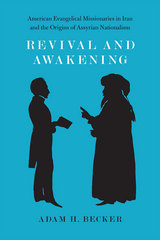 Revival and Awakening: American Evangelical Missionaries in Iran and the Origins of Assyrian Nationalism
Adam H. Becker
University of Chicago Press, 2015 Most Americans have little understanding of the relationship between religion and nationalism in the Middle East. They assume that the two are rooted fundamentally in regional history, not in the history of contact with the broader world. However, as Adam H. Becker shows in this book, Americans—through their missionaries—had a strong hand in the development of a national and modern religious identity among one of the Middle East's most intriguing (and little-known) groups: the modern Assyrians. Detailing the history of the Assyrian Christian minority and the powerful influence American missionaries had on them, he unveils the underlying connection between modern global contact and the retrieval of an ancient identity.
American evangelicals arrived in Iran in the 1830s. Becker examines how these missionaries, working with the “Nestorian” Church of the East—an Aramaic-speaking Christian community in the borderlands between Qajar Iran and the Ottoman Empire—catalyzed, over the span of sixty years, a new national identity. Instructed at missionary schools in both Protestant piety and Western science, this indigenous group eventually used its newfound scriptural and archaeological knowledge to link itself to the history of the ancient Assyrians, which in time led to demands for national autonomy. Exploring the unintended results of this American attempt to reform the Orient, Becker paints a larger picture of religion, nationalism, and ethnic identity in the modern era.
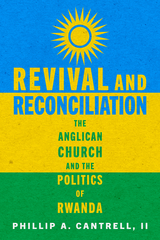 Revival and Reconciliation: The Anglican Church and the Politics of Rwanda
Phillip A. Cantrell II
University of Wisconsin Press, 2022 When Europe began colonizing Rwanda in the late nineteenth century, the Anglican Church played a significant and long-lasting role in controlling the colony through the Ruanda Mission. This informative volume shows how the church repeatedly aligned with the regime in power and failed to take account of its own history in fomenting ethnic tensions prior to the 1994 genocide. In recent years, the media has depicted Rwanda as a model of unity, development, and recovery, yet Phillip A. Cantrell II argues that not all is as it seems, as he takes a critical look at the church's complicity with authoritarian rule—from the Tutsi monarchy to the Rwandan Patriotic Front.
Drawing from new archival materials as well as on-the-ground field research, Revival and Reconciliation is a Rwanda-centered account of the country's ecclesiastical and national historiography. Cantrell calls attention to the harms the postgenocide church risks doing should it continue to support false narratives about Rwanda's colonial and postcolonial past—with dangerous consequences for the future.
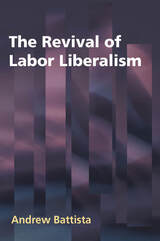 The Revival of Labor Liberalism
Andrew Battista
University of Illinois Press, 2008 The Revival of Labor Liberalism is a careful analysis of the twentieth-century decline of the labor-liberal coalition and the important efforts to revive their political fortunes. Andrew Battista chronicles the efforts of several new political organizations that arose in the 1970s and 1980s with the goal of reuniting unions and liberals. Drawing from extensive documentary research and in-depth interviews with union leaders and political activists, Battista shows that the new organizations such as the Progressive Alliance, Citizen Labor Energy Coalition, and National Labor Committee made limited but real progress in reconstructing and strengthening the labor-liberal coalition. Although the labor-liberal alliance remained far weaker than the rival business-conservative alliance, Battista illuminates that it held a crucial role in labor and political history after 1968. Focuses on a fraught but evolving partnership, Battista provides a broad analysis of factional divisions among both unions and liberals and considers the future of unionism and the labor-liberal coalition in America.
 The Revival of Metaphysical Poetry: The History of Style, 1800 to the Present
Joseph E. Duncan
University of Minnesota Press, 1959
The Revival of Metaphysical Poetry was first published in 1959. Minnesota Archive Editions uses digital technology to make long-unavailable books once again accessible, and are published unaltered from the original University of Minnesota Press editions.
The metaphysical style, as expressed in its most distinguished and distinguishable form by the seventeenth-century poet John Donne, has had an increasing influence on latterday critics and poets. Thus it is important to an understanding of literary history to examine this revival. Professor Duncan traces the movement and analyzes changing interpretations of the style in the work of British and American poets and critics. He shows that much of the "new criticism" and the metaphysical poetry of T. S. Eliot and that of the metaphysical style has thrived on fresh critical interpretation and vital poetic experimentation.
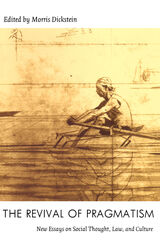 The Revival of Pragmatism: New Essays on Social Thought, Law, and Culture
Morris Dickstein, ed.
Duke University Press, 1998 Although long considered the most distinctive American contribution to philosophy, pragmatism—with its problem-solving emphasis and its contingent view of truth—lost popularity in mid-century after the advent of World War II, the horror of the Holocaust, and the dawning of the Cold War. Since the 1960s, however, pragmatism in many guises has again gained prominence, finding congenial places to flourish within growing intellectual movements. This volume of new essays brings together leading philosophers, historians, legal scholars, social thinkers, and literary critics to examine the far-reaching effects of this revival. As the twenty-five intellectuals who take part in this discussion show, pragmatism has become a complex terrain on which a rich variety of contemporary debates have been played out. Contributors such as Richard Rorty, Stanley Cavell, Nancy Fraser, Robert Westbrook, Hilary Putnam, and Morris Dickstein trace pragmatism’s cultural and intellectual evolution, consider its connection to democracy, and discuss its complex relationship to the work of Emerson, Nietzsche, and Wittgenstein. They show the influence of pragmatism on black intellectuals such as W. E. B. Du Bois, explore its view of poetic language, and debate its effects on social science, history, and jurisprudence. Also including essays by critics of the revival such as Alan Wolfe and John Patrick Diggins, the volume concludes with a response to the whole collection from Stanley Fish. Including an extensive bibliography, this interdisciplinary work provides an in-depth and broadly gauged introduction to pragmatism, one that will be crucial for understanding the shape of the transformations taking place in the American social and philosophical scene at the end of the twentieth century. Contributors. Richard Bernstein, David Bromwich, Ray Carney, Stanley Cavell, Morris Dickstein, John Patrick Diggins, Stanley Fish, Nancy Fraser, Thomas C. Grey, Giles Gunn, Hans Joas, James T. Kloppenberg, David Luban, Louis Menand, Sidney Morgenbesser, Richard Poirier, Richard A. Posner, Ross Posnock, Hilary Putnam, Ruth Anna Putnam, Richard Rorty, Michel Rosenfeld, Richard H. Weisberg, Robert B. Westbrook, Alan Wolfe
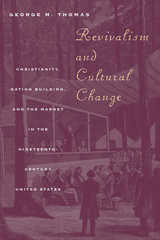 Revivalism and Cultural Change: Christianity, Nation Building, and the Market in the Nineteenth-Century United States
George M. Thomas
University of Chicago Press, 1989 The history of Christianity in America has been marked by recurring periods of religious revivals or awakenings. In this book, George M. Thomas addresses the economic and political context of evangelical revivalism and its historical linkages with economic expansion and Republicanism in the nineteenth century. Thomas argues that large-scale change results in social movements that articulate new organizations and definitions of individual, society, authority, and cosmos. Drawing on religious newspapers, party policies and agendas, and quantitative analyses of voting patterns and census data, he claims that revivalism in this period framed the rules and identities of the expanding market economy and the national policy.
"Subtle and complex. . . . Fascinating."—Randolph Roth, Pennsylvania History
"[Revivalism and Cultural Change] should be read with interest by those interested in religious movements as well as the connections among religion, economics, and politics."—Charles L. Harper, Contemporary Sociology
"Readers old and new stand to gain much from Thomas's sophisticated study of the macrosociology of religion in the United States during the nineteenth century. . . . He has given the sociology of religion its best quantitative study of revivalism since the close of the 1970s."—Journal for the Scientific Study of Religion
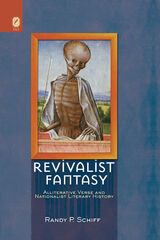 Revivalist Fantasy: Alliterative Verse and Nationalist Literary History
Randy P. Schiff
Ohio State University Press, 2011 Revivalist Fantasy: Alliterative Verse and Nationalist Literary History by Randy P. Schiff contributes to recent conversations about disciplinary history by analyzing the nationalist context for scholars and editors involved in disseminating the literary historical theory of an Alliterative Revival. Redirecting Alliterative Revivalism’s backward gaze, Revivalist Fantasy re-engages with the local contexts of select alliterative works.
Schiff revises readings of alliterative poetry as Francophobic, exploring the transnational imperialist elitism in the translation William of Palerne. He contributes to the discussion of gender in Sir Gawain and the Green Knight by linking the poem’s powerful female players with anxieties about women’s control of wealth and property in militarized regions of England. The book also explores the emphatically pre-national, borderlands sensibilities informing the Awntyrs off Arthure and Golagros and Gawane, and it examines the exploitation of collaborative composition in the material legacy of the Piers Plowman tradition.
Revivalist Fantasy concludes that Revivalist nationalism obscures crucial continuities between late-medieval and post-national worlds and that critics’ interests should be channeled into the forging of connections between past and present rather than suspended in the scholarly pursuit of origins. The book will be of interest to scholars of editorial history and translation studies and to those interested in manuscript studies.
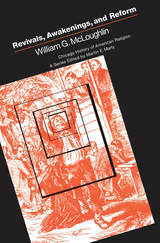 Revivals, Awakening and Reform
William G. McLoughlin
University of Chicago Press, 1980 In Revivals, Awakenings, and Reform, McLoughlin draws on psychohistory, sociology, and anthropology to examine the relationship between America's five great religious awakenings and their influence on five great movements for social reform in the United States. He finds that awakenings (and the revivals that are part of them) are periods of revitalization born in times of cultural stress and eventuating in drastic social reform. Awakenings are thus the means by which a people or nation creates and sustains its identity in a changing world.
"This book is sensitive, thought-provoking and stimulating. It is 'must' reading for those interested in awakenings, and even though some may not revise their views as a result of McLoughlin's suggestive outline, none can remain unmoved by the insights he has provided on the subject."—Christian Century
"This is one of the best books I have read all year. Professor McLoughlin has again given us a profound analysis of our culture in the midst of revivalistic trends."—Review and Expositor
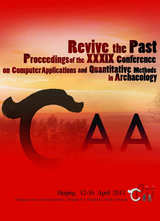 Revive the Past: Proceedings of the 39th Conference of Computer Applications and Quantitative Methods in Archaeology
Edited by Philip Verhagen
Amsterdam University Press, 2014 The present volume consists of the peer-reviewed papers presented at the CAA2011 conference held in Beijing, China between April 12 and 16, 2011. The theme of this conference was -Revive the Past , which means retrieving our history and using it to help create a new civilization. It was a great honour to organize the conference where over 130 researchers made presentations; ten keynote speeches were given; and sixteen sessions covered a wide variety of topics: data acquisition and recording, conceptual modelling, data analysis, data management, digging with words, 3D models, visualizing heritage sites, digital spaces for archaeology, geophysics, GIS, graphics in archaeology, visualisation in archaeology, semantic technologies, spatial prediction, visualization and exhibition, and 3D object reconstruction. In addition, student papers and posters were presented.
 Reviving Jonathan Edwards: Perry Miller’s Mid-Century Mission
Stephen D. Crocco
University of Massachusetts Press, 2026 The untold story of how an unlikely Harvard atheist helped resurrect one of America’s greatest Puritans
Jonathan Edwards is widely regarded as one of America’s most important and original thinkers. Prior to the mid-twentieth century, however, he was largely unknown to the learned community, except, perhaps, as a preacher of terror due to his well-known sermon, “Sinners in the Hands of an Angry God.” In 1948 and 1949, Harvard professor of English Perry Miller published four pieces on him, including the acclaimed biography, Jonathan Edwards, and only a few years later he became the general editor of Edwards’s collected works. Miller’s efforts helped to resurrect Edwards as America’s greatest Puritan and to solidify him as central to the American experience, and their names have been closely intertwined ever since.
Miller, an iconoclastic scholar widely considered to be the founder of American studies, was known for his brilliant scholarship, devoted teaching, and hard living. Dying prematurely in 1963, he remains an enigmatic and controversial figure, with no biography available. In Reviving Jonathan Edwards, Stephen D. Crocco explores why this Harvard atheist, with an eerie sense that his time was short, delayed work on his planned magnum opus—a sweeping intellectual history of early America—to edit the works of the greatest of all American Puritans.
In a riveting history that combines biographical insight with a detailed look into mid-century academia, Crocco draws on a large body of unpublished correspondence to offer an intricate detective tale of a decades-long publishing endeavor. He provides fresh portraits of Miller and the editorial committee he assembled, which included Sydney Ahlstrom, Roland Bainton, H. Richard Niebuhr, Norman Holmes Pearson, Paul Ramsey, and John E. Smith, and follows the story long after Miller’s death, tracing the repeated, sometimes seemingly intractable challenges that publishing the many volumes on Edwards’s work faced. He concludes by tracing Edwards studies up to 2003, the 300th anniversary of his birth, when the quiet revival of this colonial minister had evolved into a full scholarly renaissance.
 Reviving Jonathan Edwards: Perry Miller’s Mid-Century Mission
Stephen D. Crocco
University of Massachusetts Press, 2026 The untold story of how an unlikely Harvard atheist helped resurrect one of America’s greatest Puritans
Jonathan Edwards is widely regarded as one of America’s most important and original thinkers. Prior to the mid-twentieth century, however, he was largely unknown to the learned community, except, perhaps, as a preacher of terror due to his well-known sermon, “Sinners in the Hands of an Angry God.” In 1948 and 1949, Harvard professor of English Perry Miller published four pieces on him, including the acclaimed biography, Jonathan Edwards, and only a few years later he became the general editor of Edwards’s collected works. Miller’s efforts helped to resurrect Edwards as America’s greatest Puritan and to solidify him as central to the American experience, and their names have been closely intertwined ever since.
Miller, an iconoclastic scholar widely considered to be the founder of American studies, was known for his brilliant scholarship, devoted teaching, and hard living. Dying prematurely in 1963, he remains an enigmatic and controversial figure, with no biography available. In Reviving Jonathan Edwards, Stephen D. Crocco explores why this Harvard atheist, with an eerie sense that his time was short, delayed work on his planned magnum opus—a sweeping intellectual history of early America—to edit the works of the greatest of all American Puritans.
In a riveting history that combines biographical insight with a detailed look into mid-century academia, Crocco draws on a large body of unpublished correspondence to offer an intricate detective tale of a decades-long publishing endeavor. He provides fresh portraits of Miller and the editorial committee he assembled, which included Sydney Ahlstrom, Roland Bainton, H. Richard Niebuhr, Norman Holmes Pearson, Paul Ramsey, and John E. Smith, and follows the story long after Miller’s death, tracing the repeated, sometimes seemingly intractable challenges that publishing the many volumes on Edwards’s work faced. He concludes by tracing Edwards studies up to 2003, the 300th anniversary of his birth, when the quiet revival of this colonial minister had evolved into a full scholarly renaissance.
 Reviving Liberty: Radical Christian Humanism in Milton’s Great Poems
Joan S. Bennett
Harvard University Press, 1989 Milton’s Great Poems—Paradise Lost, Paradise Regained, and Samson Agonistes—are here examined in the light of his lifelong commitment to the English revolutionary cause. The poems, Joan Bennett shows, reflect the issues Milton had dealt with in theological and public policy debate, foreign diplomacy, and propaganda; moreover, they work innovatively with these issues, reaching in epic and tragedy answers that his pamphlets and tracts of the past twenty years had only partially achieved. The central issue is the nature and possibility of human freedom, or “Christian liberty.” Related questions are the nature of human rationality, the meaning of law, of history, of individuality, of society, and—everywhere—the problem of evil.
The book offers a revisionist position in the history of ideas, arguing that Renaissance Christian humanism in England descended not from Tudor to Stuart Anglicanism but from Tudor Anglicanism to revolutionary Puritanism. Close readings are offered of texts by Richard Hooker, Milton, and a range of writers before and during the revolutionary period. Not only theological and political positions but also political actions taken by the authors are compared. Milton's poems are studied in the light of these analyses.
The concept of “radical Christian humanism” moves current Milton criticism beyond the competing conceptions of Milton as the poet of democratic liberalism and the prophet of revolutionary absolutism. Milton's radical Christian humanism was built upon pre-modern conceptions and experiences of reason that are not alien to our time. It stemmed from, and resulted in, a religious commitment to political process which his poems embody and illuminate.
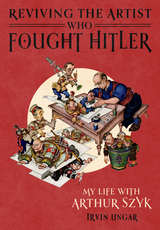 Reviving the Artist Who Fought Hitler: My Life with Arthur Szyk
Irvin Ungar
University of Texas Press, 2026 The intertwining story of a noted anti-Nazi artist and the former rabbi who revived his reputation. During World War II, the Polish-Jewish immigrant Arthur Szyk became America’s leading anti-Nazi artist. His art was so effective that Adolf Hitler reportedly put a bounty on his head while the US military declared him a “citizen-soldier” of the free world. Szyk steadfastly fought for the rescue of European Jewry during the Holocaust, creating artworks like De Profundis, which imagines Jesus sharing the suffering of countless lifeless Jews. His civil rights art challenged segregation and his illuminated Declaration of Independence resides in the Library of Congress. Szyk’s masterwork, an illustrated Passover Haggadah, is considered by many to be one of the most beautiful books ever produced by human hands. Once world-famous, Arthur Szyk was all but forgotten after his death in 1951. Reviving the Artist Who Fought Hitler recounts Irvin Ungar's decades-long journey to restore Szyk to public consciousness, and become the principal collector, dealer, scholar, and promoter of Szyk’s art in the United States, Europe, and Israel. Richly illustrated and full of forgotten history, this memoir is an inspiring story of artistic passion and an invitation to commune with a heroic advocate for all humanity.
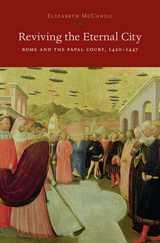 Reviving the Eternal City: Rome and the Papal Court, 1420-1447
Elizabeth McCahill
Harvard University Press, 2013 In 1420, after more than one hundred years of the Avignon Exile and the Western Schism, the papal court returned to Rome, which had become depopulated, dangerous, and impoverished in the papacy's absence. Reviving the Eternal City examines the culture of Rome and the papal court during the first half of the fifteenth century, a crucial transitional period before the city's rebirth. As Elizabeth McCahill explains, during these decades Rome and the Curia were caught between conflicting realities--between the Middle Ages and the Renaissance, between conciliarism and papalism, between an image of Rome as a restored republic and a dream of the city as a papal capital.
Through the testimony of humanists' rhetorical texts and surviving archival materials, McCahill reconstructs the niche that scholars carved for themselves as they penned vivid descriptions of Rome and offered remedies for contemporary social, economic, religious, and political problems. In addition to analyzing the humanists' intellectual and professional program, McCahill investigates the different agendas that popes Martin V (1417-1431) and Eugenius IV (1431-1447) and their cardinals had for the post-Schism pontificate. Reviving the Eternal City illuminates an urban environment in transition and explores the ways in which curialists collaborated and competed to develop Rome's ancient legacy into a potent cultural myth.
 Rêvoir
Hélène Cixous
Seagull Books, 2024 A genre-defying account of confinement and its literary echoes through history.
As the pandemic sweeps through Paris in March 2020, the writer HC faces a choice: stay in Paris or flee to the countryside? The weight of historical responses bears down on her—those of her ancestors and Jewish writers during moments of persecution.
Still uncertain, she flees to the country at the last moment, with her cats and her daughter, with her diaries and notebooks. What will she do here? Write? What will she write about? Can she write about the experience of being confined? She will write about her cats; every day she will observe their lives and take notes about how they cope with being housebound, and later, in the spring, with the outdoors.
Thucydides, Defoe, Camus, Kafka—she will compare her experiences with those of others who have been confined by malady or persecution. She will write of her mother, who fled impending disaster on many occasions and always kept a suitcase ready.
She too will endure. The important thing is to have a good death, surrounded by those she loves, not locked down in a hospital.
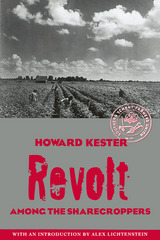 Revolt Among The Sharecroppers
Howard Kester
University of Tennessee Press, 1997 This paperback facsimile edition restores to print Howard Kester’s Revolt among the Sharecroppers, a lost classic of southern radicalism. First published in 1936, Kester’s brief, stirring book provides a dramatic eyewitness account of the origins of the Southern Tenant Farmers’ Union (STFU), the Arkansas Delta sharecroppers’ organization whose cause was championed by religious radicals and socialists during the 1930s. Accompanying Kester’s original text is a substantial new introductory essay by historian Alex Lichtenstein.
This edition will introduce general readers, scholars, and students to a social movement with significant historical implications. In its commitment to interracialism, the STFU challenged long-standing southern traditions. In its hostility to the agricultural recovery programs of the 1930s (which tended to benefit landowners at the expense of tenant farmers), the union offered an early critique of New Deal liberalism. And, finally, in its insistence that the dispossessed could assume control of their own destiny, the STFU foreshadowed the progressive social movements of the 1960s. Thus, Revolt among the Sharecroppers is an important primary document that makes a signal contribution to our understanding of labor history, African American history, and the history of Depression-era America.
Kester’s text recounts the early history of the STFU and its criticisms of the New Deal in compelling, accessible prose. Lichtenstein’s introduction offers biographical background on Kester, explores the religious and socialist beliefs that led him to work with the STFU, describes the racial and social climate that shaped the union’s emergence, places the union’s rise and decline within the context of 1930s politics, and outlines the legacy of this remarkable organization.
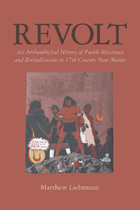 Revolt: An Archaeological History of Pueblo Resistance and Revitalization in 17th Century New Mexico
Matthew Liebmann
University of Arizona Press, 2014 Published in cooperation with the William P. Clements Center for Southwest Studies, Southern Methodist University.
The Pueblo Revolt of 1680 is the most renowned colonial uprisings in the history of the American Southwest. Traditional text-based accounts tend to focus on the revolt and the Spaniards' reconquest in 1692—completely skipping over the years of indigenous independence that occurred in between. Revolt boldly breaks out of this mold and examines the aftermath of the uprising in colonial New Mexico, focusing on the radical changes it instigated in Pueblo culture and society. In addition to being the first book-length history of the revolt that incorporates archaeological evidence as a primary source of data, this volume is one of a kind in its attempt to put these events into the larger context of Native American cultural revitalization. Despite the fact that the only surviving records of the revolt were written by Spanish witnesses and contain certain biases, author Matthew Liebmann finds unique ways to bring a fresh perspective to Revolt. Most notably, he uses his hands-on experience at Ancestral Pueblo archaeological sites—four Pueblo villages constructed between 1680 and 1696 in the Jemez province of New Mexico—to provide an understanding of this period that other treatments have yet to accomplish. By analyzing ceramics, architecture, and rock art of the Pueblo Revolt era, he sheds new light on a period often portrayed as one of unvarying degradation and dissention among Pueblos. A compelling read, Revolt's "blood-and-thunder" story successfully ties together archaeology, history, and ethnohistory to add a new dimension to this uprising and its aftermath.
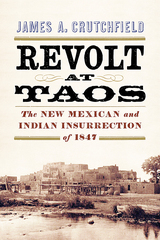 Revolt at Taos: The New Mexican and Indian Insurrection of 1847
James A. Crutchfield
Westholme Publishing, 2025 An Uprising by New Mexicans and Native Americans Against American Rule that Continues to Resonate Today
On the morning of January 19, 1847, Charles Bent, the newly appointed governor of the American-claimed territory of New Mexico, was savagely killed at his home in Don Fernando de Taos, a small, remote town located north of Santa Fe. Those responsible for Bent’s murder were New Mexican settlers and Indians from nearby Taos Pueblo who refused to recognize the United States occupation. With emotions rubbed raw, the natives continued their bloodbath until five more leading citizens were massacred in Taos. During the ensuing months, American civilians and soldiers, along with scores of New Mexicans and Taos Indians, were killed and wounded throughout the region. Less than a month following Bent’s murder, in a two-day battle, volunteer and regular elements of an American army under the command of Colonel Sterling Price emerged victorious after bombarding the insurrectionists at their refuge in the church at Taos Pueblo. Surviving participants in the earlier Taos murders were arrested, tried in American-dominated courts, and, within weeks, hanged for their actions. The murder of Bent and the others at Taos and the subsequent trials and executions brought with them misunderstanding, controversy, mistrust, and recrimination on both sides of the issue. The events also subjected President James K. Polk’s administration to censure over what some critics believed was an overextension of presidential authority in claiming New Mexico as a territory.
In Revolt at Taos: The New Mexican and Indian Insurrection of 1847, writer and historian James A. Crutchfield explores the fast-moving events surrounding the bloody revolt which left native inhabitants of New Mexico wondering how their neighbors and kinsmen could be legally tried, found guilty, and executed for acts they considered to have been honorable ones committed in defense of their country. These concerns have never been adequately addressed and their struggle has been all but scrubbed from the history of American expansion.
The Revolt of the Black Athlete: 50th Anniversary Edition
Harry Edwards
University of Illinois Press, 2017 The Revolt of the Black Athlete hit sport and society like an Ali combination. This Fiftieth Anniversary edition of Harry Edwards's classic of activist scholarship arrives even as a new generation engages with the issues he explored. Edwards's new introduction and afterword revisit the revolts by athletes like Muhammad Ali, Kareem Abdul-Jabbar, Tommie Smith, and John Carlos. At the same time, he engages with the struggles of a present still rife with racism, double-standards, and economic injustice. Again relating the rebellion of black athletes to a larger spirit of revolt among black citizens, Edwards moves his story forward to our era of protests, boycotts, and the dramatic politicization of athletes by Black Lives Matter. Incisive yet ultimately hopeful, The Revolt of the Black Athlete is the still-essential study of the conflicts at the interface of sport, race, and society.
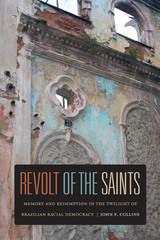 Revolt of the Saints: Memory and Redemption in the Twilight of Brazilian Racial Democracy
John F. Collins
Duke University Press, 2015 In 1985 the Pelourinho neighborhood in Salvador, Brazil was designated as a UNESCO World Heritage Site. Over the next decades, over 4,000 residents who failed to meet the state's definition of "proper Afro-Brazilianness" were expelled to make way for hotels, boutiques, NGOs, and other attractions. In Revolt of the Saints, John F. Collins explores the contested removal of the inhabitants of Brazil’s first capital and best-known site for Afro-Brazilian history, arguing that the neighborhood’s most recent reconstruction, begun in 1992 and supposedly intended to celebrate the Pelourinho's working-class citizens and their culture, revolves around gendered and racialized forms of making Brazil modern. He situates this focus on national origins and the commodification of residents' most intimate practices within a longer history of government and elite attempts to "improve" the citizenry’s racial stock even as these efforts take new form today. In this novel analysis of the overlaps of race, space, and history, Collins thus draws on state-citizen negotiations of everyday life to detail how residents’ responses to the attempt to market Afro-Brazilian culture and reimagine the nation’s foundations both illuminate and contribute to recent shifts in Brazil’s racial politics.
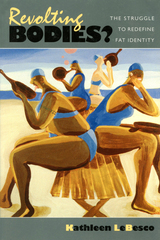 Revolting Bodies?: The Struggle to Redefine Fat Identity
Kathleen A. LeBesco
University of Massachusetts Press, 2004 Viewed as both unhealthy and unattractive, fat people are widely represented in popular culture and in interpersonal interactions as revolting—as agents of abhorrence and disgust. Yet if we think about "revolting" in a different way, Kathleen LeBesco argues, we can recognize fatness as not simply an aesthetic state or a medical condition, but a political one. If we think of revolting in terms of overthrowing authority, rebelling, protesting, and rejecting, then corpulence carries a whole new weight as a subversive cultural practice that calls into question received notions about health, beauty, and nature.
Revolting Bodies examines a number of sites of struggle over the cultural meaning of fatness. The book is grounded in scholarship on identity politics, the social construction of beauty, and the subversion of hegemonic medical ideas about the dangers of fatness. It explains how the redefinition of fat identities has been undertaken by people who challenge conventional understandings of nature, health, and beauty and, in so doing, alter their individual and collective relationships to power.
LeBesco explores how the bearer of a fat body is marked as a failed citizen, inasmuch as her powers as a worker, shopper, and sexually "desirable" subject are called into question. At the same time, she highlights fat fashion, relations among fat, queer, and disability politics and activism, and online communities as opportunities for transforming these pejorative stereotypes of fatness. Her discussion of the long-term ramifications of denying bodily agency—in effect, letting biological determinism run rampant—has implications not only for our understanding of fatness but also for future political practice.
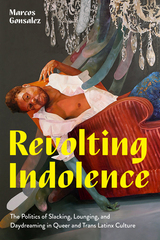 Revolting Indolence: The Politics of Slacking, Lounging, and Daydreaming in Queer and Trans Latinx Culture
Marcos Gonsalez
University of Texas Press, 2024 2025 Honorable Mention, John Leo & Dana Heller Award for Best Single Work, Anthology, Multi-Authored, or Edited Book in LGBTQ Studies, Popular Culture Association (PCA) How indolent practices in Latinx LGBTQ culture challenge capitalist imperatives to be productive. Revolting Indolence makes a case for laziness as an aesthetic-political strategy for countering the oppressive logics of cisheteronormative racial capitalism. Focusing on ways in which queer and trans Latinx people demonstrate the unwillingness of their participation in “productivist” ethics and allied respectability politics, Marcos Gonsalez argues that slacking off, lounging, daydreaming, and partying are liberatory practices—revolts that in turn are treated as revolting. Gonsalez explores how queer and trans Latinx artists refute discourses in which work is a moral good. In Paris Is Burning, RuPaul's Drag Race, documentary photography of queer and trans Latinx life in Los Angeles, and other sources, Gonsalez identifies two lazy styles: first, flagrant refusals of work that critique capitalist reason; and second, the invention of alternative aesthetic worlds beyond racial capitalism and violence targeting queer and trans people, whose rejection of the cisgender nuclear family paradigm is rightly seen as threatening the stability of a functioning capitalist system. Reclaiming laziness as a resource for radical imagining, Revolting Indolence asks us to do that which we want most and which capitalist exploitation can least tolerate: to slow down.
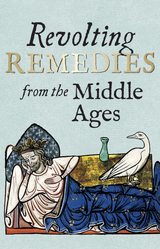 Revolting Remedies from the Middle Ages
Edited by Daniel Wakelin and compiled by students of the University of Oxford
Bodleian Library Publishing, 2017 For a zitty face: take urine eight days old and heat it over the fire; wash your face with it morning and night.
In late medieval England, ordinary people, apothecaries, and physicians gathered up practical medical tips for everyday use. While some were sensible herbal cures, many were weird and wildly inventive, prescribing elixirs and regimens for problems like how to make a woman love you and how to stop dogs from barking at you. The would-be doctors seemed oblivious to pain, and would recommend any animal, vegetable, or mineral, let alone bodily fluid, be ground up, smeared on, or inserted for medical benefit. Full of embarrassing ailments, painful procedures, icky ingredients, and bizarre beliefs, this book selects some of the most revolting and remarkable remedies from medieval manuscripts in the Bodleian Library. Written in the down-to-earth speech of the time, these remedies offer humorous insight into the strange ideas, ingenuity, and bravery of men and women in the Middle Ages, and a glimpse of the often gruesome history of medicine through time.
A Revolution Aborted: The Lessons of Grenada
Jorge Heine
University of Pittsburgh Press, 1990 Twelve essays address the political and cultural features of the Grenada experience, in light of the 1979 uprising that toppled Prime Minister Eric Gairy, and the subsequent U.S. invasion of 1983. The contributors discuss theoretical issues that go to the heart of dilemmas faced by many small, developing societies.
Revolution and Continuity
Peter Barker
Catholic University of America Press, 2018 This volume presents new work in history and historiography to the increasingly broad audience for studies of the history and philosophy of science. These essays are linked by a concern to understand the context of early modern science in its own context.
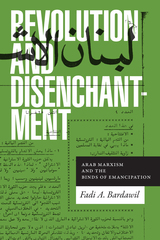 Revolution and Disenchantment: Arab Marxism and the Binds of Emancipation
Fadi A. Bardawil
Duke University Press, 2020 The Arab Revolutions that began in 2011 reignited interest in the question of theory and practice, imbuing it with a burning political urgency. In Revolution and Disenchantment Fadi A. Bardawil redescribes for our present how an earlier generation of revolutionaries, the 1960s Arab New Left, addressed this question. Bardawil excavates the long-lost archive of the Marxist organization Socialist Lebanon and its main theorist, Waddah Charara, who articulated answers in their political practice to fundamental issues confronting revolutionaries worldwide: intellectuals as vectors of revolutionary theory; political organizations as mediators of theory and praxis; and nonemancipatory attachments as impediments to revolutionary practice. Drawing on historical and ethnographic methods and moving beyond familiar reception narratives of Marxist thought in the postcolony, Bardawil engages in "fieldwork in theory" that analyzes how theory seduces intellectuals, cultivates sensibilities, and authorizes political practice. Throughout, Bardawil underscores the resonances and tensions between Arab intellectual traditions and Western critical theory and postcolonial theory, deftly placing intellectuals from those traditions into a much-needed conversation.
Revolution and Genocide: On the Origins of the Armenian Genocide and the Holocaust
Robert Melson
University of Chicago Press, 1992 In a study that compares the major attempts at genocide in world history, Robert Melson creates a sophisticated framework that links genocide to revolution and war. He focuses on the plights of Jews after the fall of Imperial Germany and of Armenians after the fall of the Ottoman as well as attempted genocides in the Soviet Union and Cambodia. He argues that genocide often is the end result of a complex process that starts when revolutionaries smash an old regime and, in its wake, try to construct a society that is pure according to ideological standards.
Revolution and Its Narratives: China's Socialist Literary and Cultural Imaginaries, 1949-1966
Cai Xiang
Duke University Press, 2016 Published in China in 2010, Revolution and Its Narratives is a historical, literary, and critical account of the cultural production of the narratives of China's socialist revolution. Through theoretical, empirical, and textual analysis of major and minor novels, dramas, short stories, and cinema, Cai Xiang offers a complex study that exceeds the narrow confines of existing views of socialist aesthetics. By engaging with the relationship among culture, history, and politics in the context of the revolutionary transformation of Chinese society and arts, Cai illuminates the utopian promise as well as the ultimate impossibility of socialist cultural production. Translated, annotated, and edited by Rebecca E. Karl and Xueping Zhong, this translation presents Cai's influential work to English-language readers for the first time.
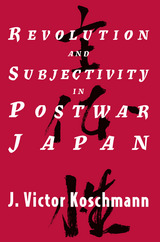 Revolution and Subjectivity in Postwar Japan
J. Victor Koschmann
University of Chicago Press, 1996 After World War II, Japanese intellectuals believed that world history was moving inexorably toward bourgeois democracy and then socialism. But who would be the agents—the active "subjects"—of that revolution in Japan? Intensely debated at the time, this question of active subjectivity influenced popular ideas about nationalism and social change that still affect Japanese political culture today.
In a major contribution to modern Japanese intellectual history, J. Victor Koschmann analyzes the debate over subjectivity. He traces the arguments of intellectuals from various disciplines and political viewpoints, and finds that despite their stress on individual autonomy, they all came to define subjectivity in terms of deterministic historical structures, thus ultimately deferring the possibility of radical change in Japan.
Establishing a basis for historical dialogue about democratic revolution, this book will interest anyone concerned with issues of nationalism, postcolonialism, and the formation of identities.
Revolution and the Multiclass Coalition in Nicaragua
Mark Everingham
University of Pittsburgh Press, 1996 This book tells the intriguing story of the multi-class coalition that formed to overthrow Somoza's Nicaraguan government in July of 1979. Mark Everingham offers personal accounts from members of the elite class, to determine the factors that led them to join the popular class in support of the Sandinista uprising.
 Revolution and World Politics: The Rise and Fall of the Sixth Great Power
Fred Halliday
Duke University Press, 1999 Revolutions, as much as international war or nationalism, have shaped the development of world politics. In cause, ideology, and consequence they have merited description as a “sixth great power” alongside the dominant nations. In Revolution and World Politics Fred Halliday reassesses the role of revolution from the French Revolution to the Iranian Revolution and the collapse of communism.
Halliday begins by tracing the origins and evolution of the modern concept of “revolution” and placing it in historical context. Arguing that revolution is central to any understanding of international relations, he examines the internationalist ideology of revolutionaries who are committed to promoting change elsewhere by exposing revolution. In contrast with the claims of revolutionaries and counterrevolutionaries alike, he sees revolutions both as part of an internationalist social conflict and as a challenge to the system of states. Chapters on the distinct foreign policies of revolutionary states are followed by discussions of war, counterrevolution, and postrevolutionary transformation. The study concludes with a reassessment of the place of revolution within international relations theory and in modern history, drawing out implications for their incidence and character in the twenty-first century.
Students and scholars of international relations, political science, sociology, and history will value this major contribution to understanding worldwide developments in government and society.
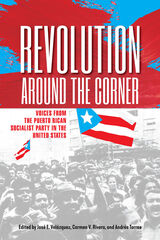 Revolution Around the Corner: Voices from the Puerto Rican Socialist Party in the U.S.
Edited by José E. Velázquez, Carmen V. Rivera, and Andrés Torres
Temple University Press, 2021 Active from the late 1960s until the mid-1990s, the U.S. branch of the Puerto Rican Socialist Party (PSP) worked simultaneously to build support for Puerto Rican independence and to engage in radical social change within the United States. Revolution Around the Corner chronicles this unique social movement, describing various mass campaigns and the inner workings of the organization. The editors and contributors—all former members, leaders, and supporters of the PSP—offer a range of views and interpretations of their experience. Combining historical accounts, personal stories, interviews, and retrospective analysis, Revolution Around the Corner examines specific actions such as the National Day of Solidarity (El Acto Nacional), the Bicentennial without Colonies, the Save Hostos struggle, and the Vieques campaign. Testimonies recount the pros and cons of membership diversity, as well as issues of loyalty and compañerismo. In addition, essays describe the PSP’s participation in coalitions and alliances with Left and progressive movements. The book concludes with the editors’ reflections on the PSP’s achievements, mistakes, and contributions.
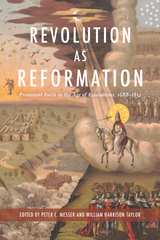 Revolution as Reformation: Protestant Faith in the Age of Revolutions, 1688–1832
Edited by Peter C. Messer and William Harrison Taylor
University of Alabama Press, 2021 Essays that explore how Protestants responded to the opportunities and perils of revolution in the transatlantic age
Revolution as Reformation: Protestant Faith in the Age of Revolutions, 1688–1832 highlights the role that Protestantism played in shaping both individual and collective responses to revolution. These essays explore the various ways that the Protestant tradition, rooted in a perpetual process of recalibration and reformulation, provided the lens through which Protestants experienced and understood social and political change in the Age of Revolutions. In particular, they call attention to how Protestants used those changes to continue or accelerate the Protestant imperative of refining their faith toward an improved vision of reformed religion.
The editors and contributors define faith broadly: they incorporate individuals as well as specific sects and denominations, and as much of “life experience” as possible, not just life within a given church. In this way, the volume reveals how believers combined the practical demands of secular society with their personal faith and how, in turn, their attempts to reform religion shaped secular society.
The wide-ranging essays highlight the exchange of Protestant thinkers, traditions, and ideas across the Atlantic during this period. These perspectives reveal similarities between revolutionary movements across and around the Atlantic. The essays also emphasize the foundational role that religion played in people’s attempts to make sense of their world, and the importance they placed on harmonizing their ideas about religion and politics. These efforts produced novel theories of government, encouraged both revolution and counterrevolution, and refined both personal and collective understandings of faith and its relationship to society.
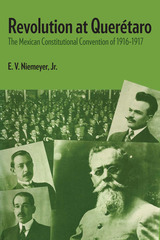 Revolution at Querétaro: The Mexican Constitutional Convention of 1916–1917
By E. V. Niemeyer, Jr.
University of Texas Press, 1974 In two of the most fateful months of Mexican history, the delegates to the Constitutional Convention of 1916–1917 came to grips with the basic problem of twentieth-century Mexico. They hammered out pragmatic solutions to establish the legal foundations of the Mexican Revolution, the definitive break between the old Mexico and the new, the constitutional bases for the socioeconomic changes from 1917 onward. Honored and obeyed, dishonored and disobeyed, many times amended, the constitution they wrote still serves as the instrument for achieving the national purpose. Revolution at Querétaro is the first book in English to study in depth the remarkable convention that produced the Constitution of 1917. It chronicles the unfolding of ideas expressed in the debates on the most significant articles of the constitution, those that have given it a revolutionary flavor and have served the groundwork for the emergence of Mexico as a modern nation. These articles concern the Catholic church and its role in the sphere of education (Article 3); the relationship of the church to the state (Articles 24 and 130); the attack on vested interest and the establishment of guidelines for agrarian reform (Article 27); the drafting of a detailed labor code (Article 123); and attempts to implement municipal reform (Article 114). Other debates described in the book concern unsuccessful attempts to institute prohibition, outlaw bullfights, abolish capital punishment, and grant suffrage to women. This study also sheds light on the delegates themselves, who they were and where they came from, their idiosyncrasies and attitudes, and their individual contributions to the writing of the constitution. Much material is taken from unpublished albums in which the delegates recorded their sentiments during the convention.
Revolution at the Checkout Counter: The Explosion of the Bar Code
Stephen A. Brown
Harvard University Press, 1997 The Universal Product Code (U.P.C.)—a small rectangle of black and white bars—adorns virtually every retail item we purchase. Yet twenty-five years ago, the U.P.C. was a mere kernel of an idea shared by a small cadre of manufacturing and chain store executives. Here Stephen Brown, the legal counsel of those pioneering executives, traces its origin and evolution.
The development of the U.P.C. illustrates the process of setting industry standards without government intervention and shows how systems of complementary technologies evolve. The economic consequences of the U.P.C. are investigated in an introduction by Professor John T. Dunlop and Jan Rivkin.
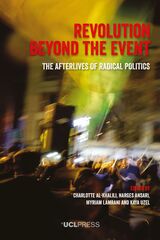 Revolution Beyond the Event: The Afterlives of Radical Politics
Edited by Charlotte Al-Khalili, Narges Ansari, Myriam Lamrani, and Kaya Uzel
University College London, 2023 A critical perspective on the lived realities of revolutionary afterlives.
Revolution Beyond the Event brings together leading international anthropologists and emerging scholars to examine revolutionary legacies from the MENA region, Latin America, and the Caribbean. It explores the idea that revolutions have varied afterlives that complicate the assumptions about their duration, pace, and progression, and argues that a renewed focus on the temporality of radical politics is essential to our understanding of revolution. Through a careful selection of case studies, the book provides a critical perspective on the lived realities of revolutionary afterlives, challenging the liberal humanist assumptions implicit in the modern idea of revolution and reappraising the political agency of people caught up in revolutionary situations across a variety of ethnographic contexts.
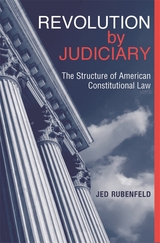 Revolution by Judiciary: The Structure of American Constitutional Law
Jed Rubenfeld
Harvard University Press, 2005 Although constitutional law is supposed to be fixed and enduring, its central narrative in the twentieth century has been one of radical reinterpretation--Brown v. Board of Education, Roe v. Wade, Bush v. Gore. What, if anything, justifies such radical reinterpretation? How does it work doctrinally? What, if anything, structures it or limits it?
Jed Rubenfeld finds a pattern in American constitutional interpretation that answers these questions convincingly. He posits two different understandings of how constitutional rights would apply or not apply to particular legislation. One is that a right would be violated if certain laws were passed. The other is that a right would not be violated. He calls the former "Application Understandings" and the latter "No-Application Understandings." He finds that constitutional law has almost always adhered to all of the original Application Understandings, but where it has departed from history, as it did in the Brown decision, it has departed from No-Application Understandings. Specifically, the Fourteenth Amendment did not prohibit racial segregation, so Rubenfeld argues that the Supreme Court had no problem reinterpreting it to prohibit it. It was a No-Application Understanding.
This is a powerful argument that challenges current theories of constitutional interpretation from Bork to Dworkin. It rejects simplistic originalism, but restores historicity to constitutional theorizing.
|
|

